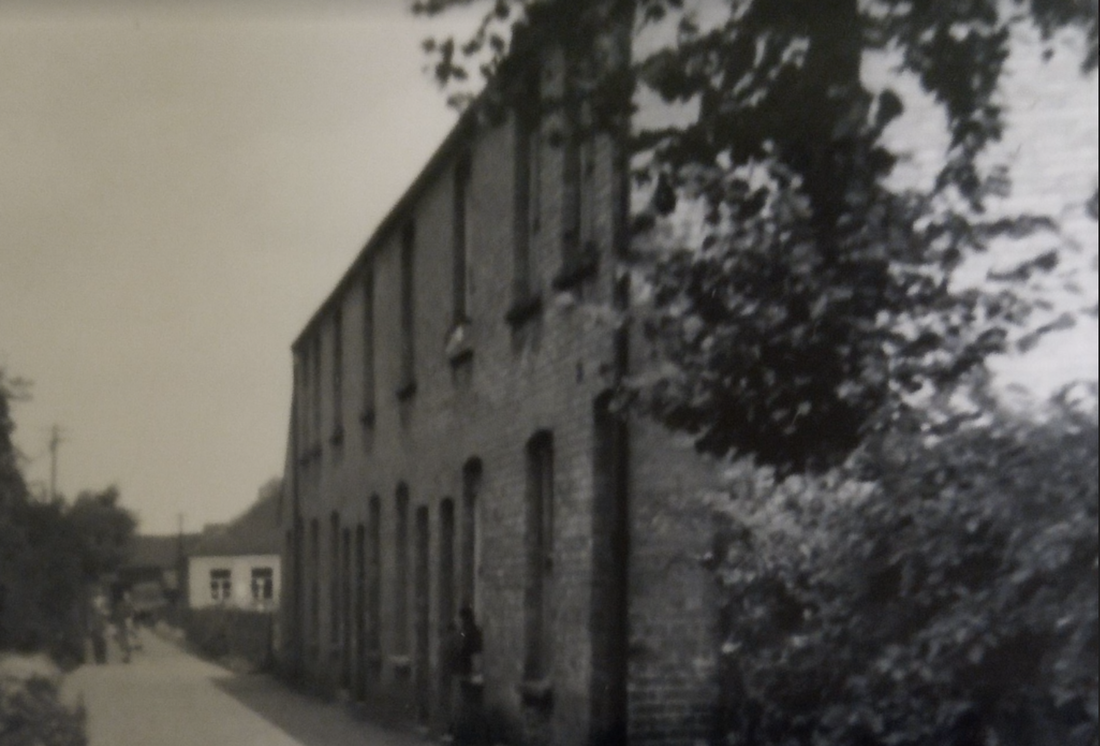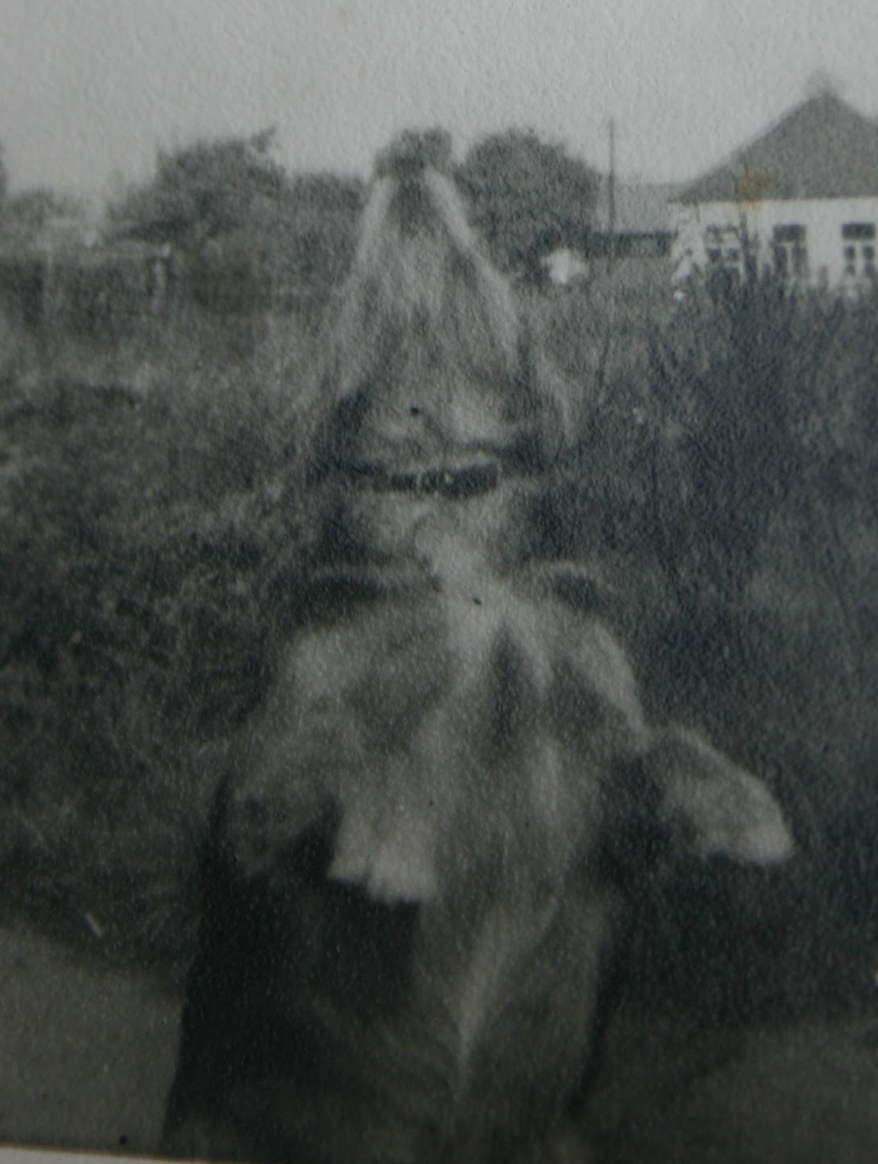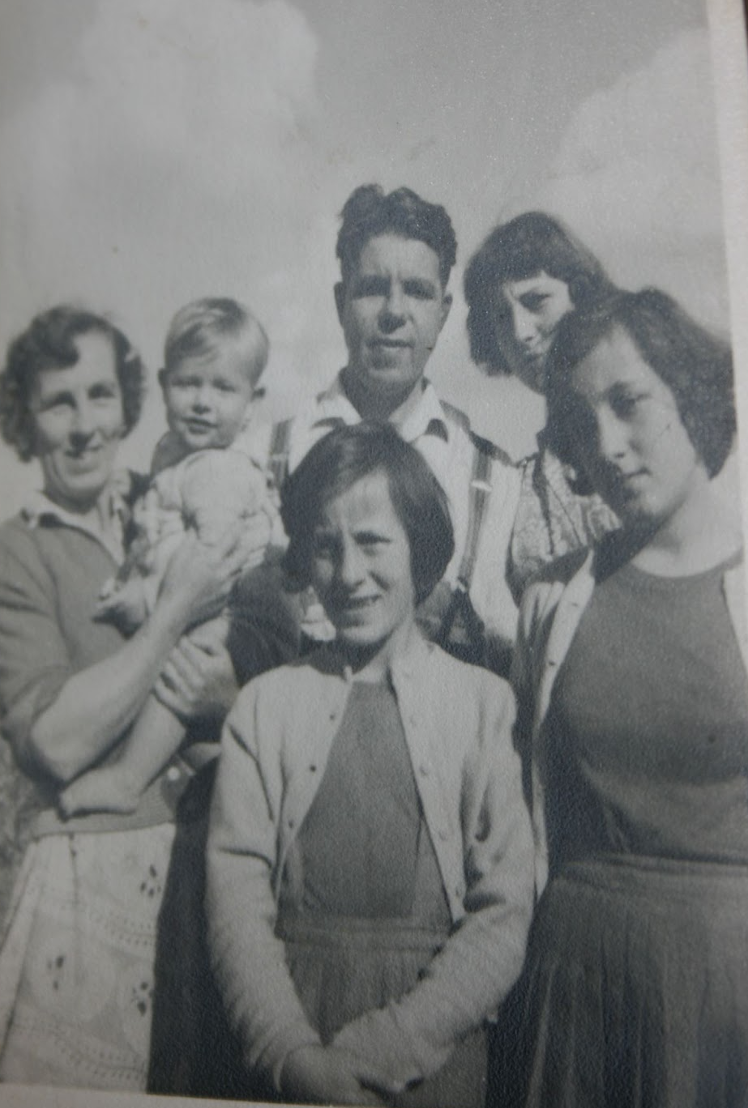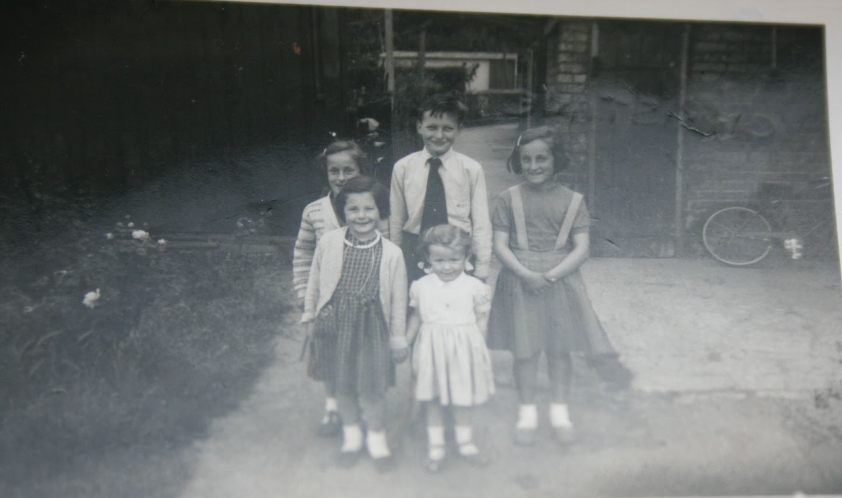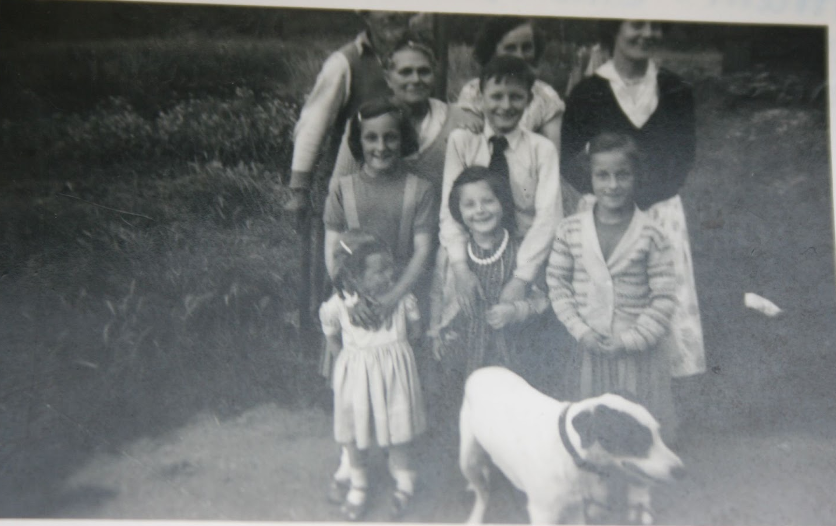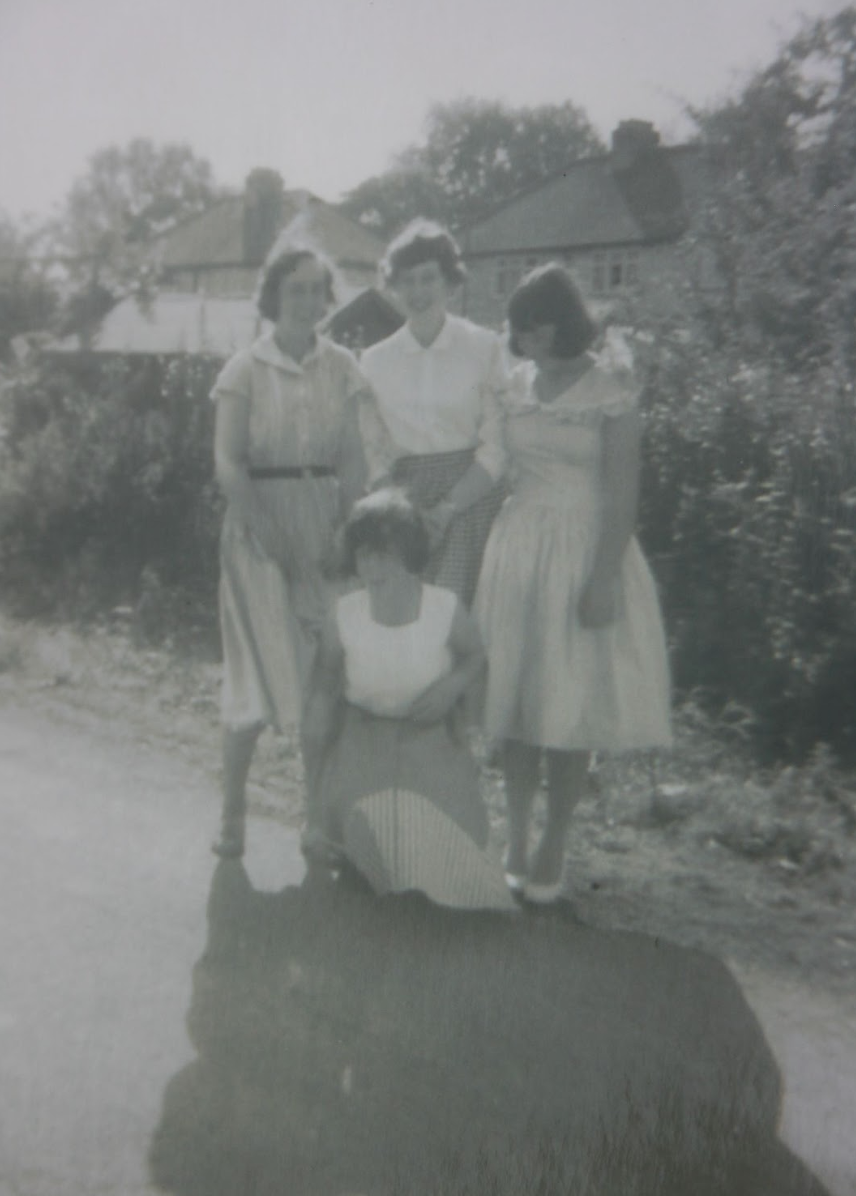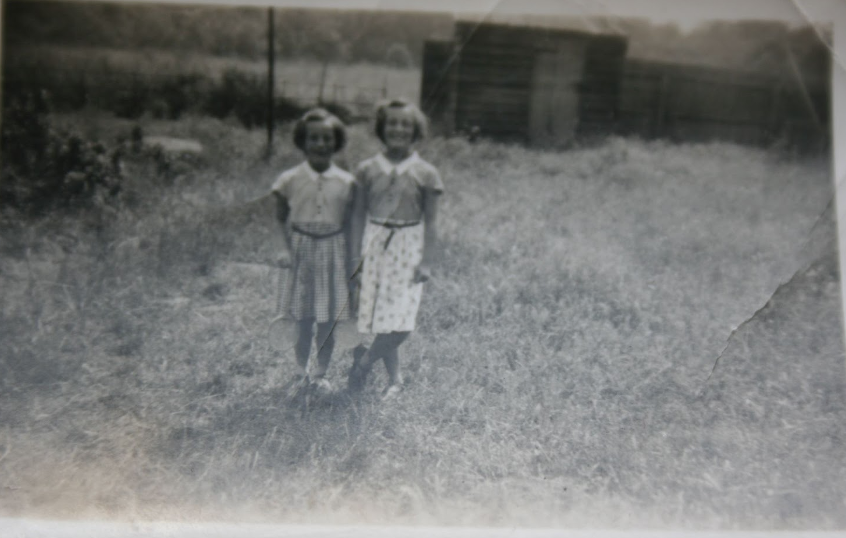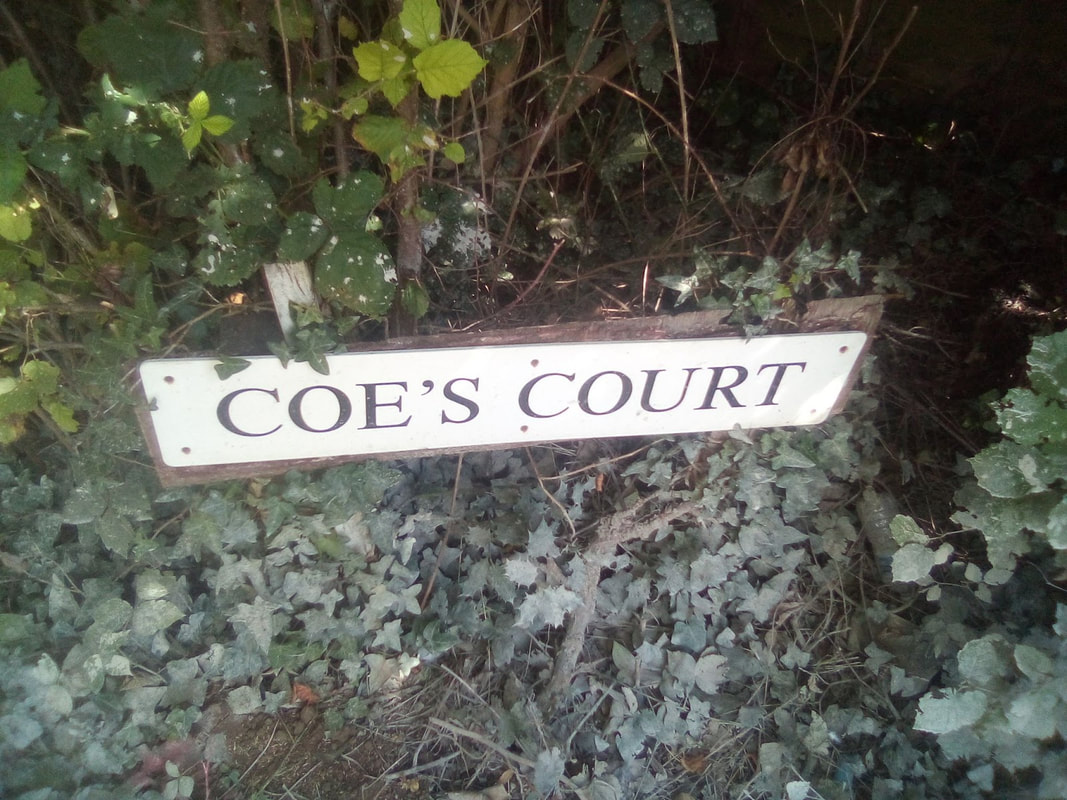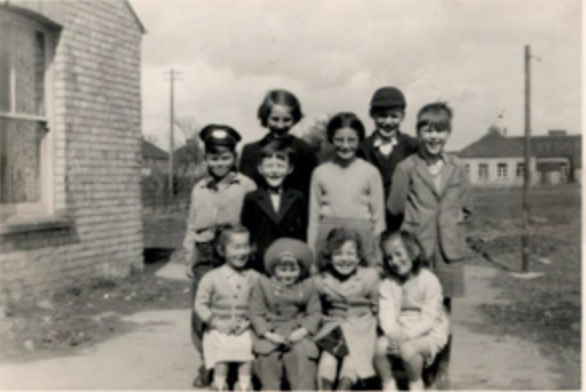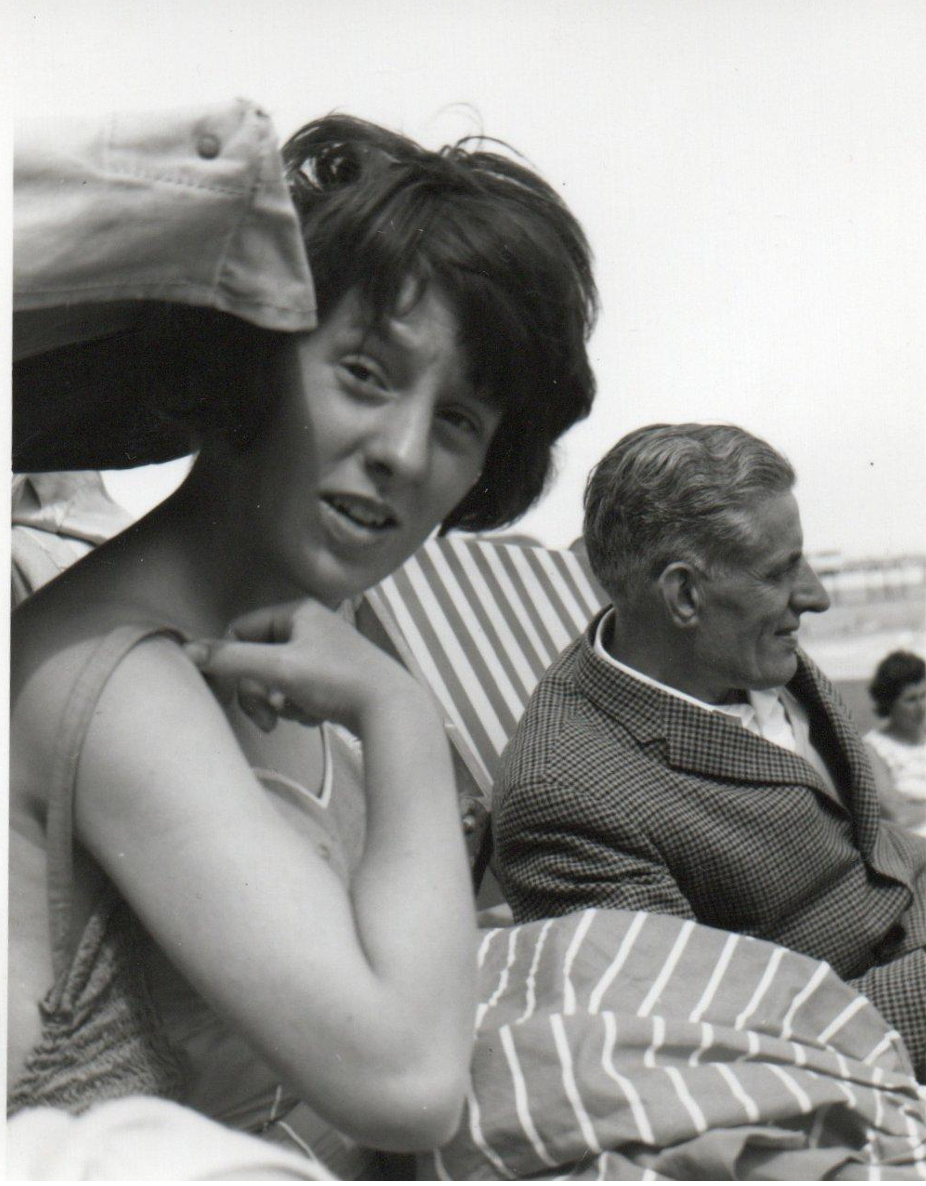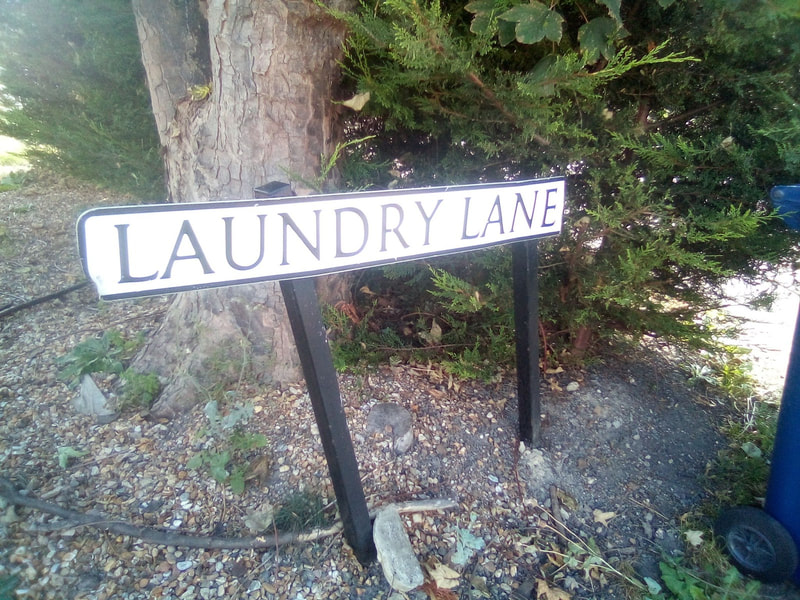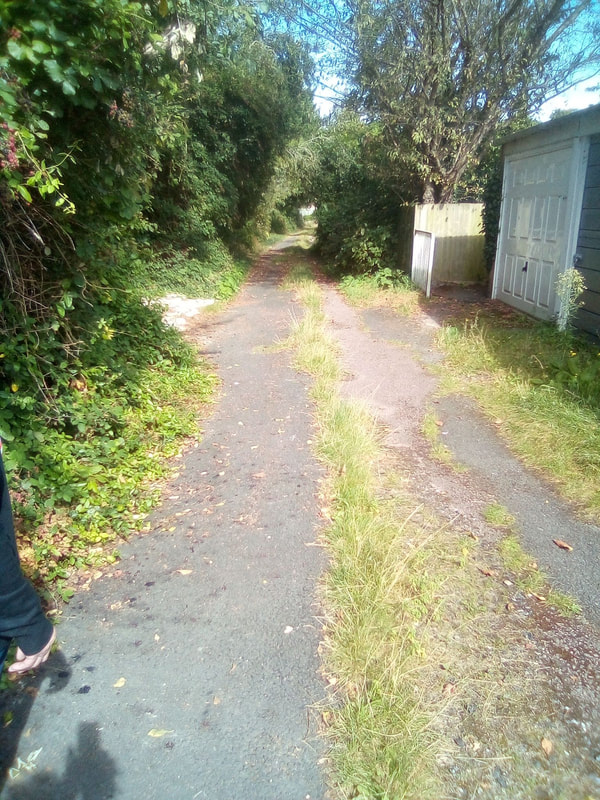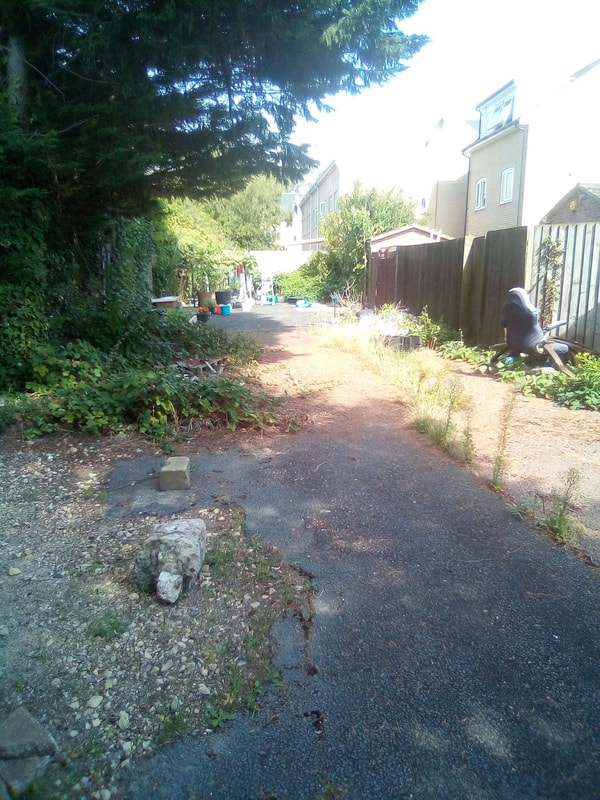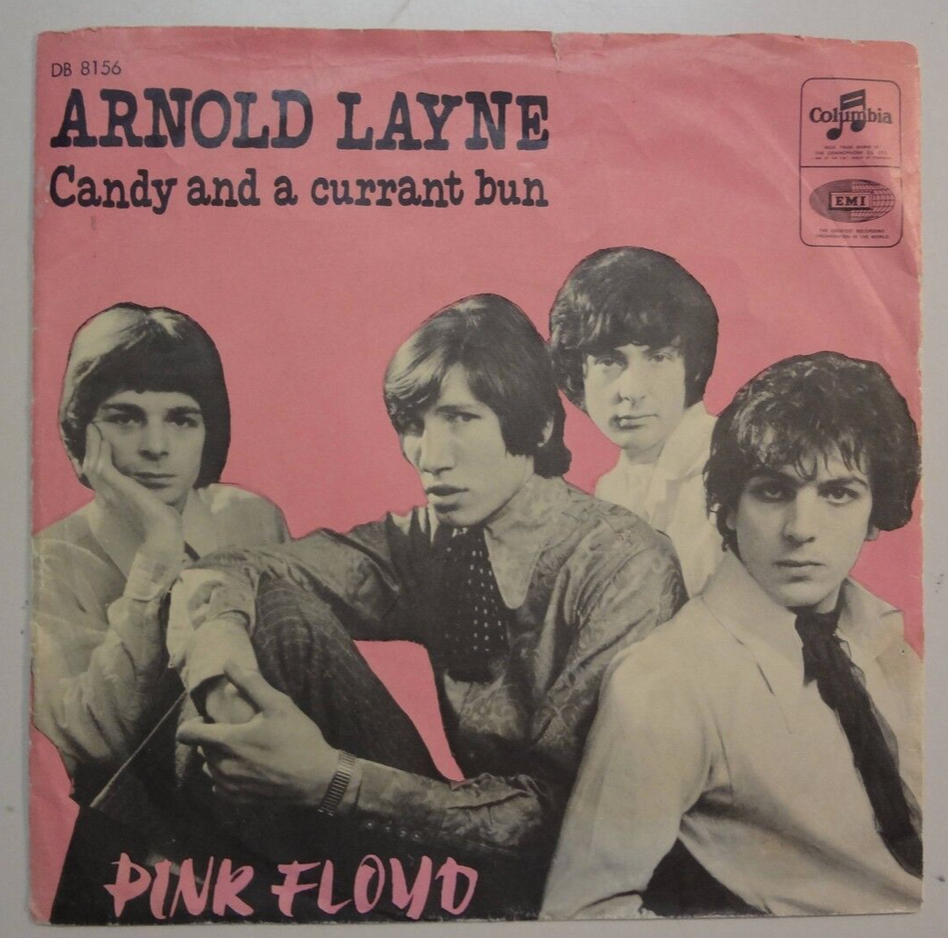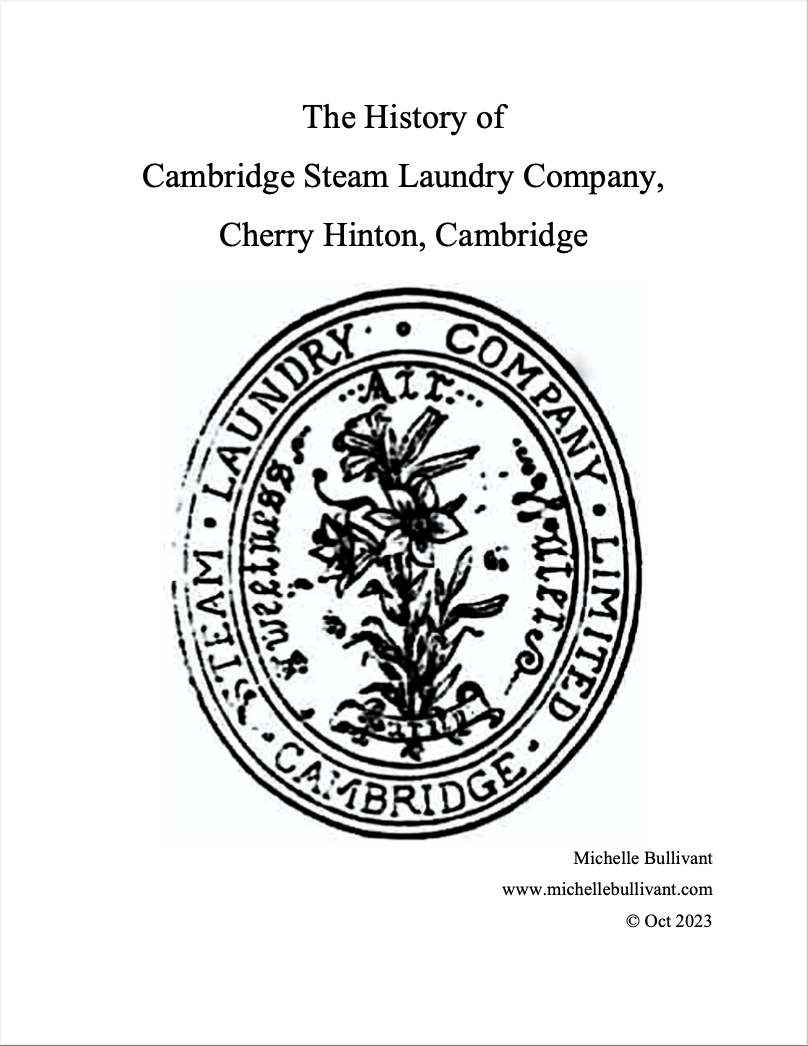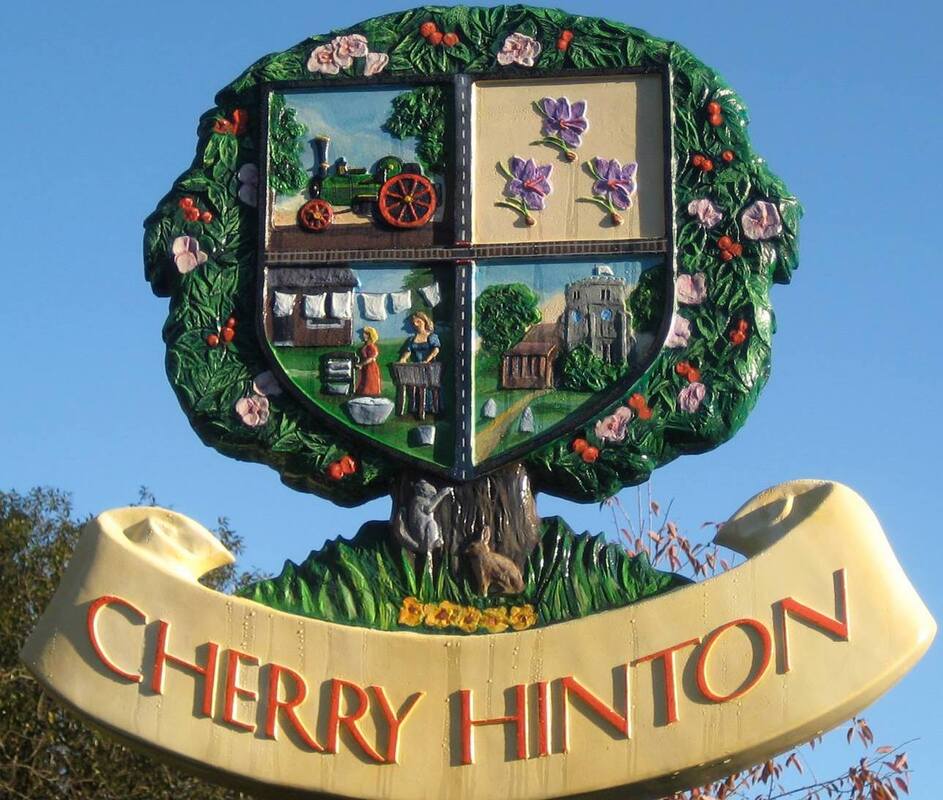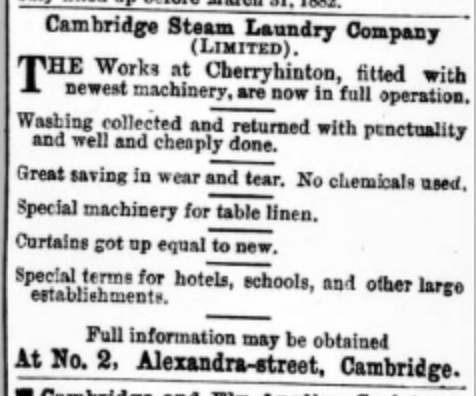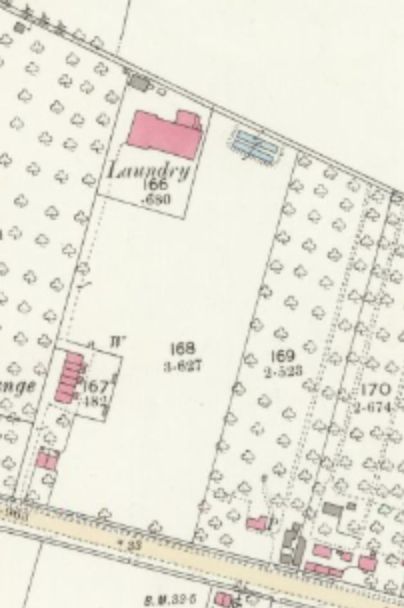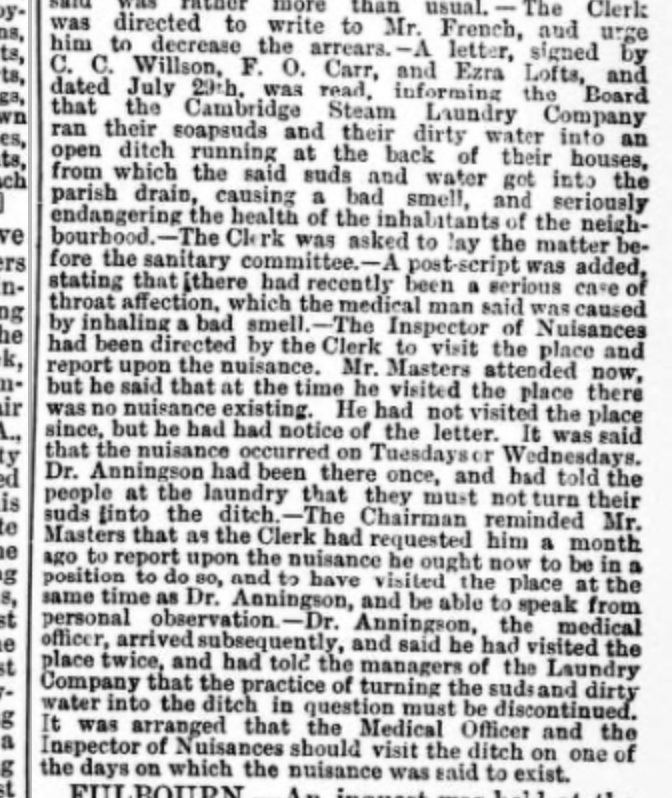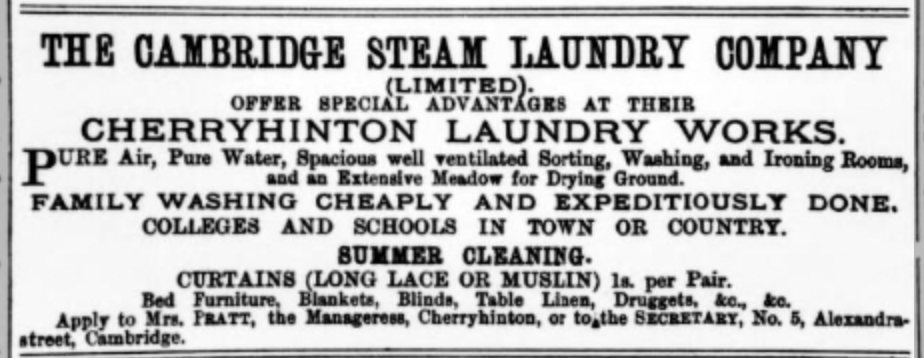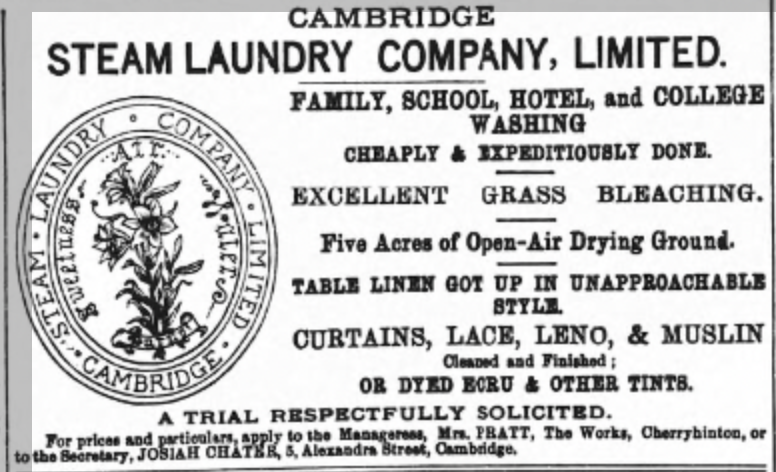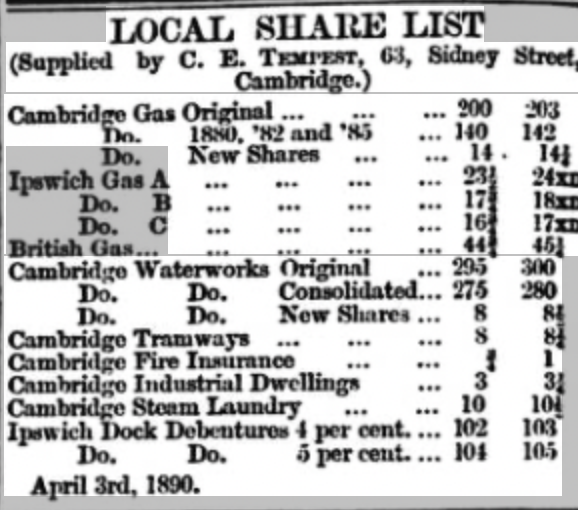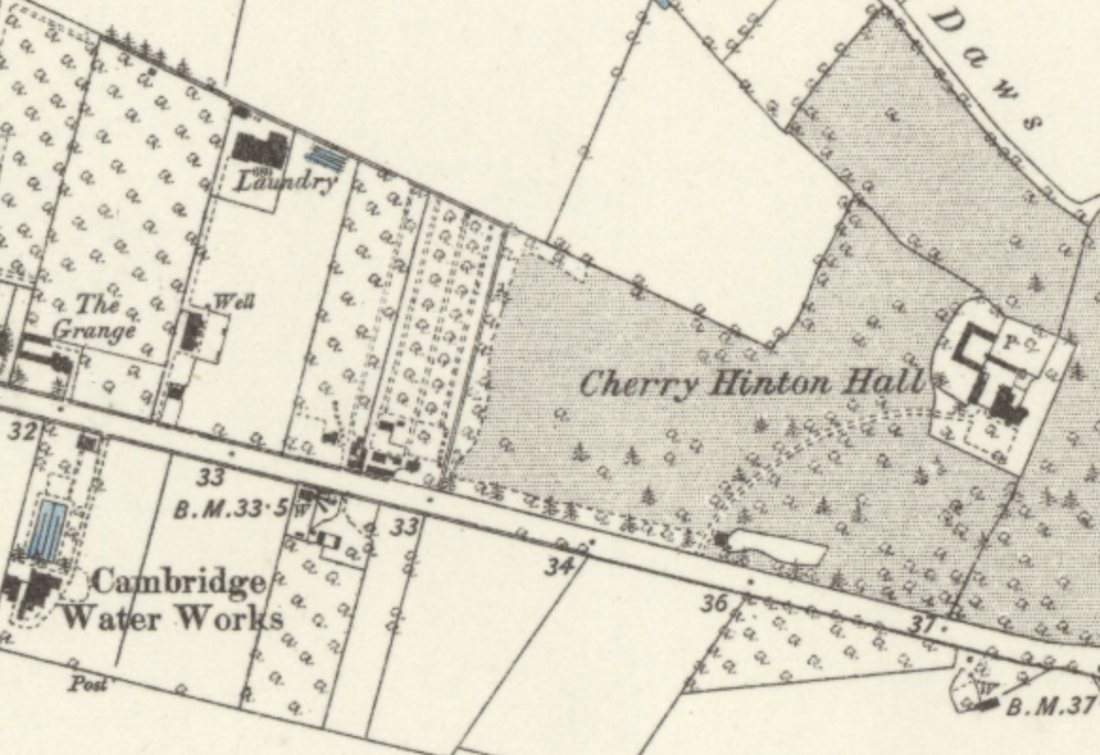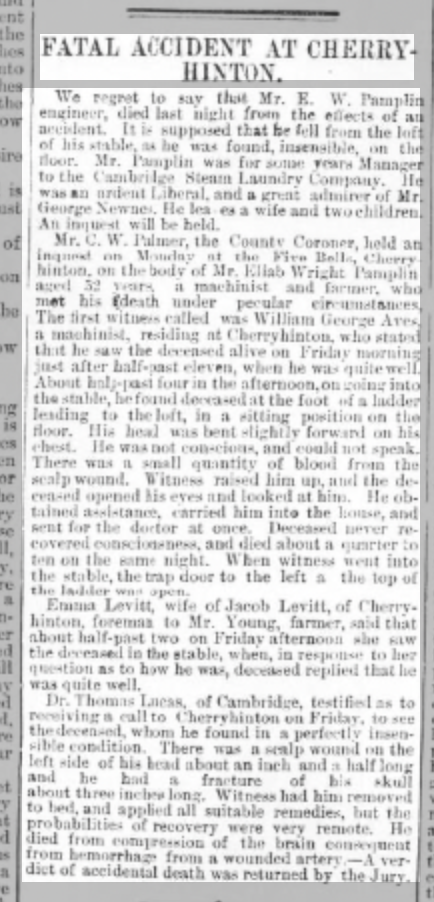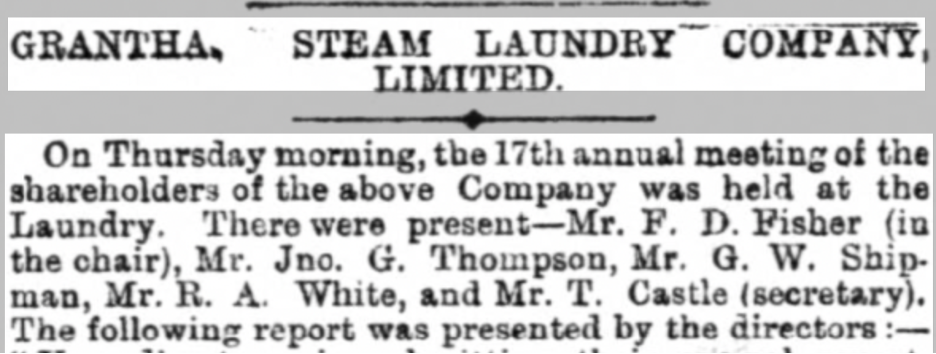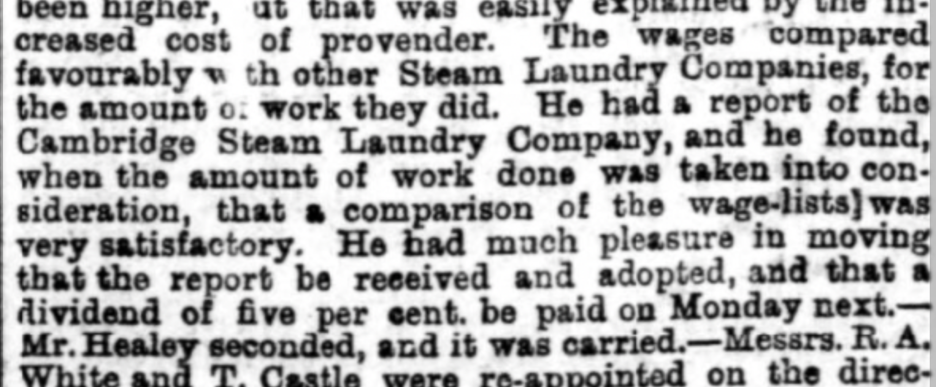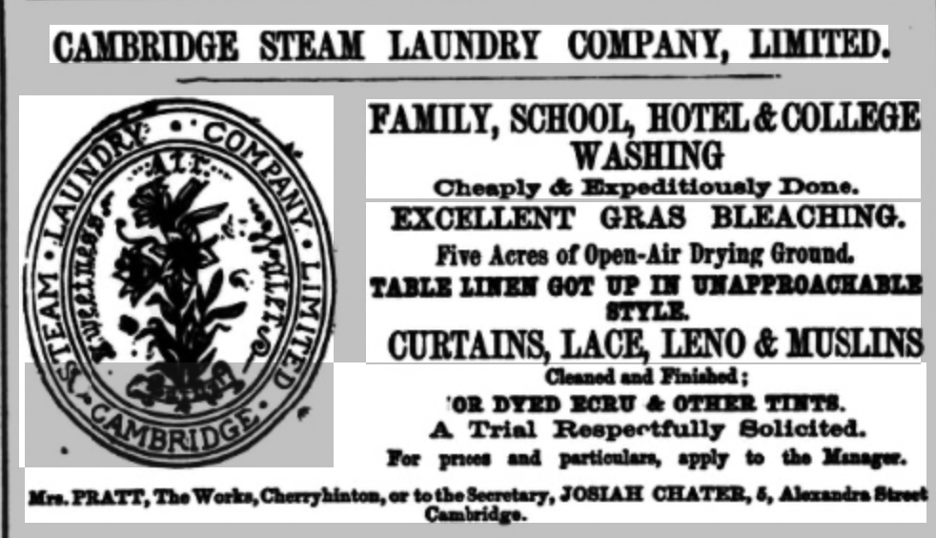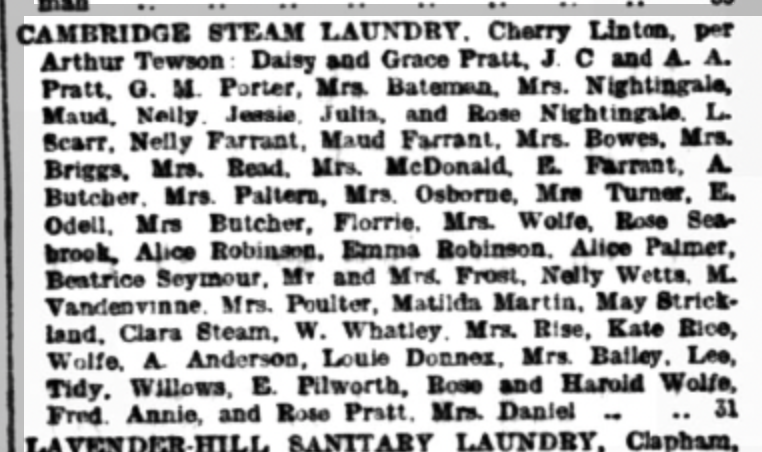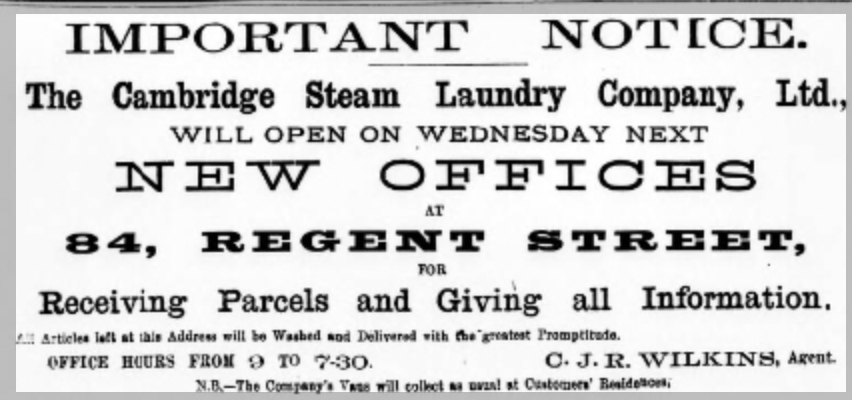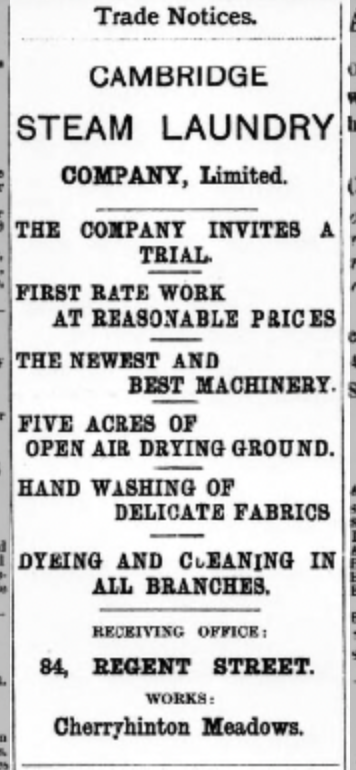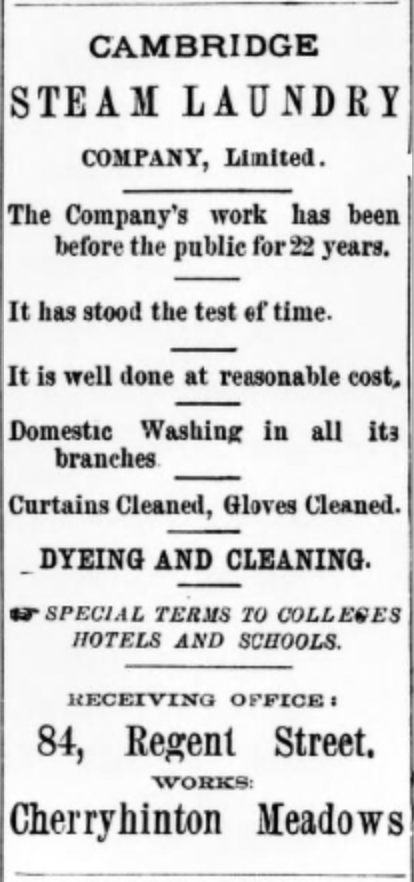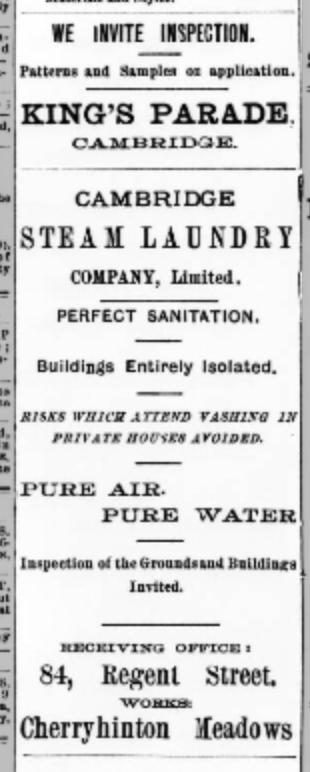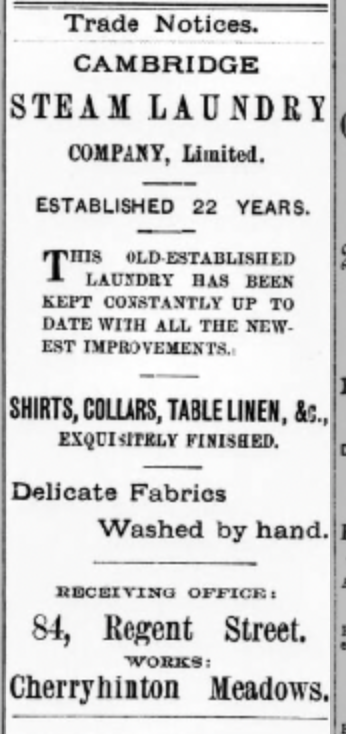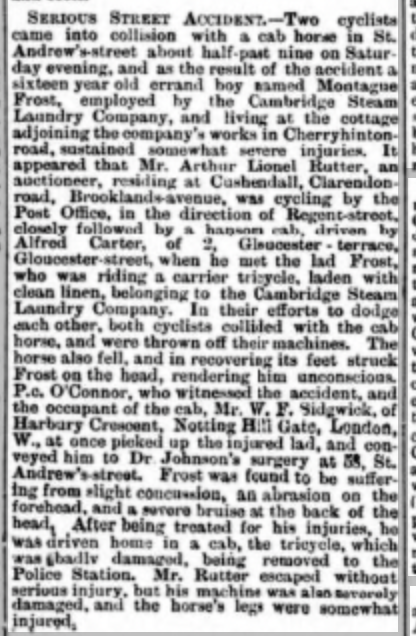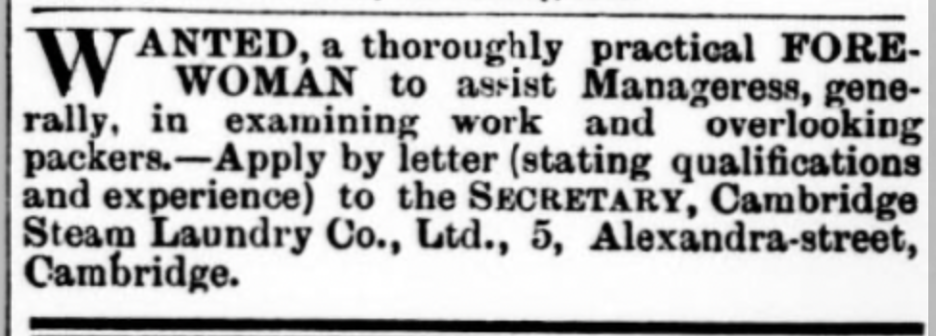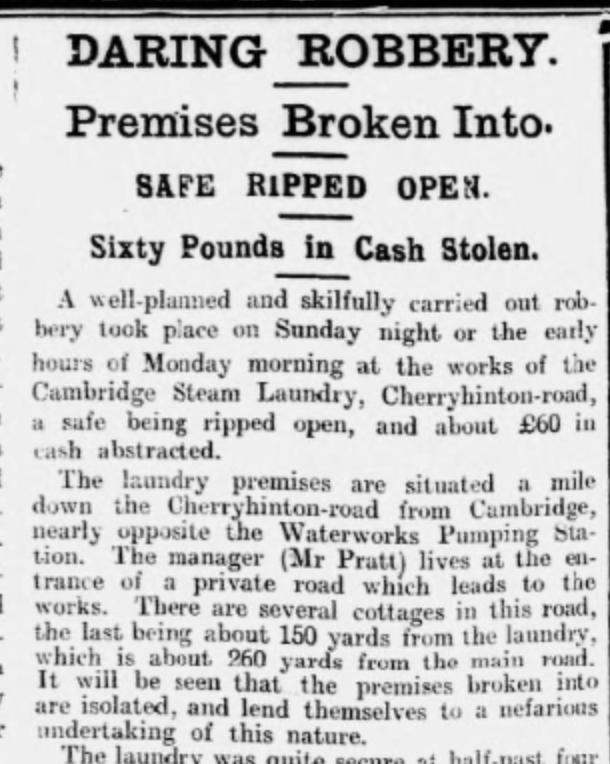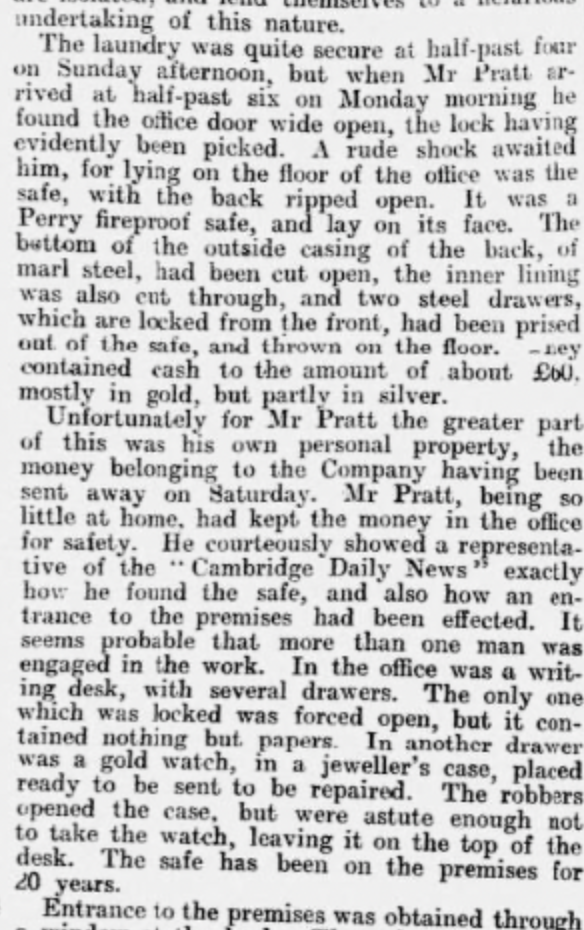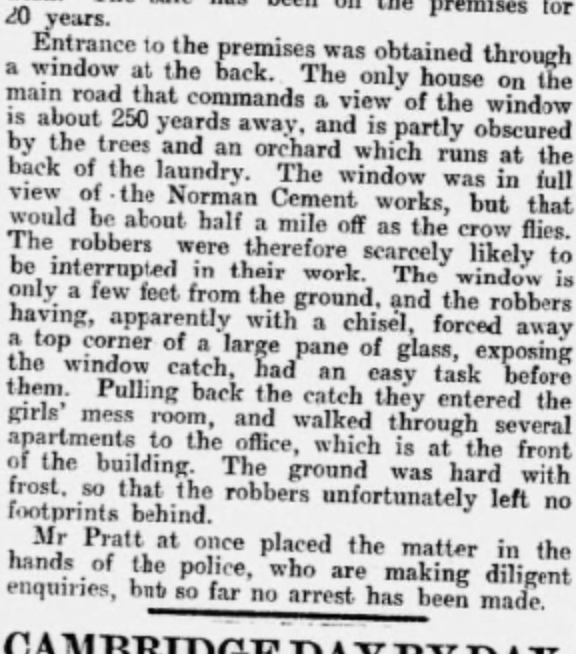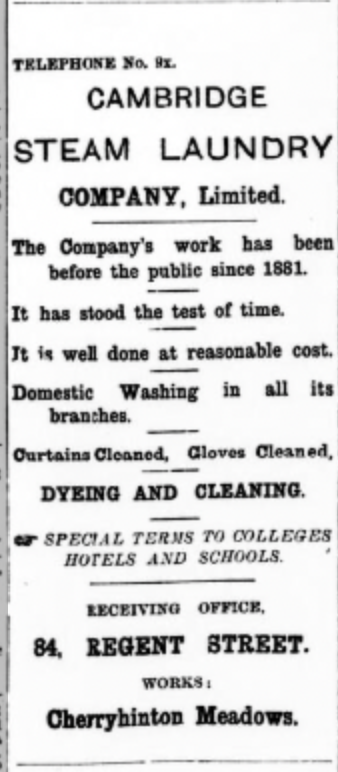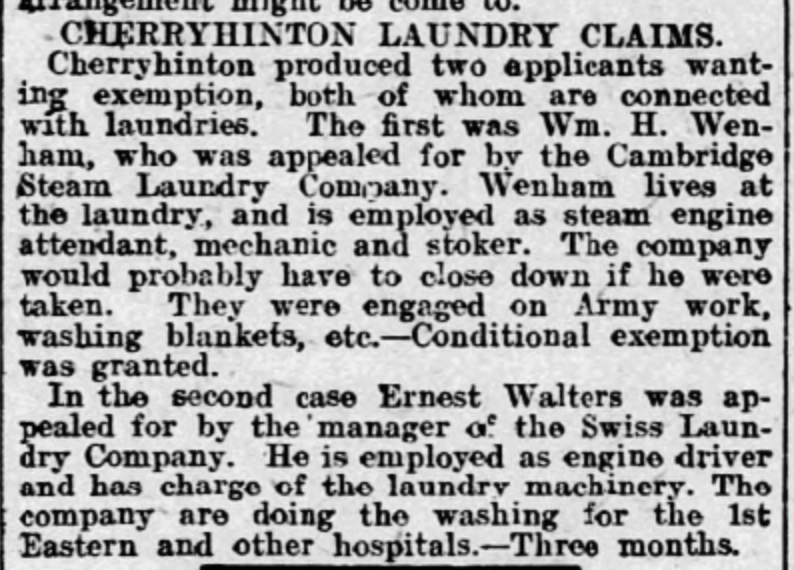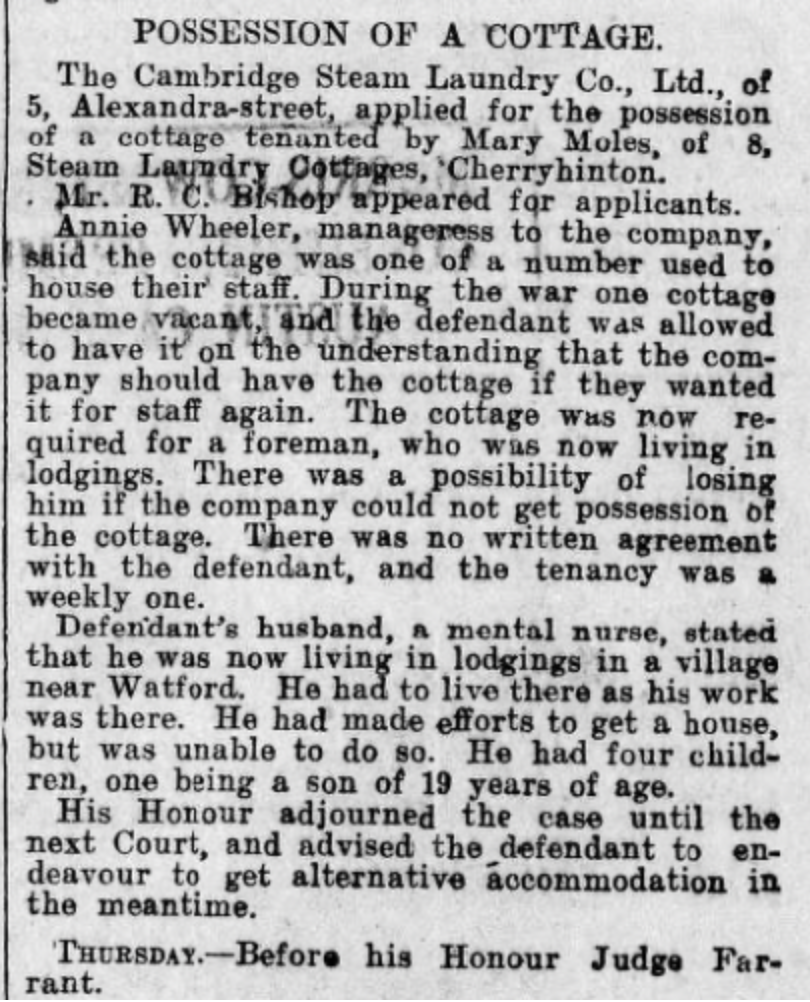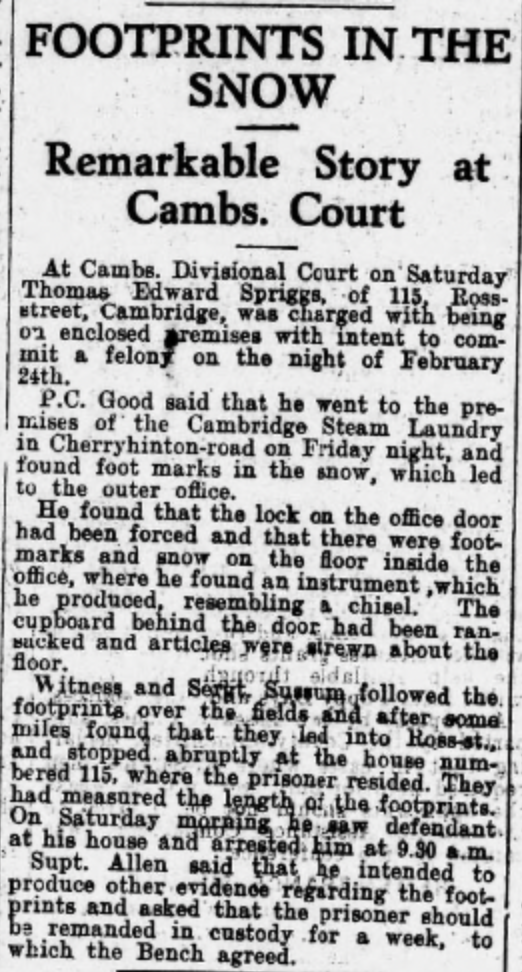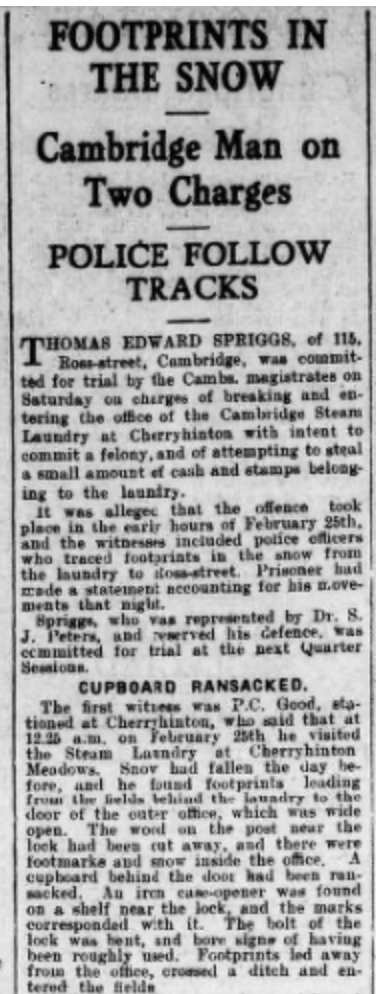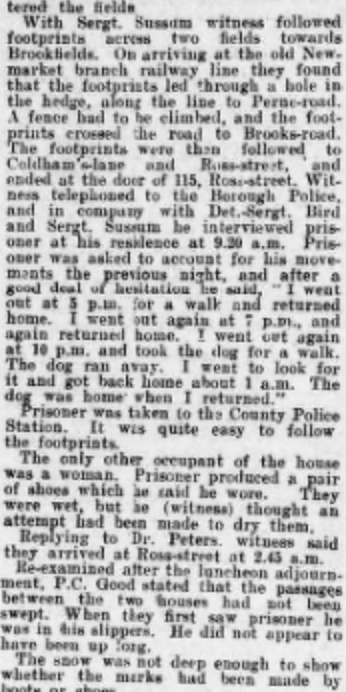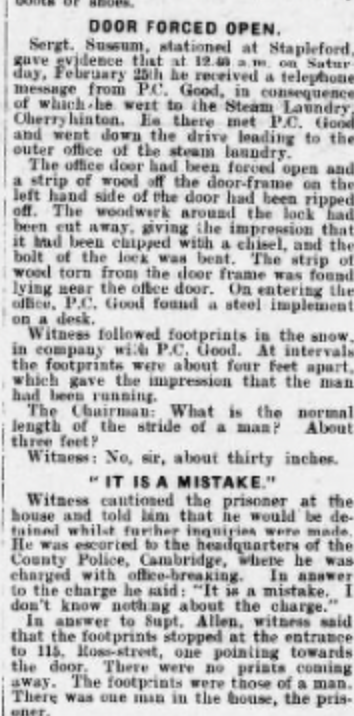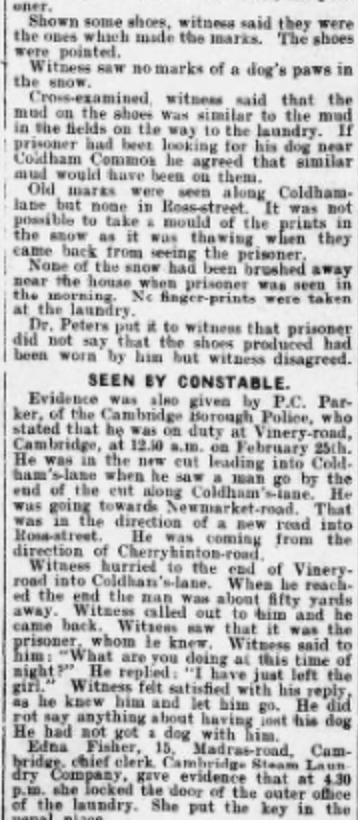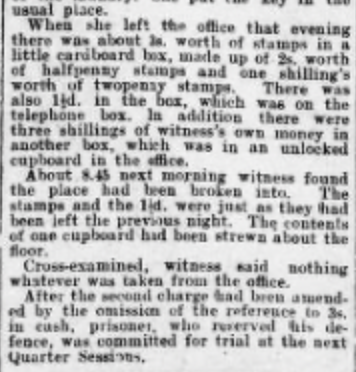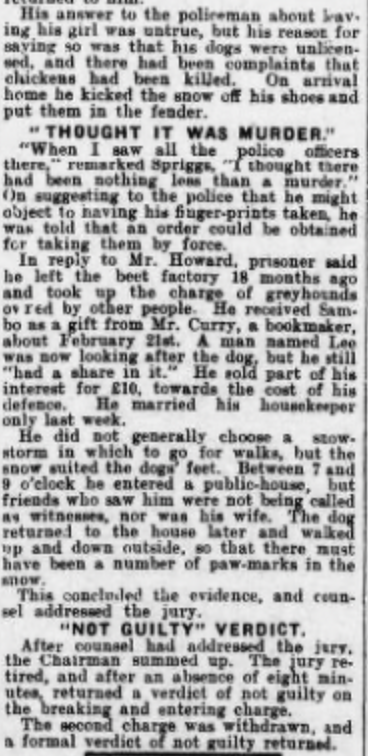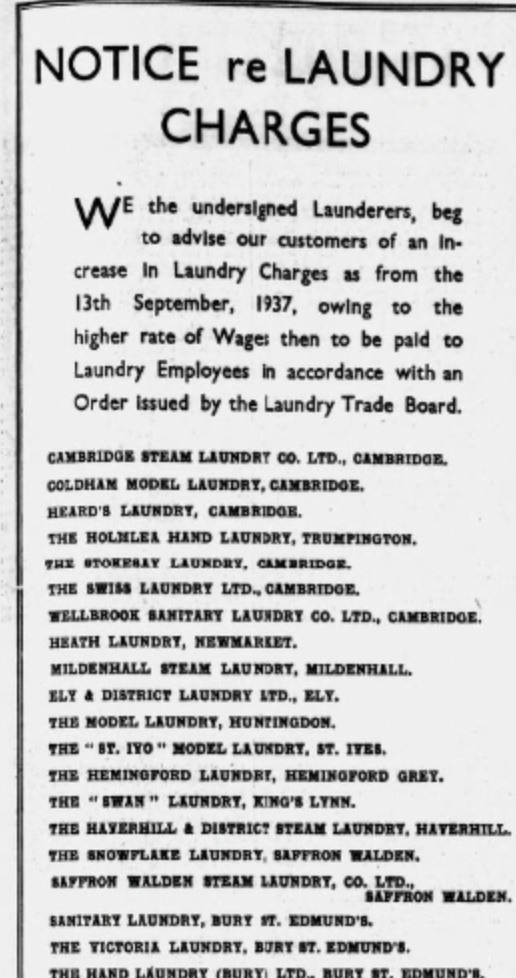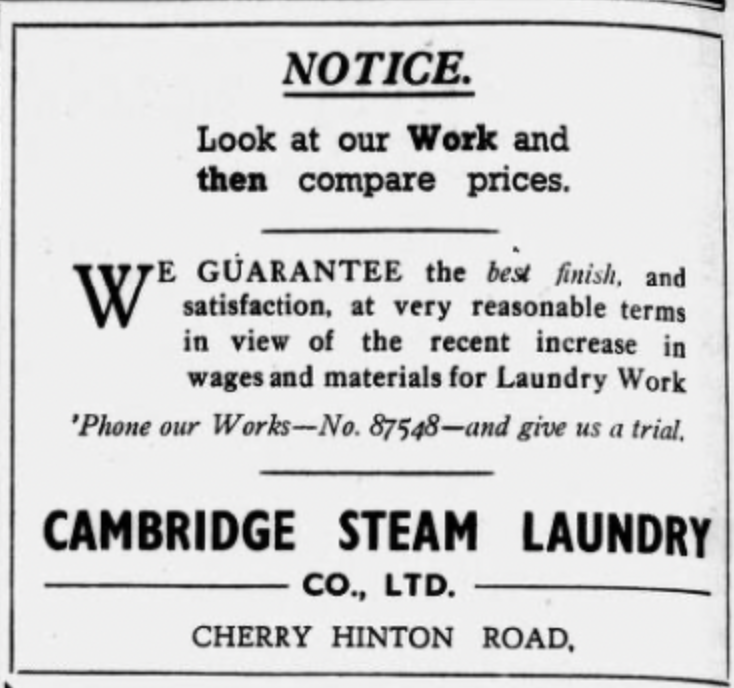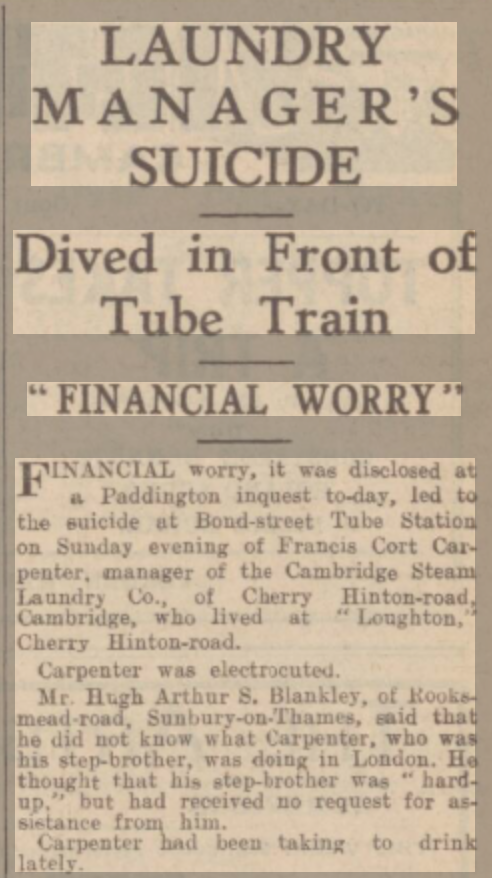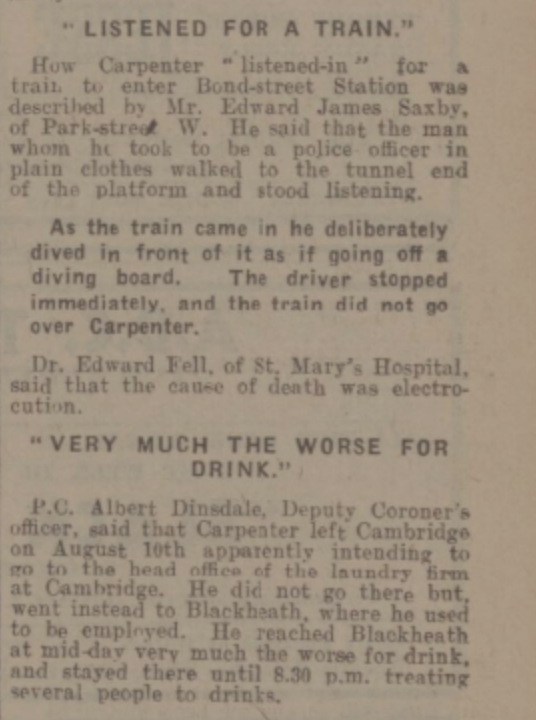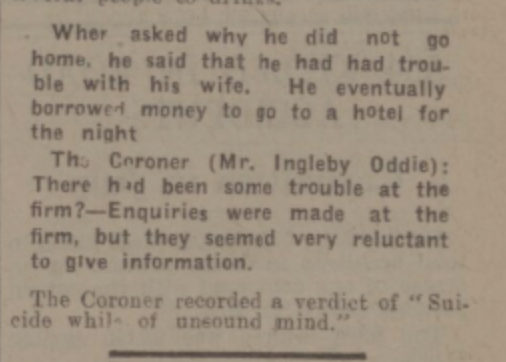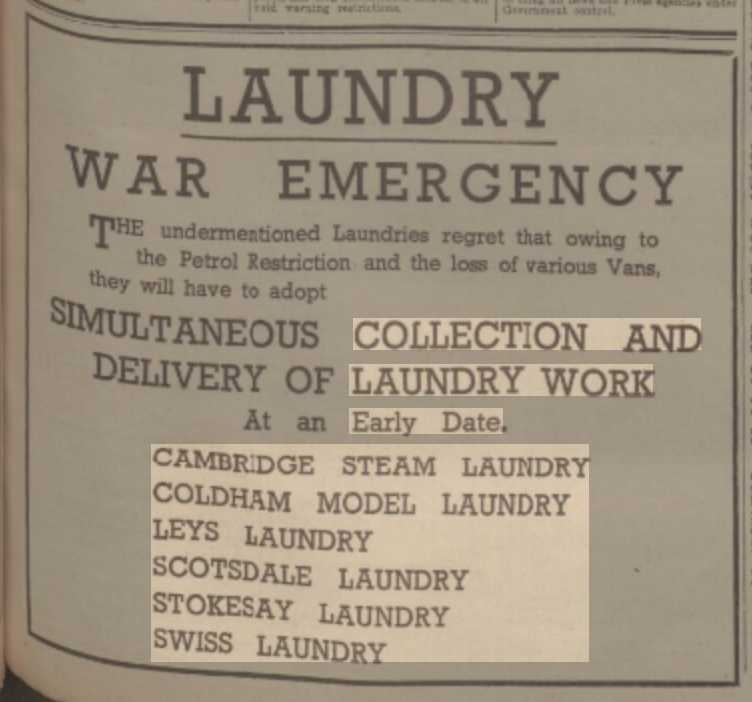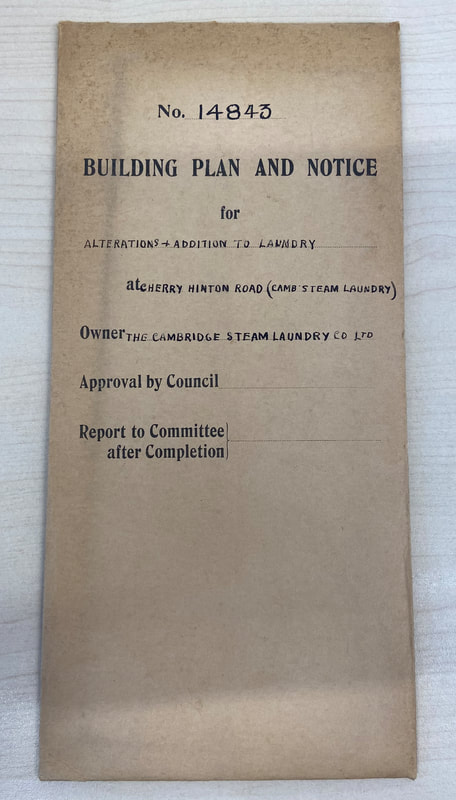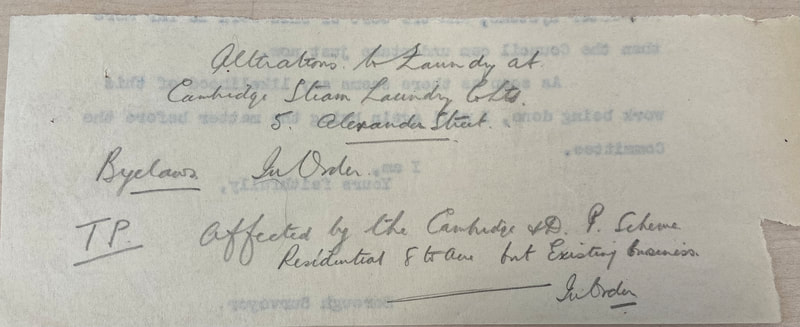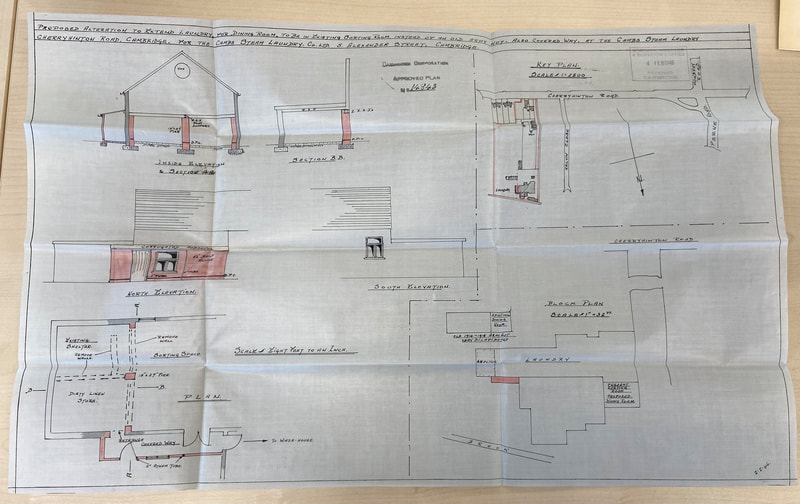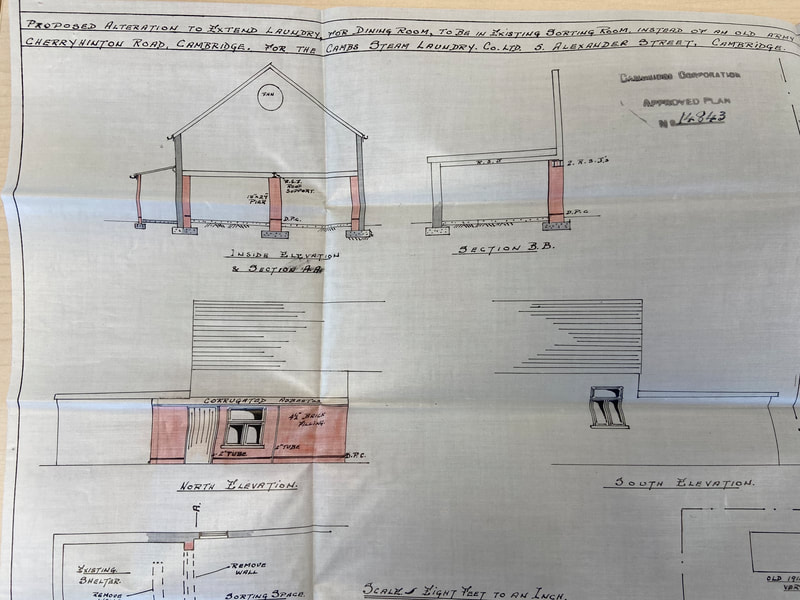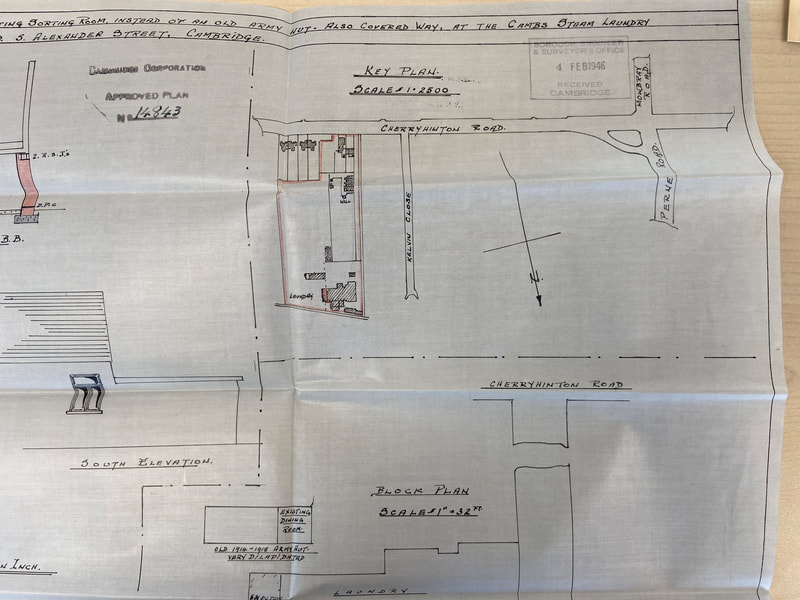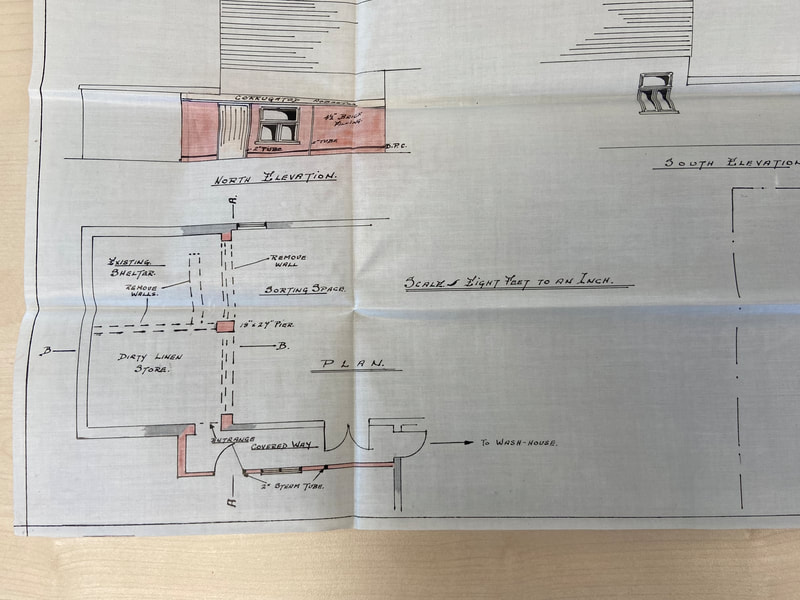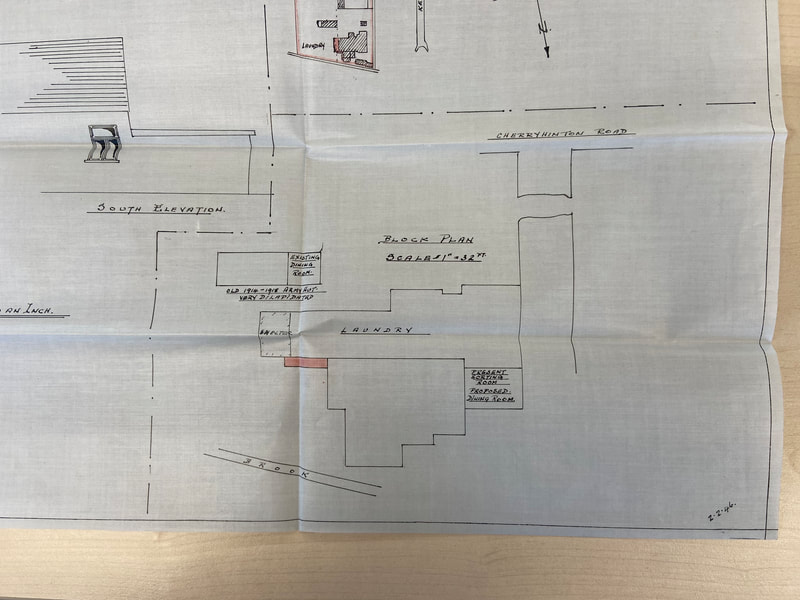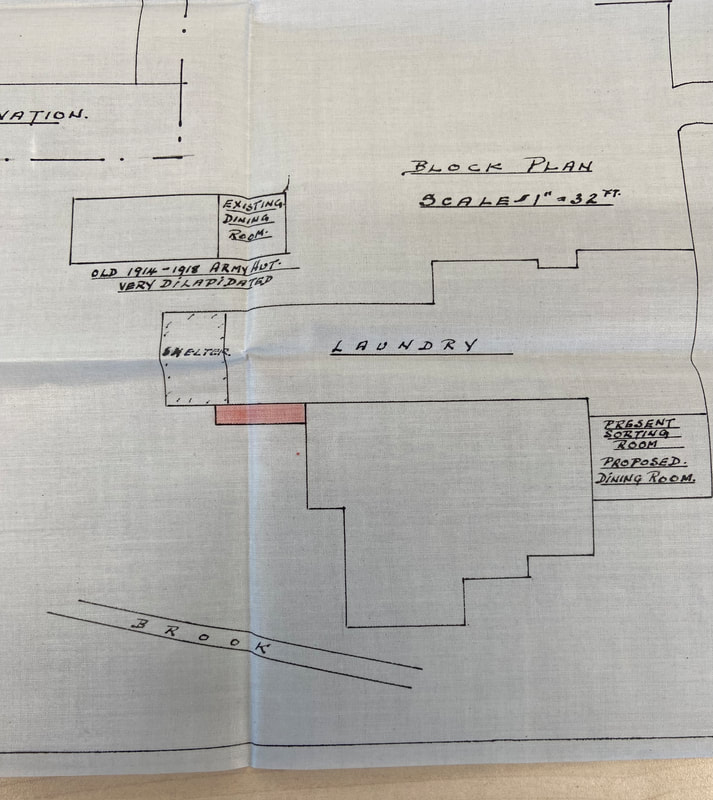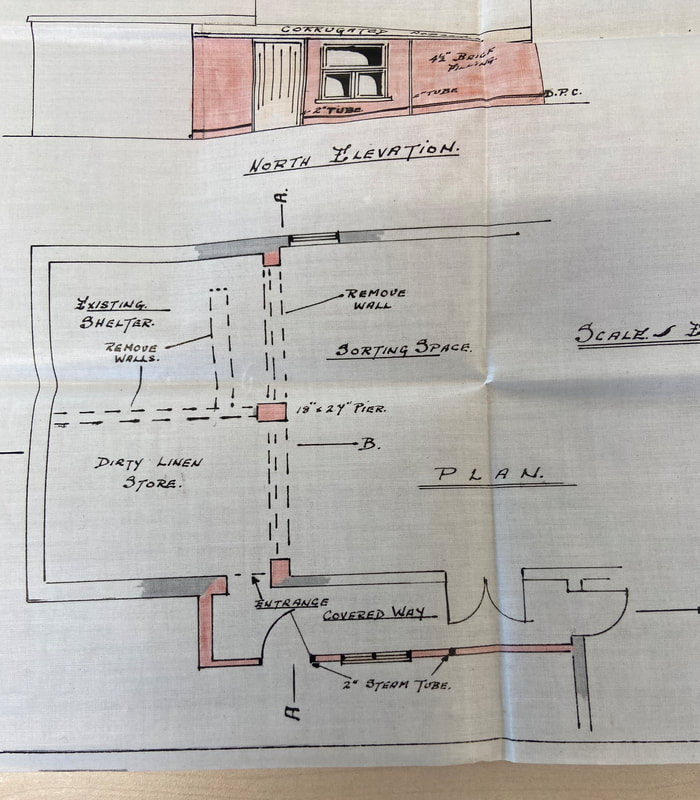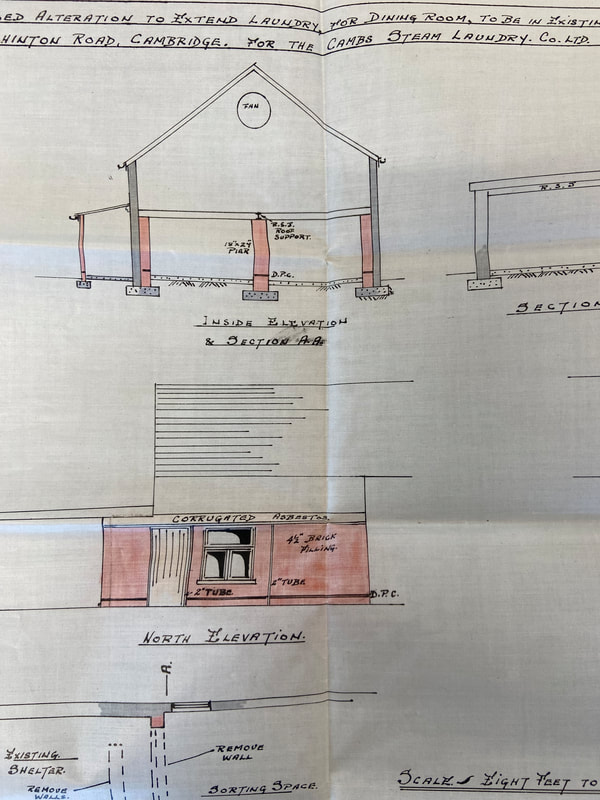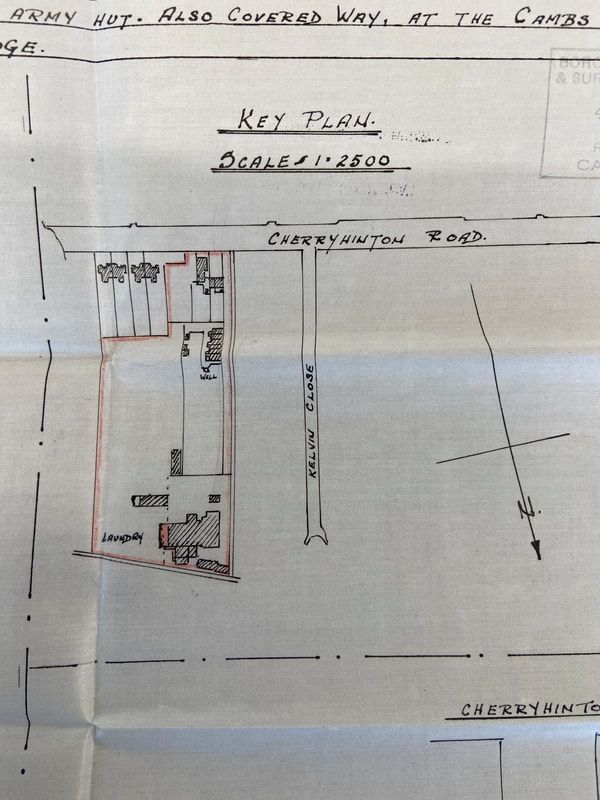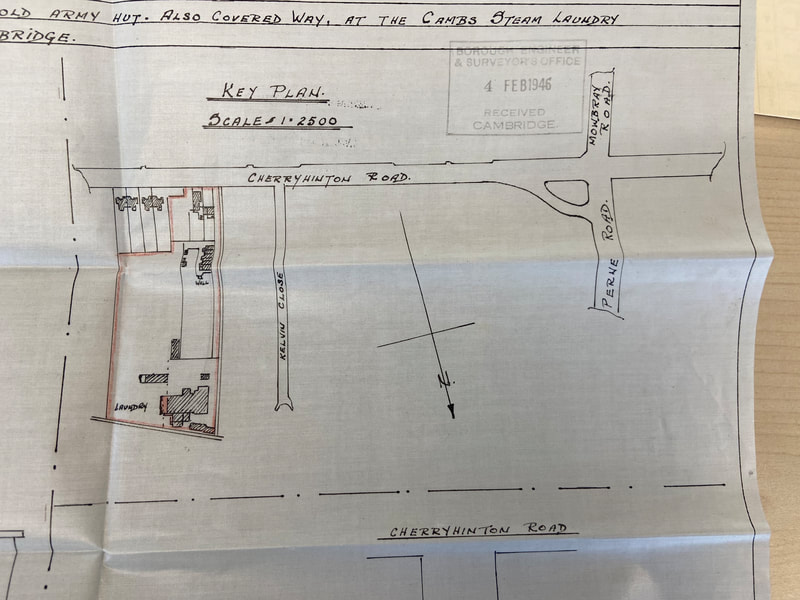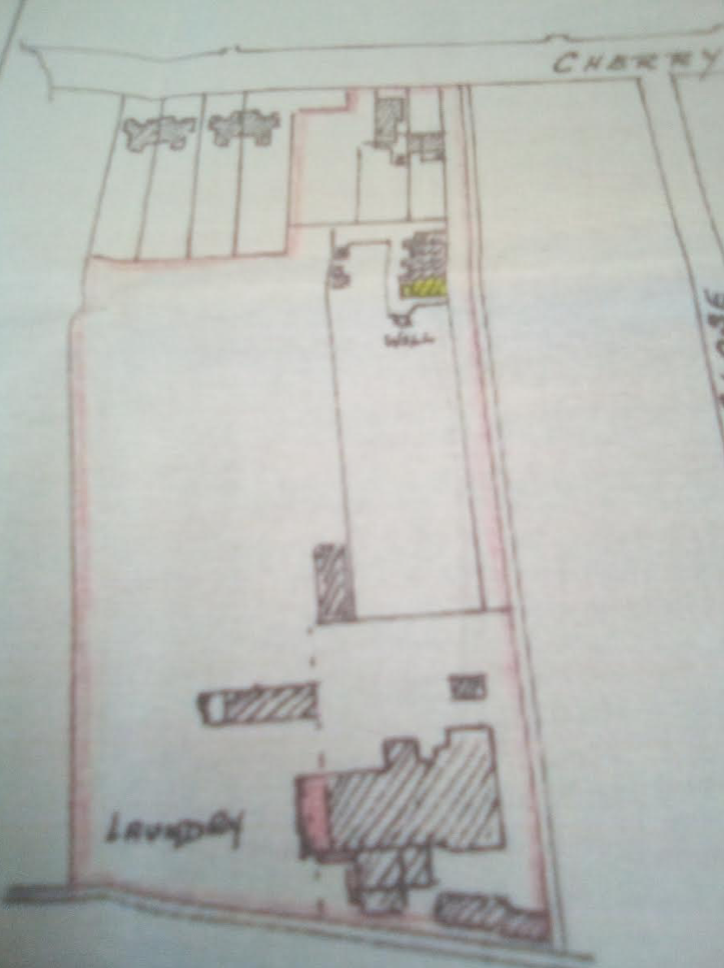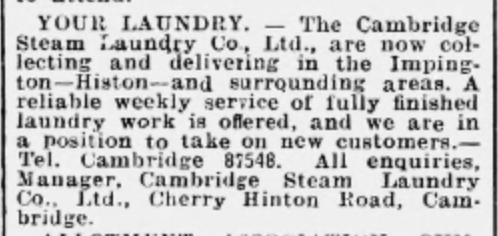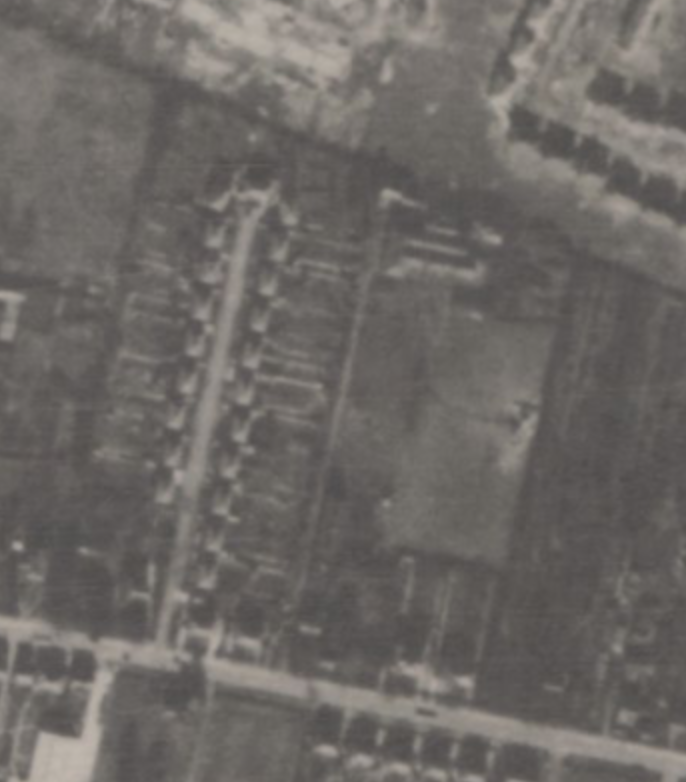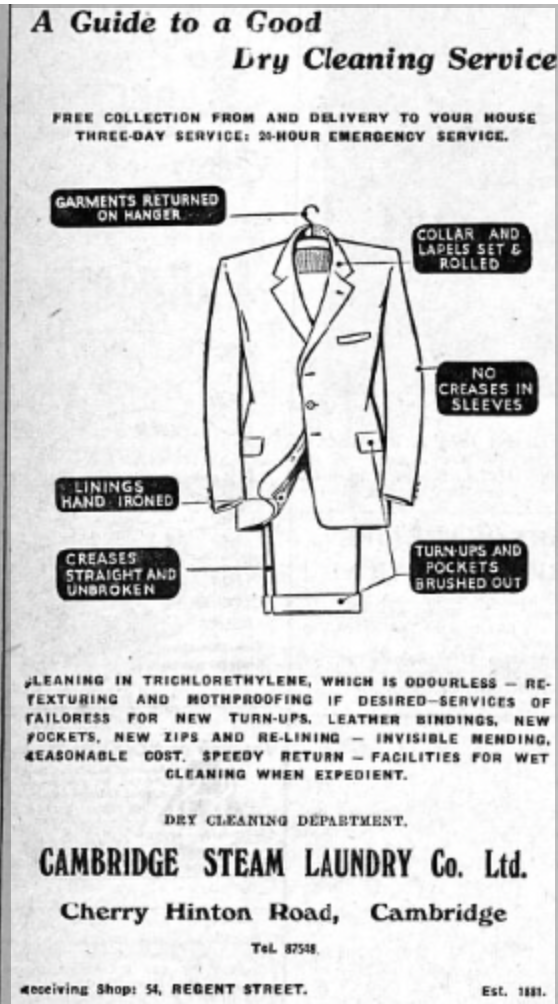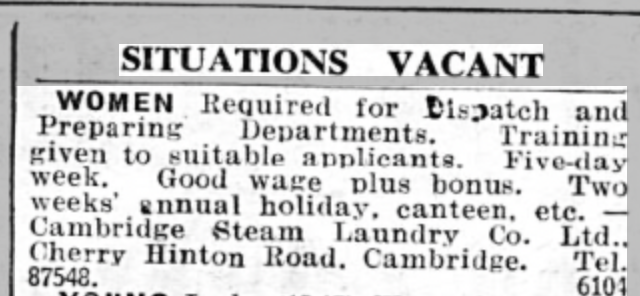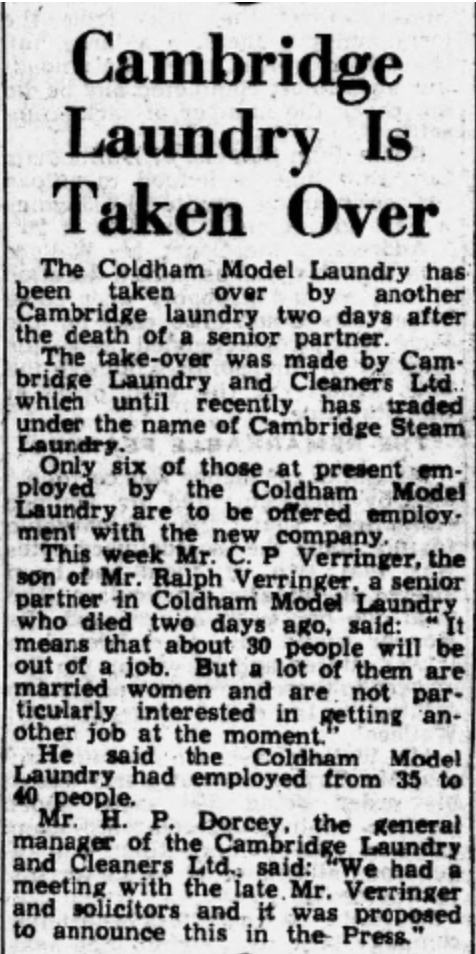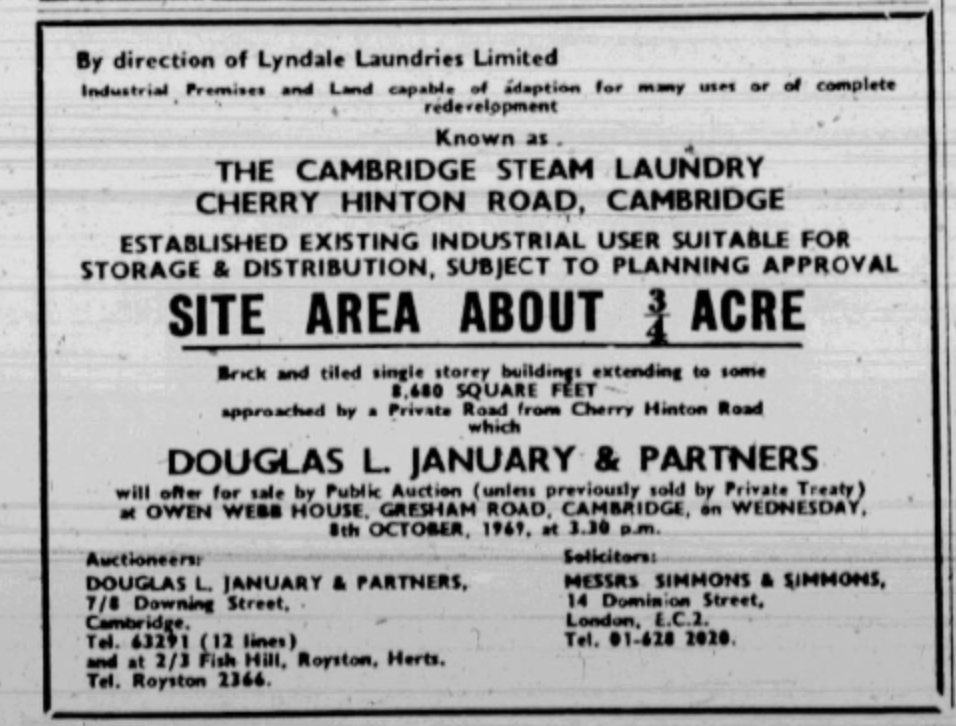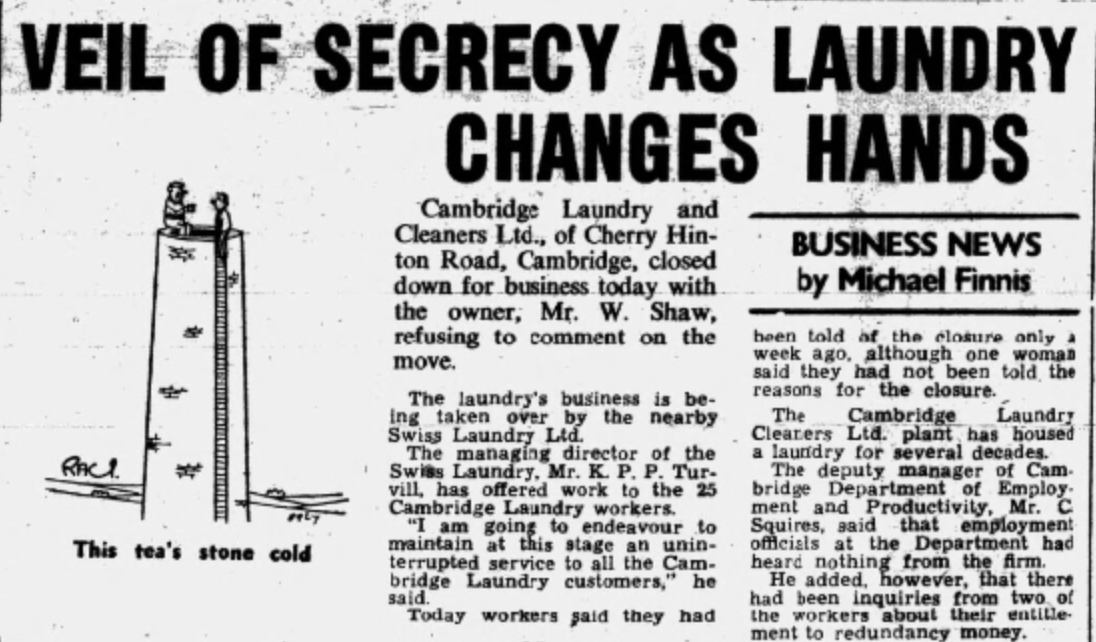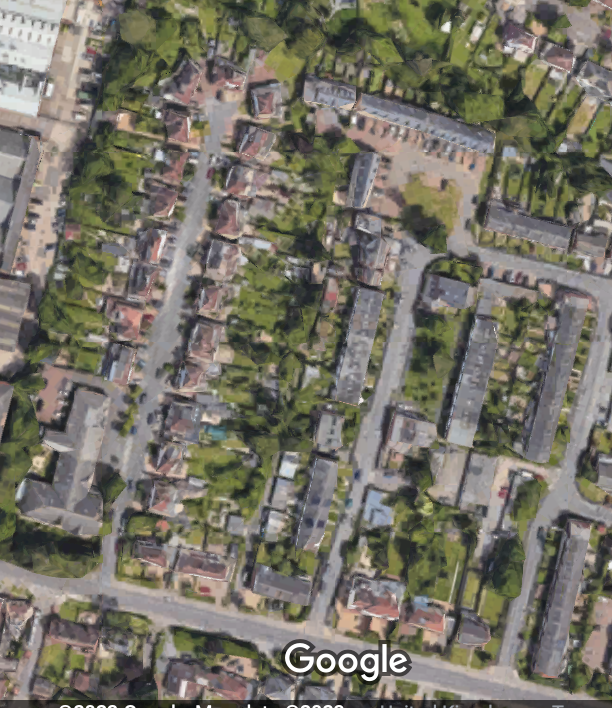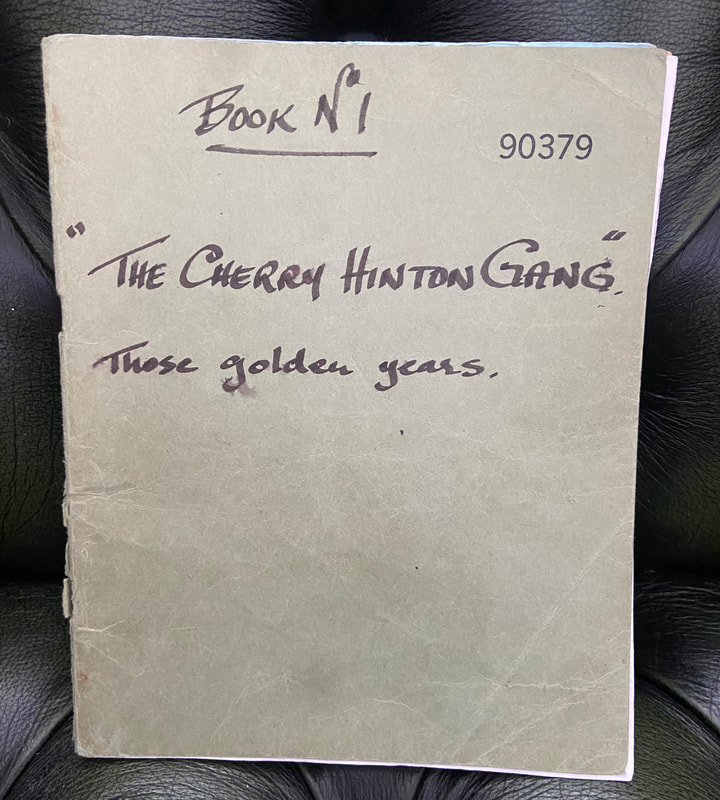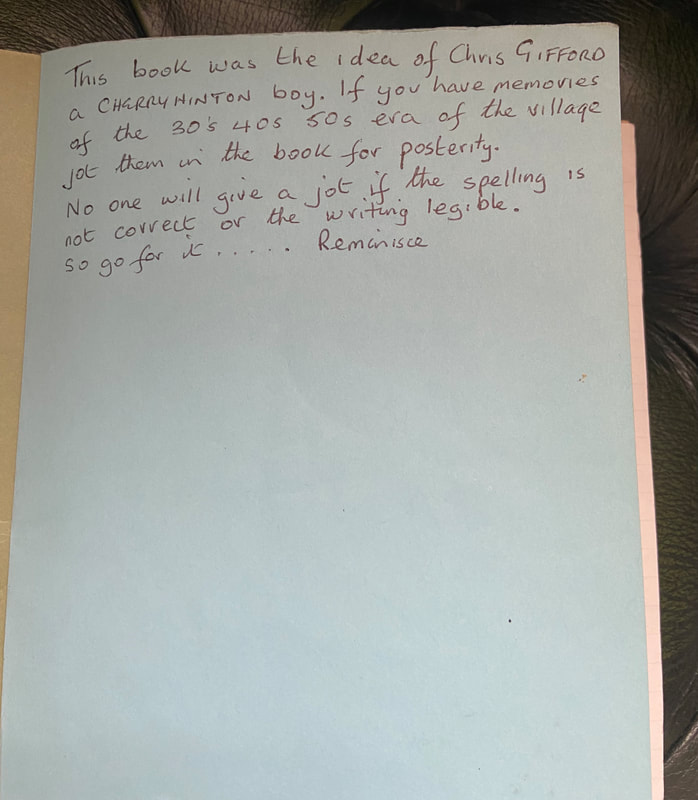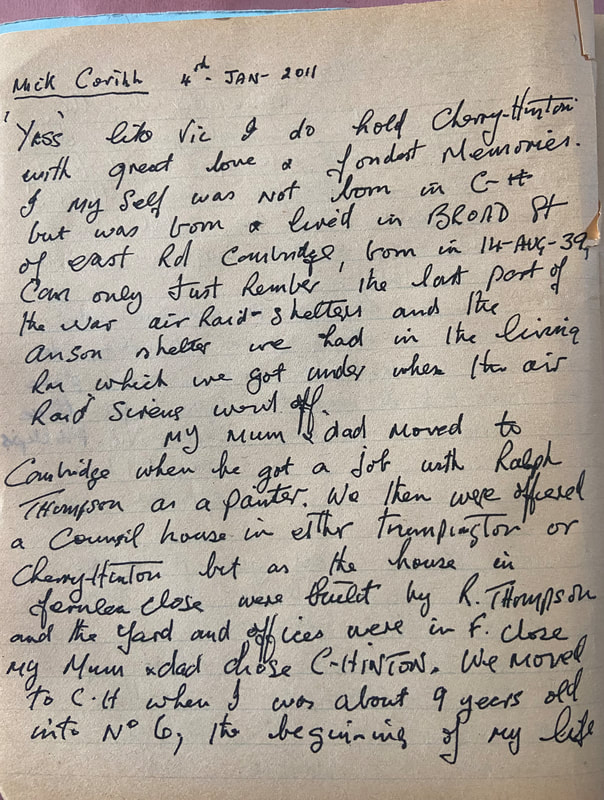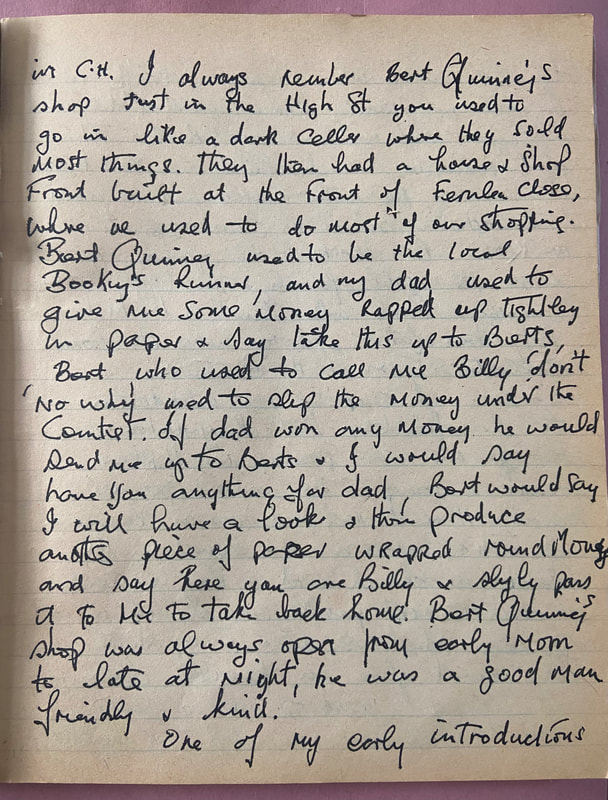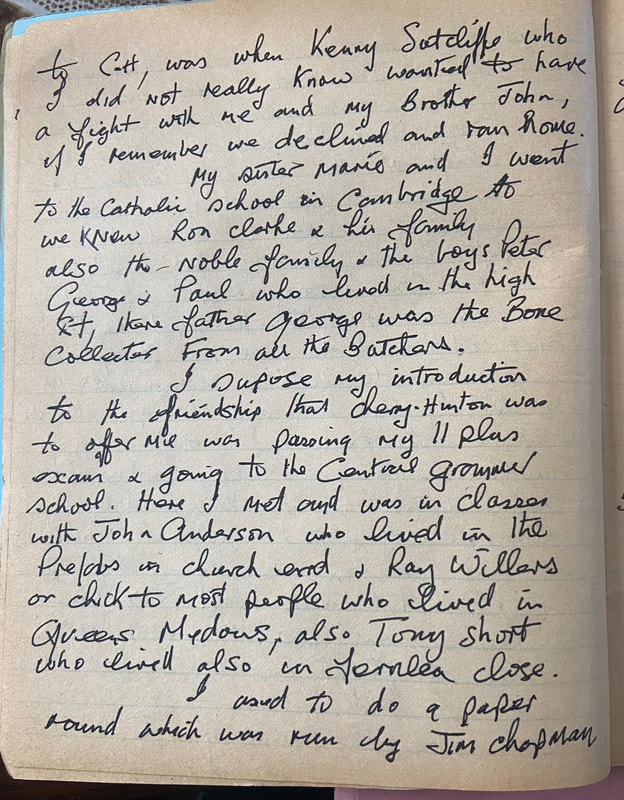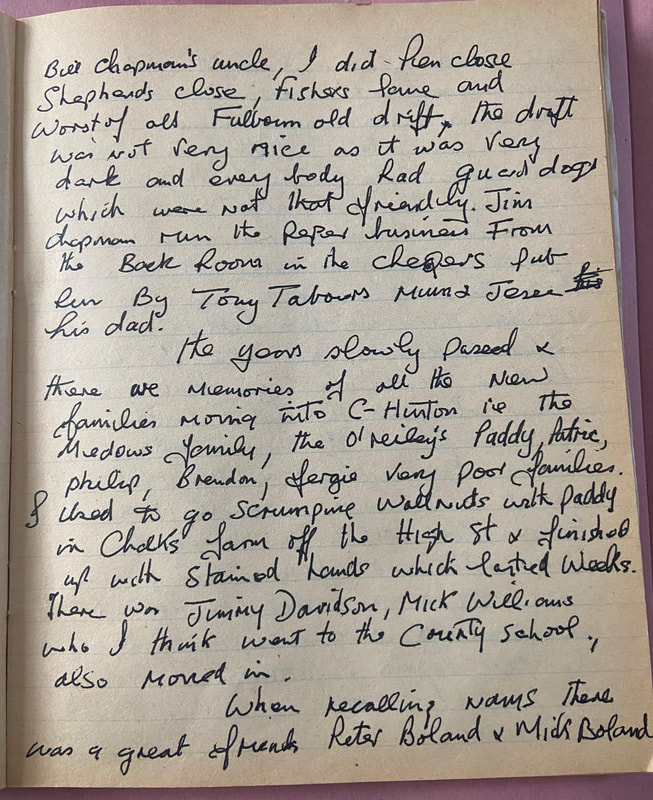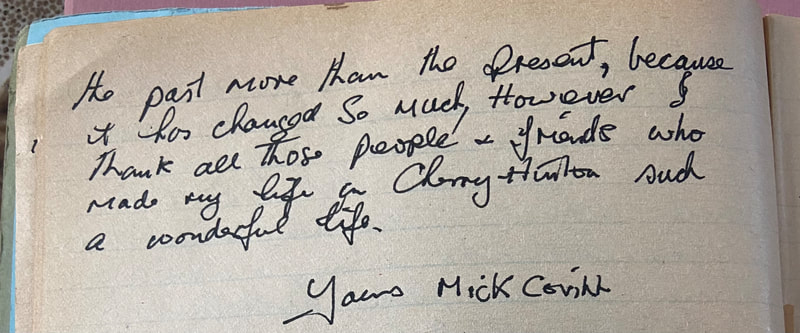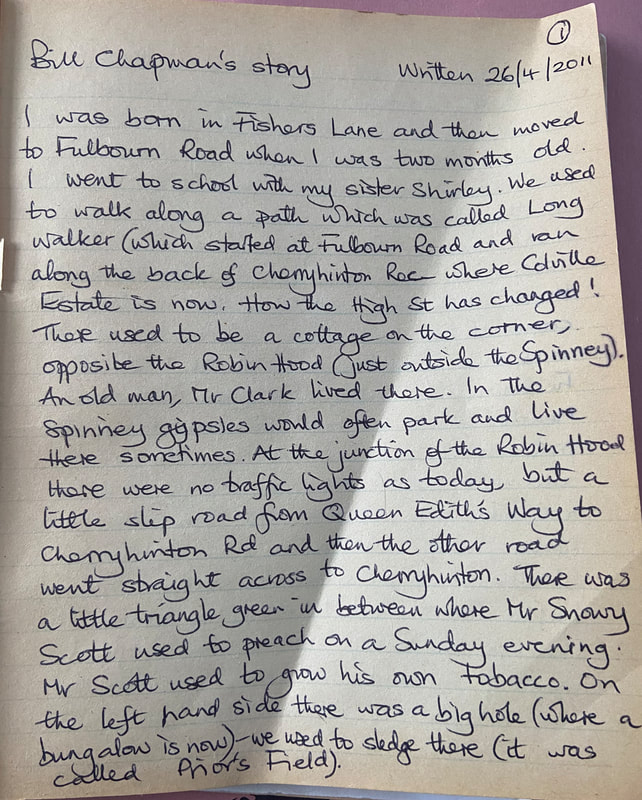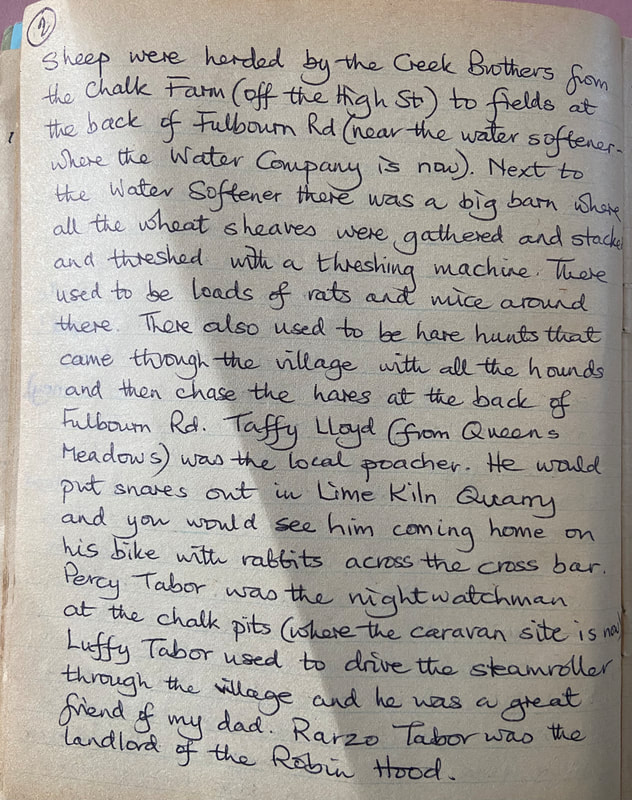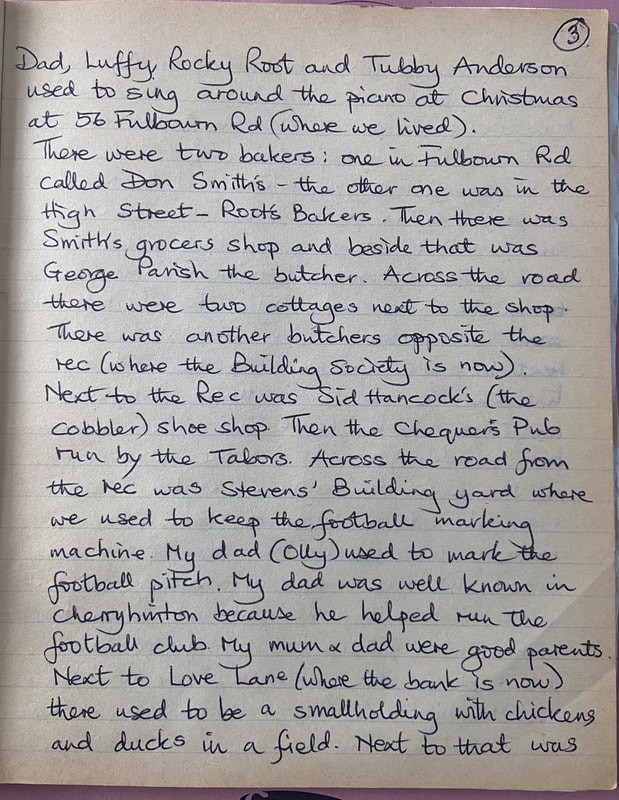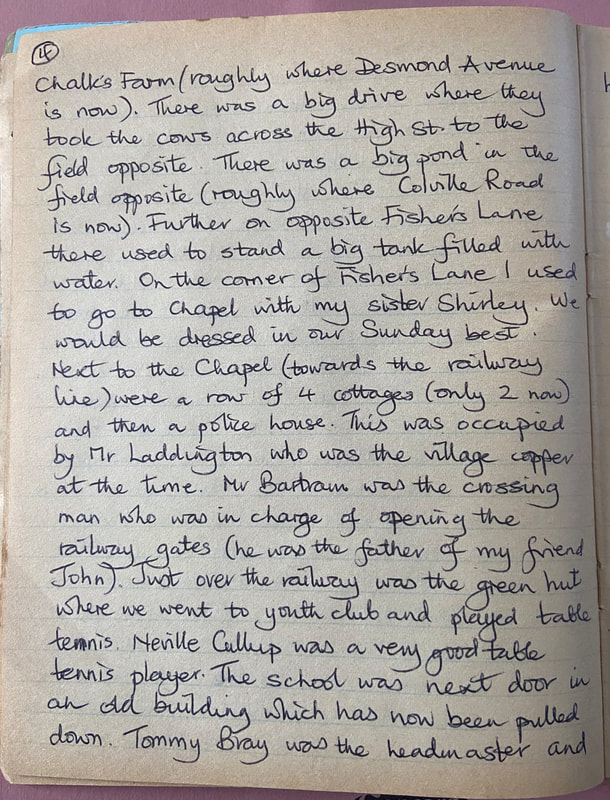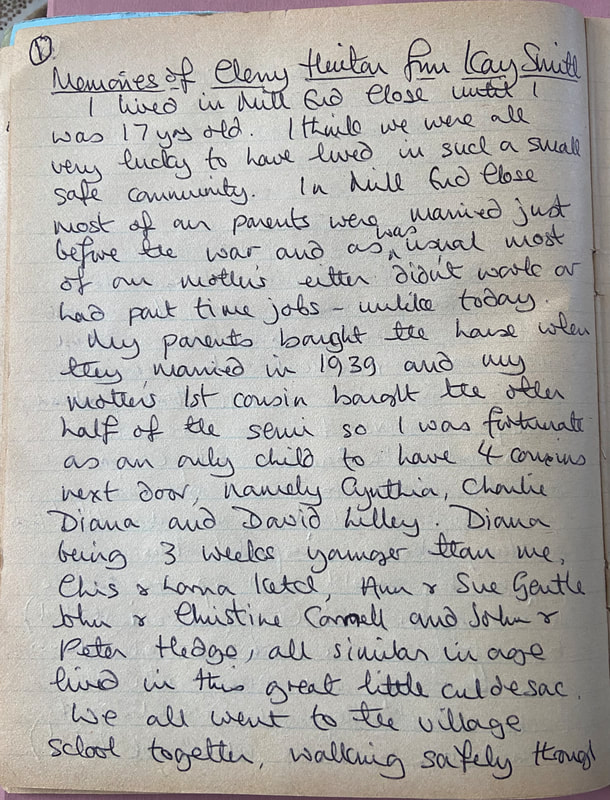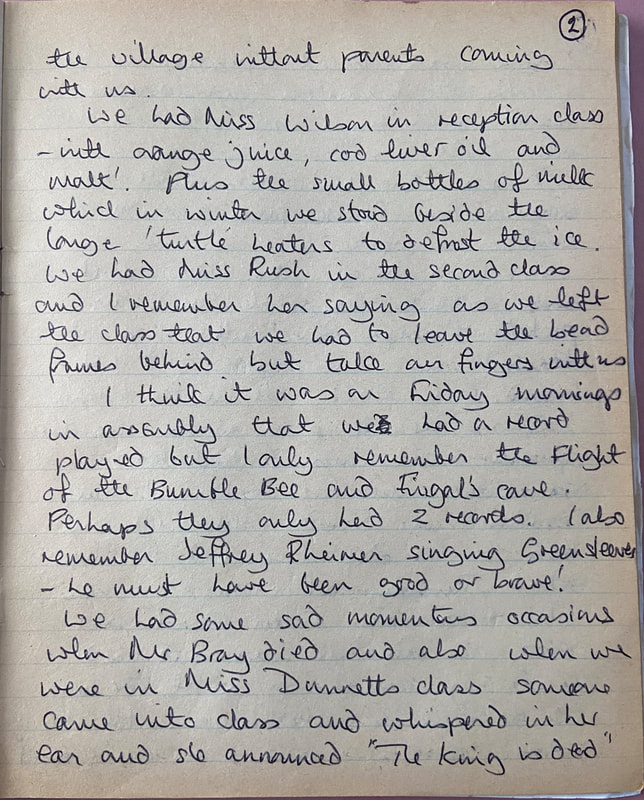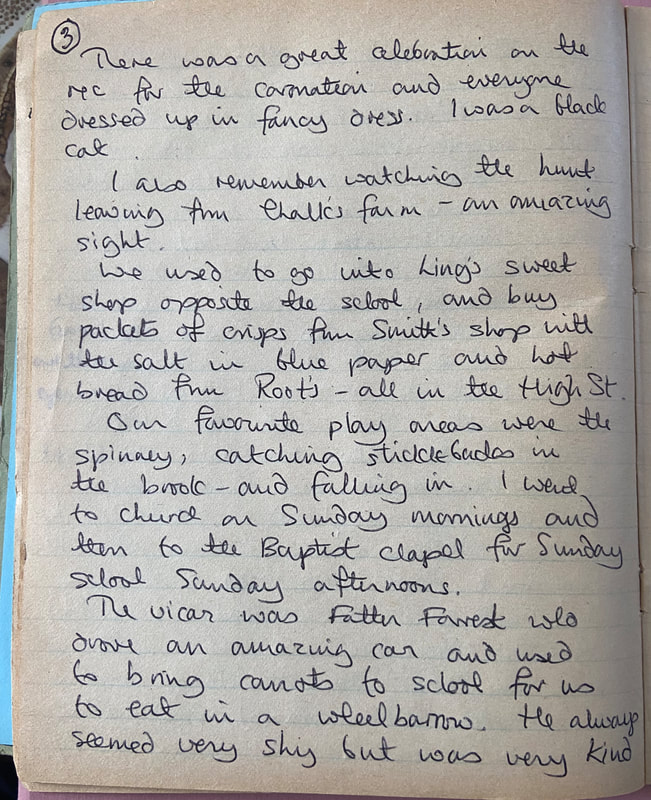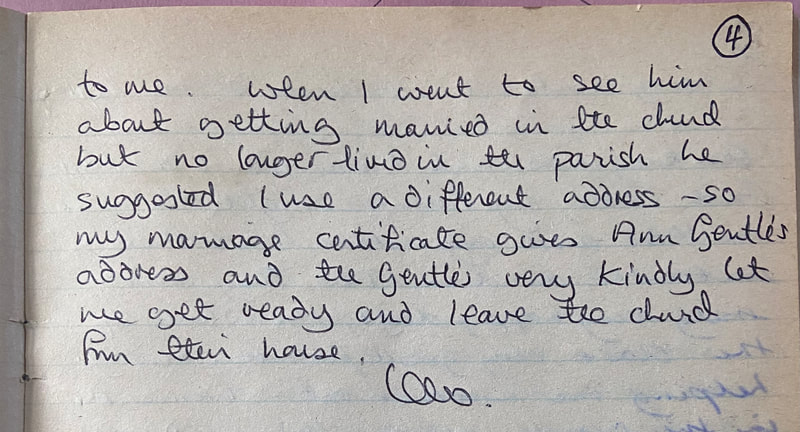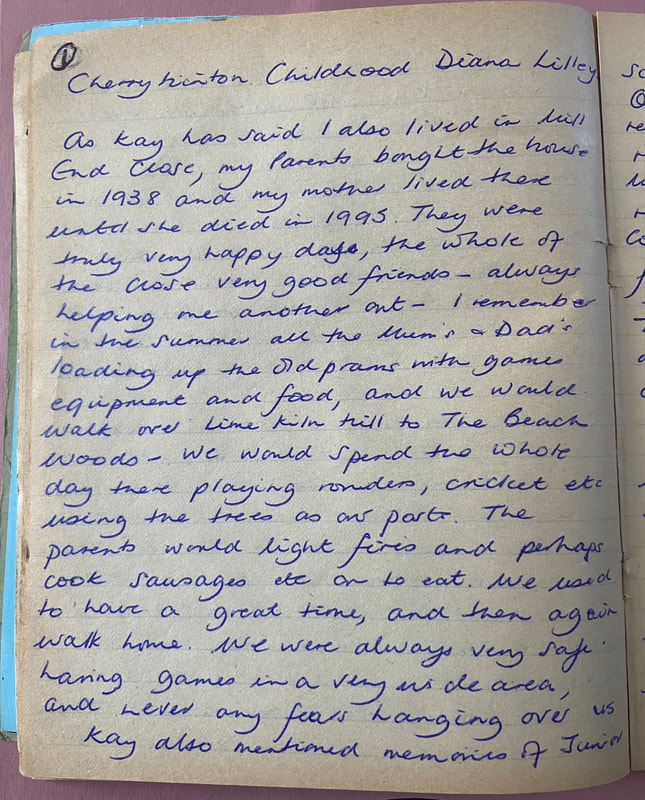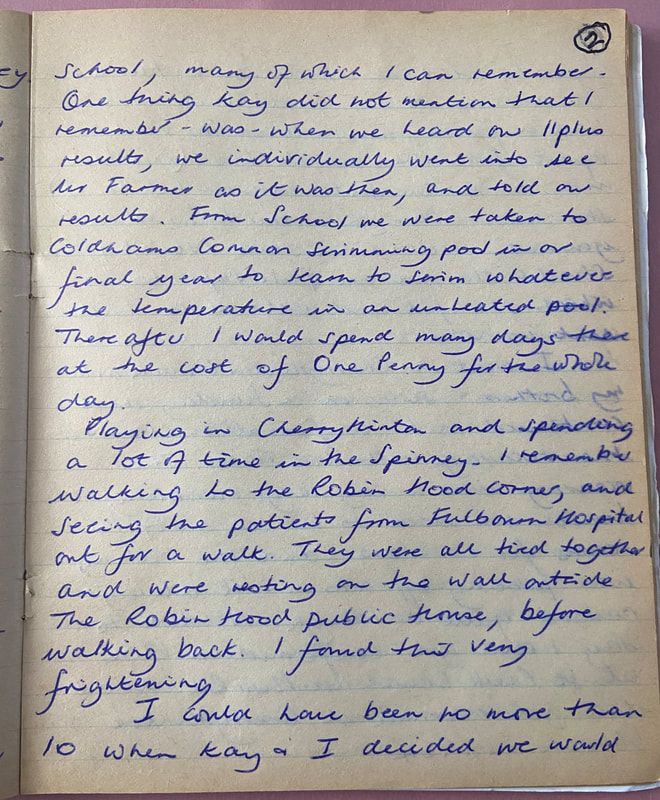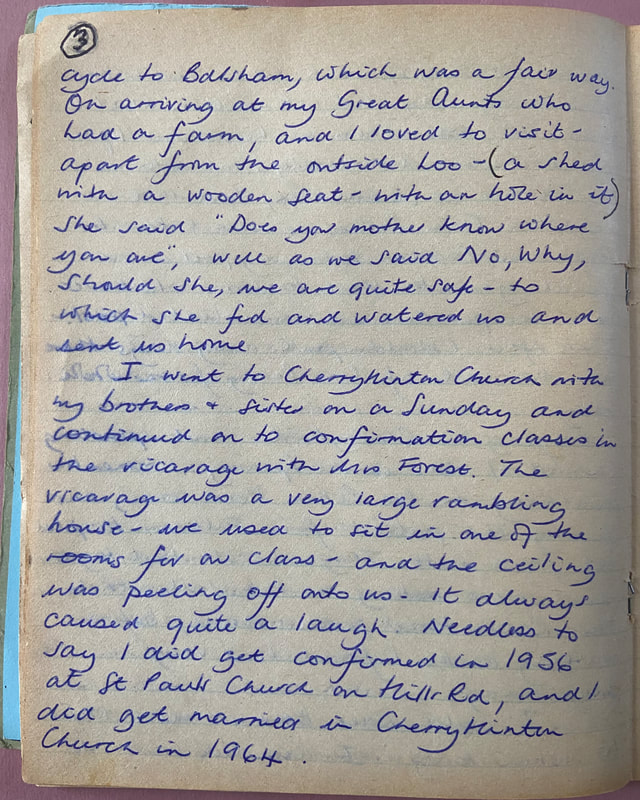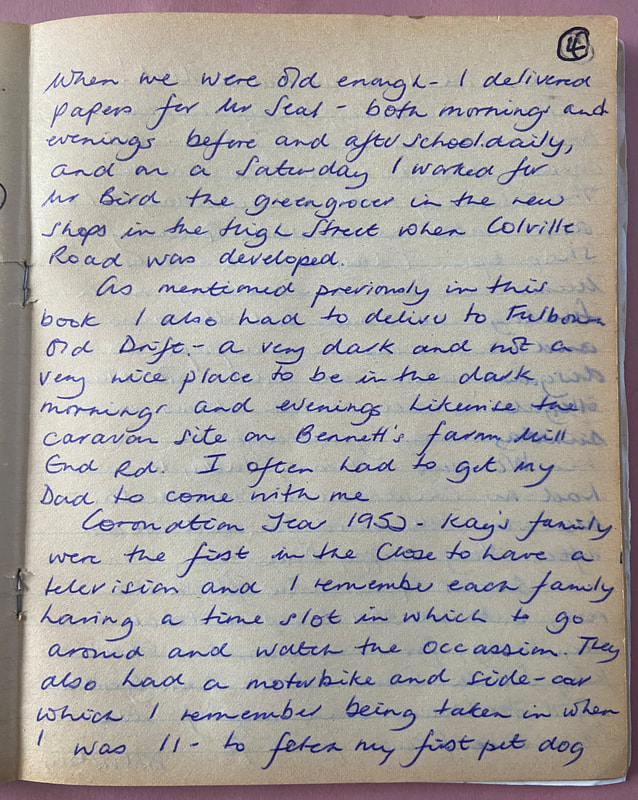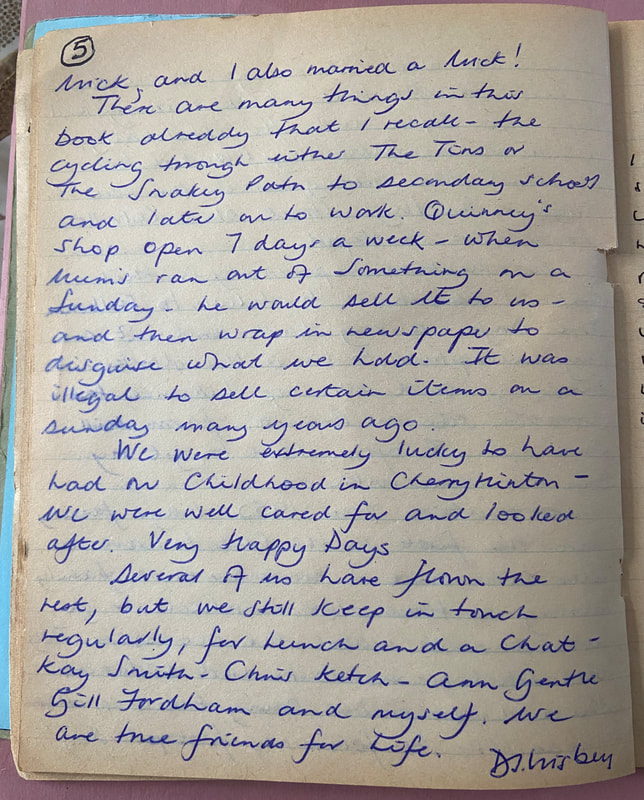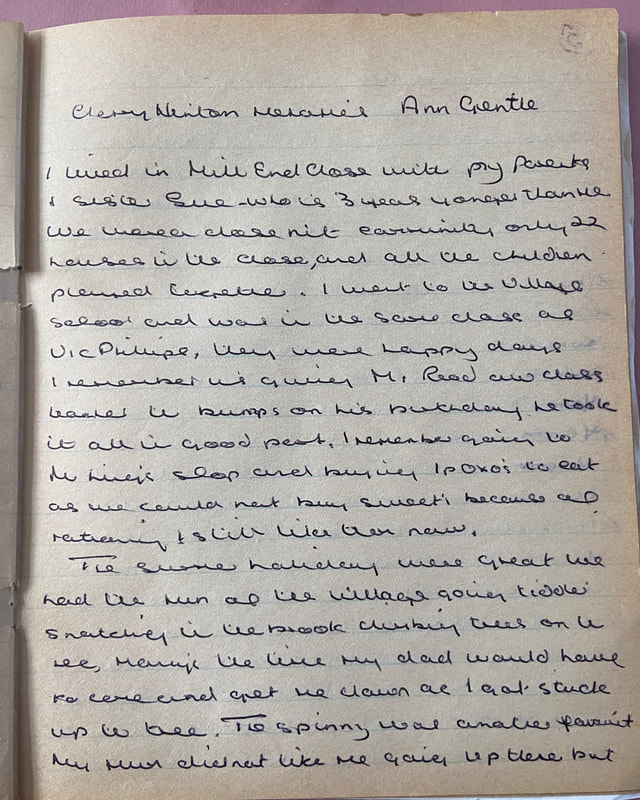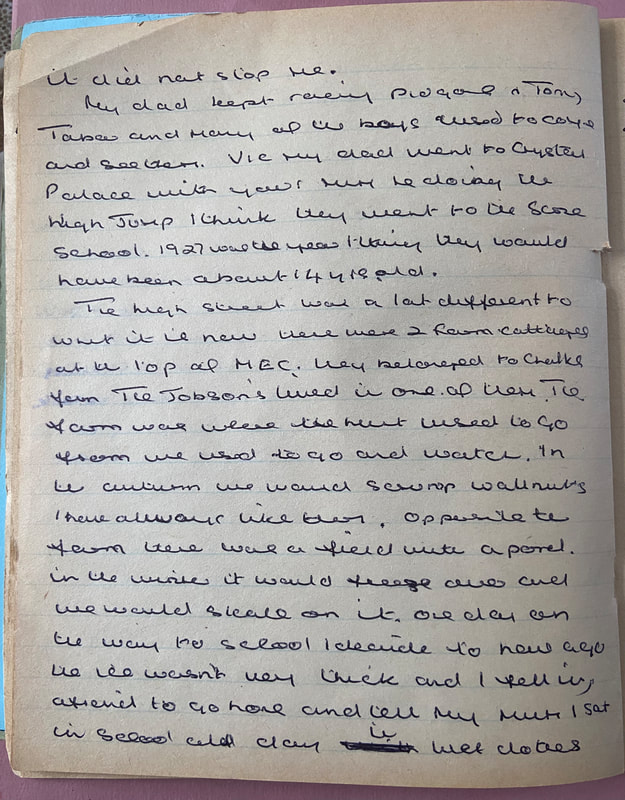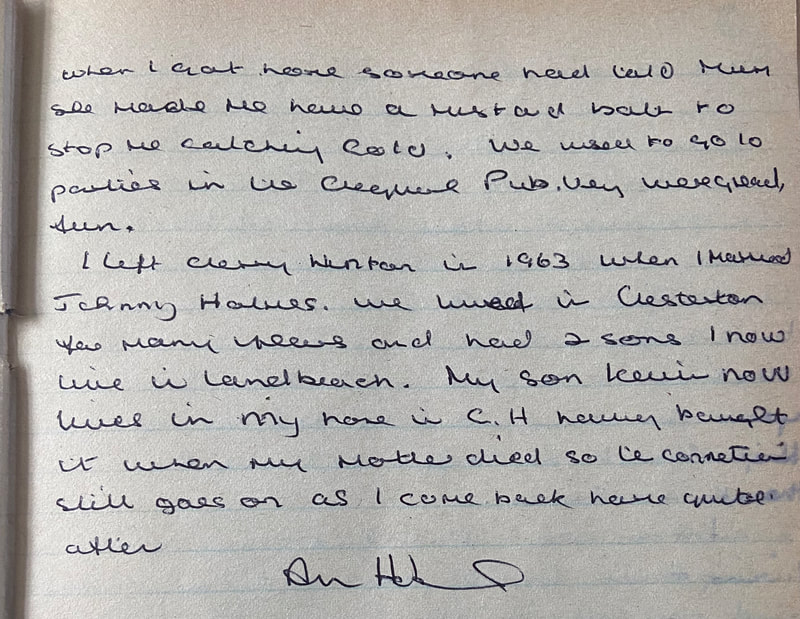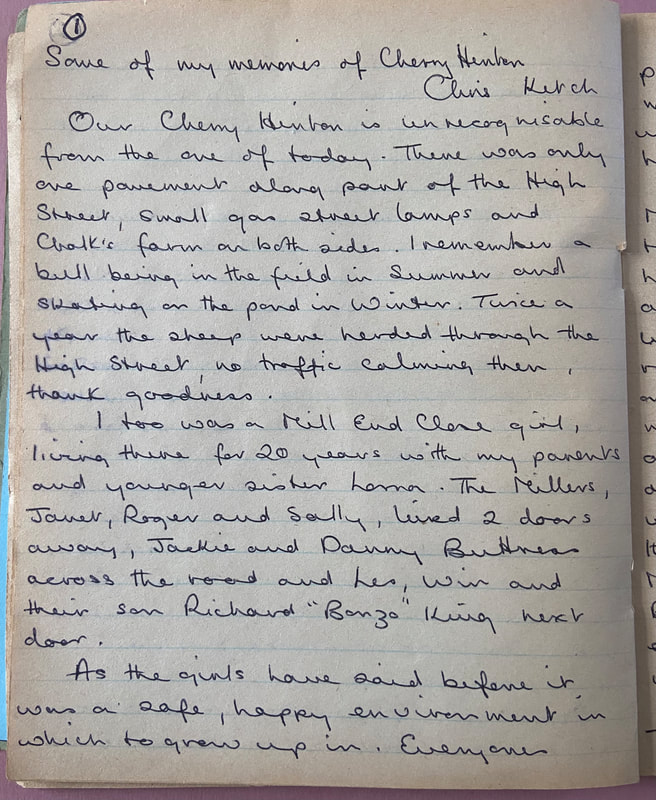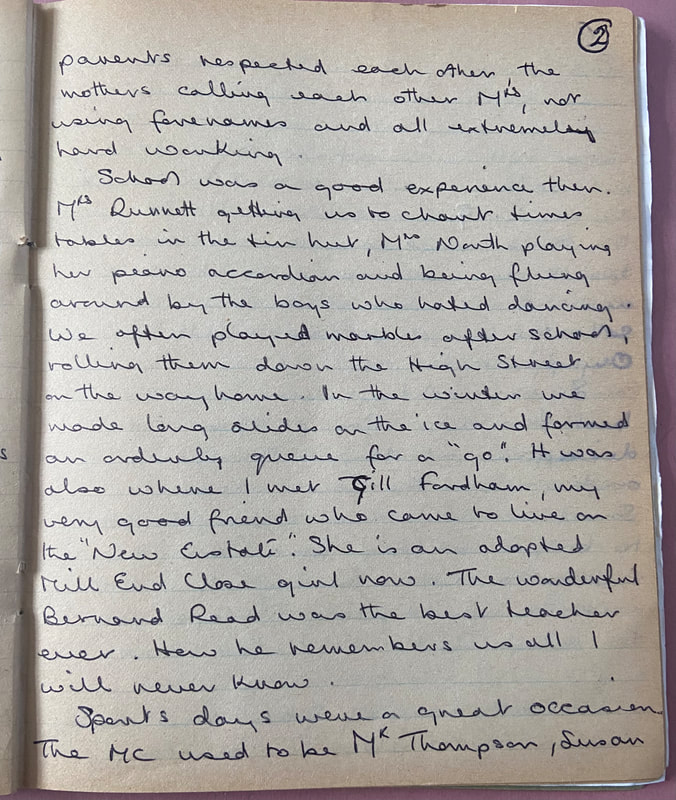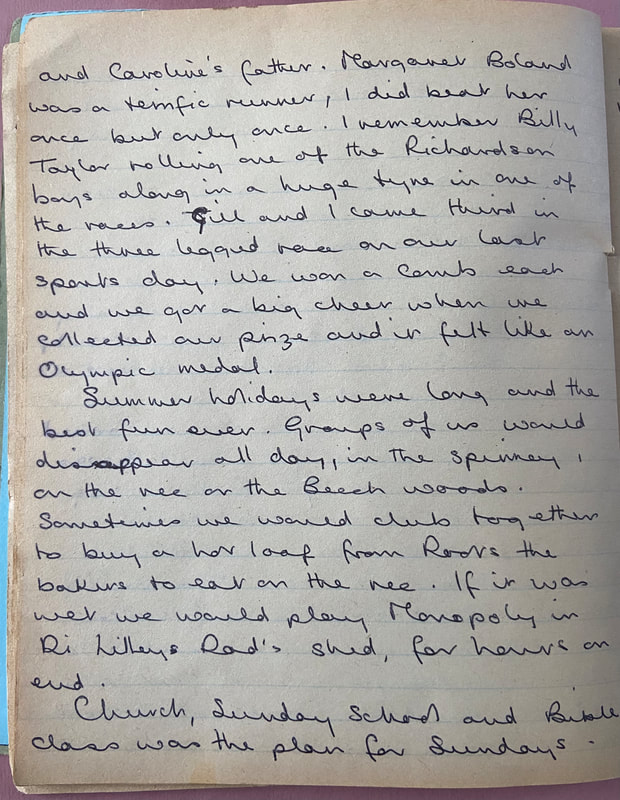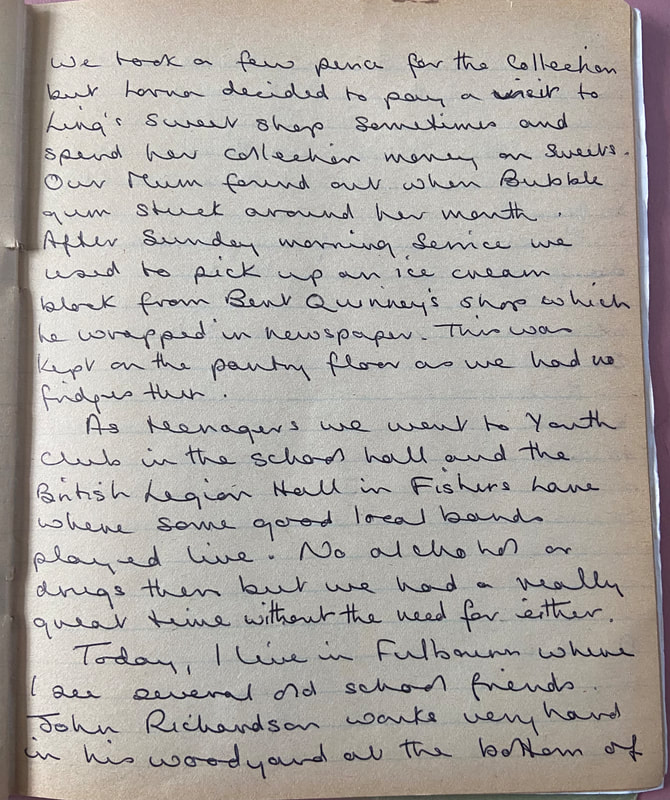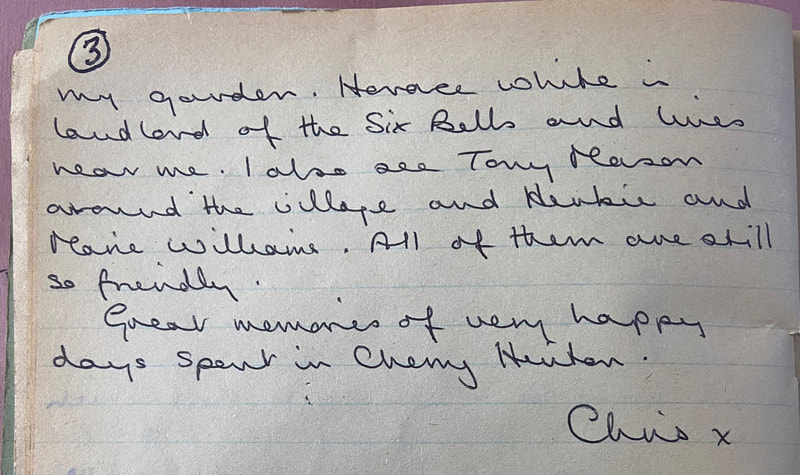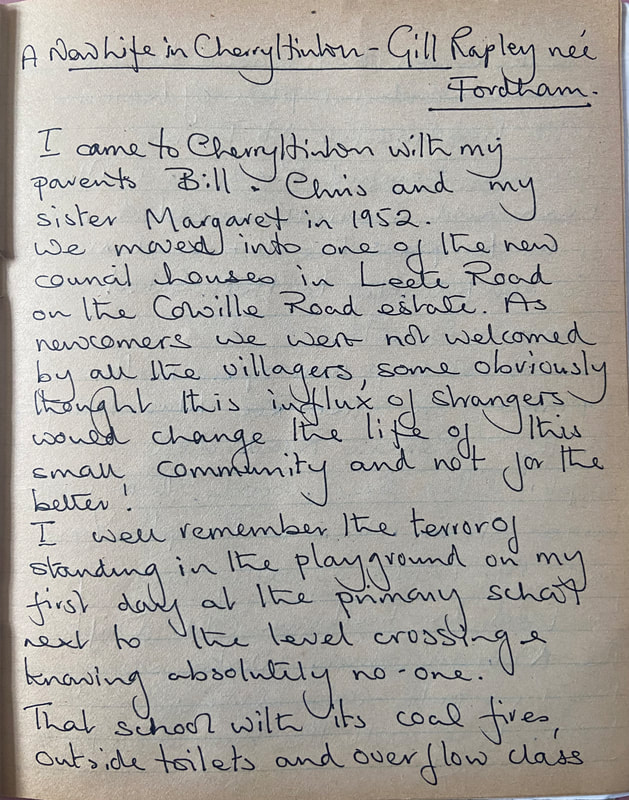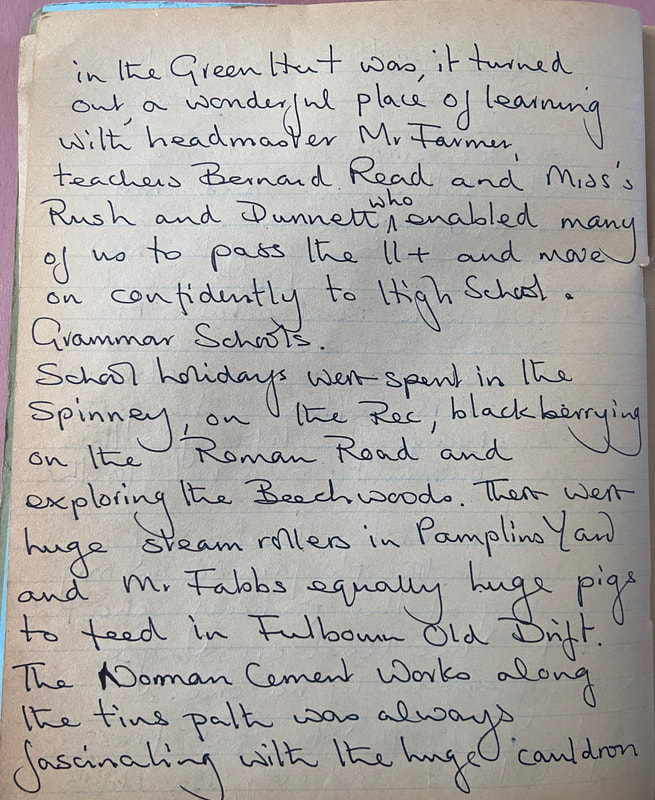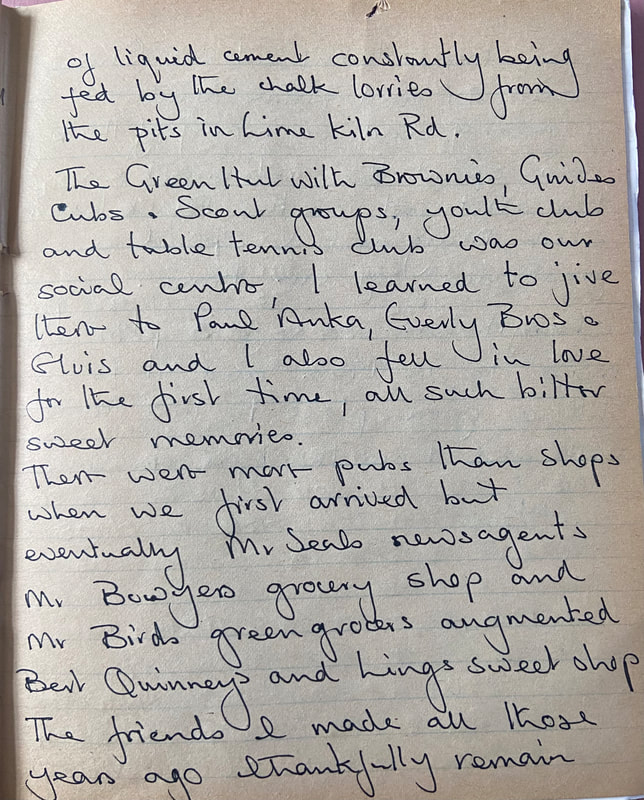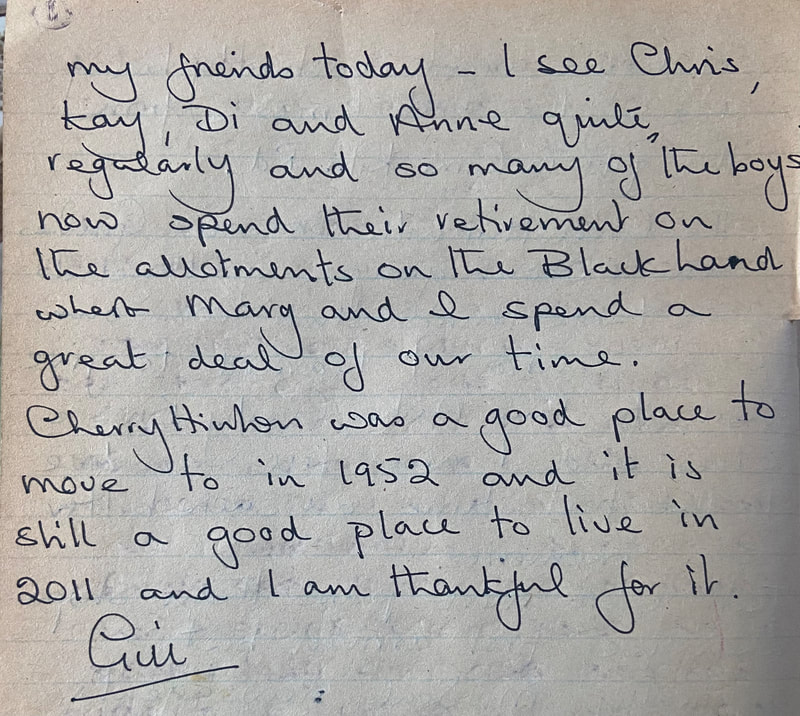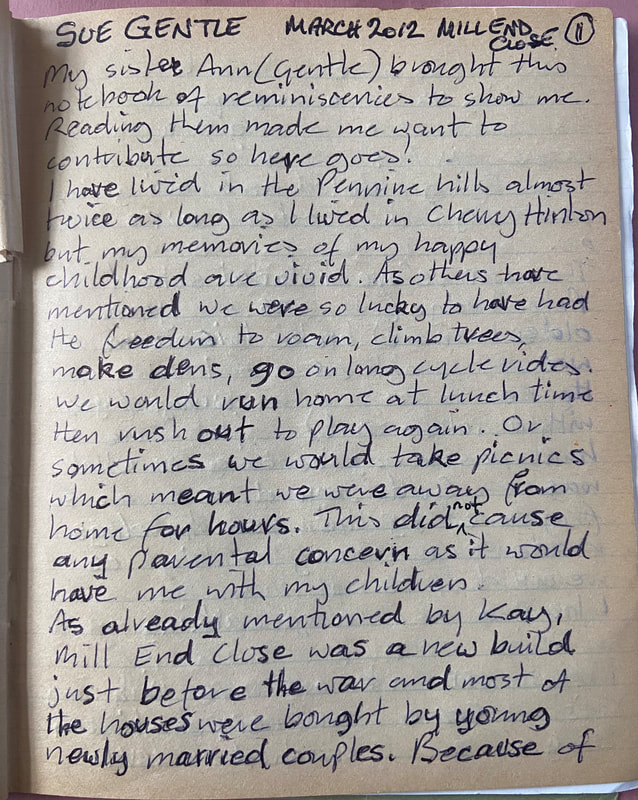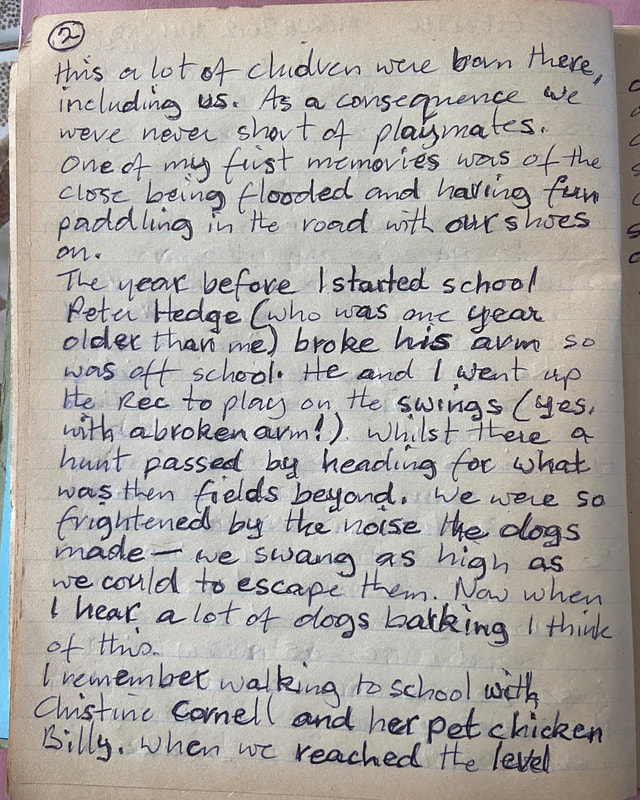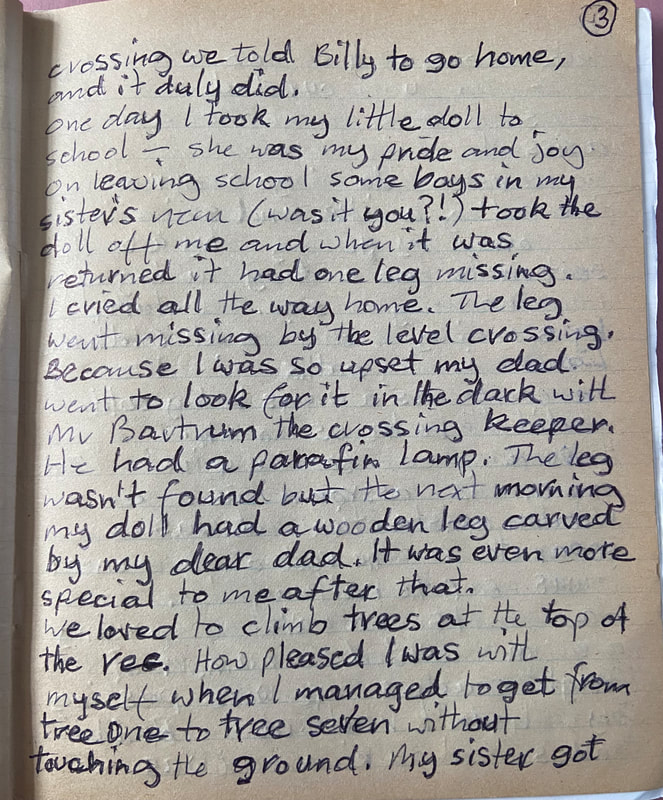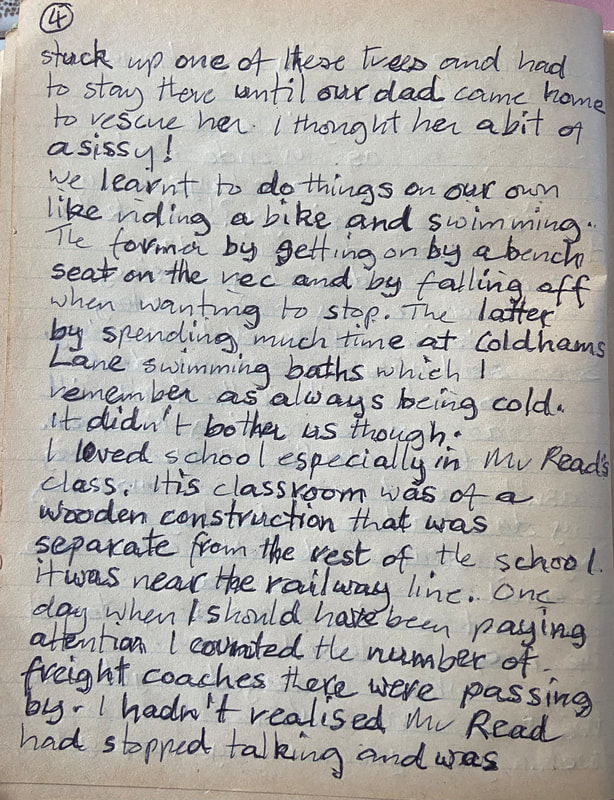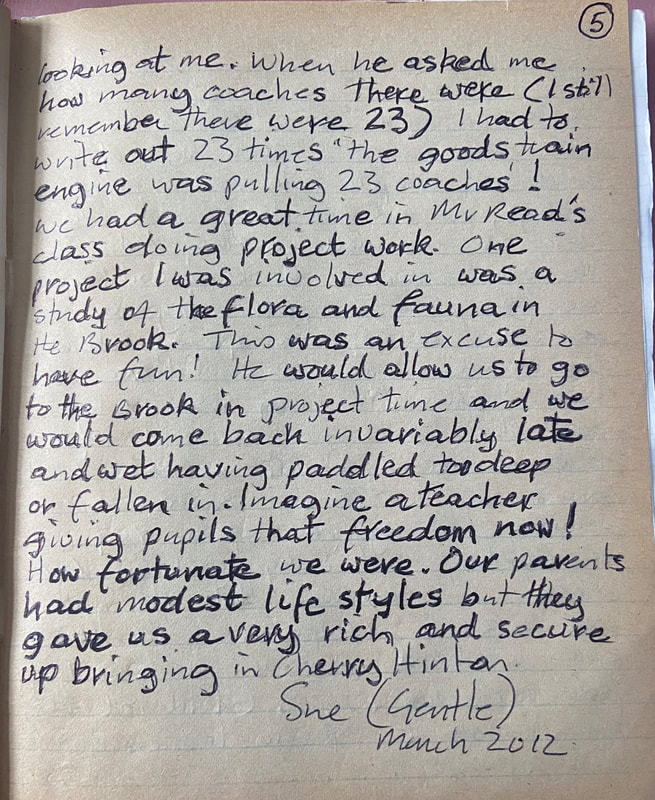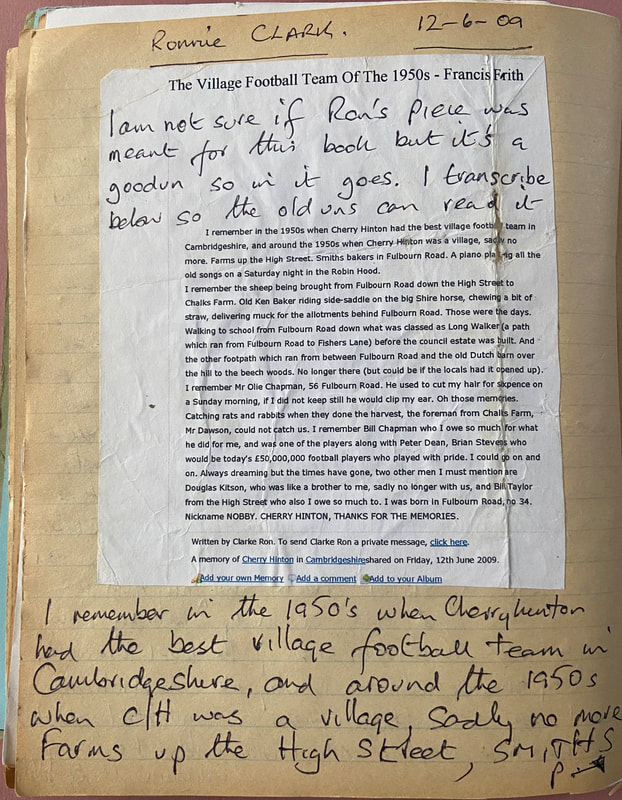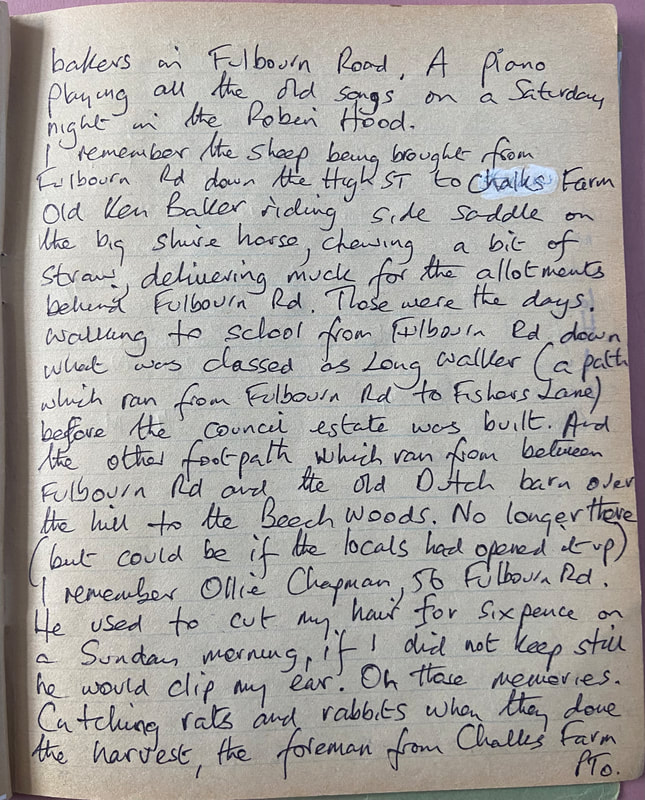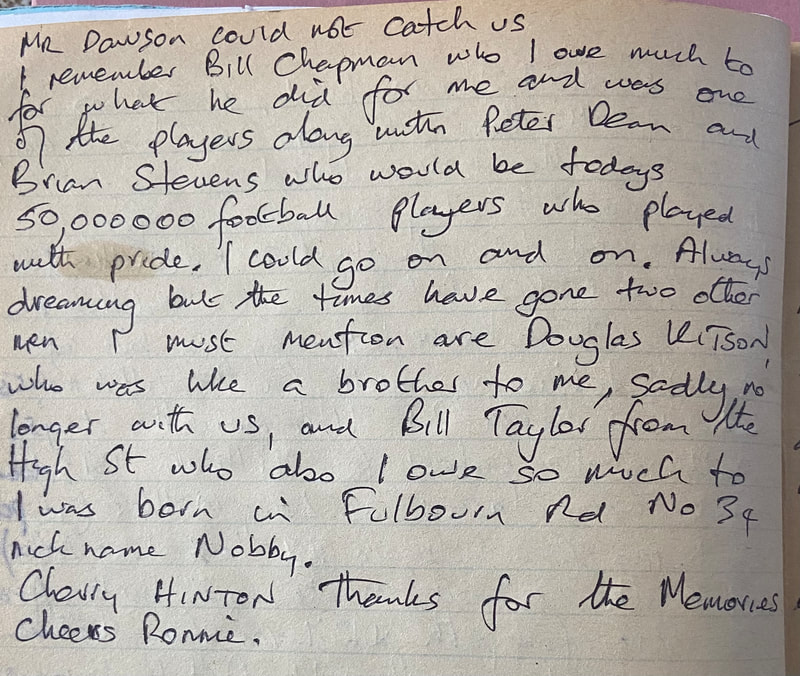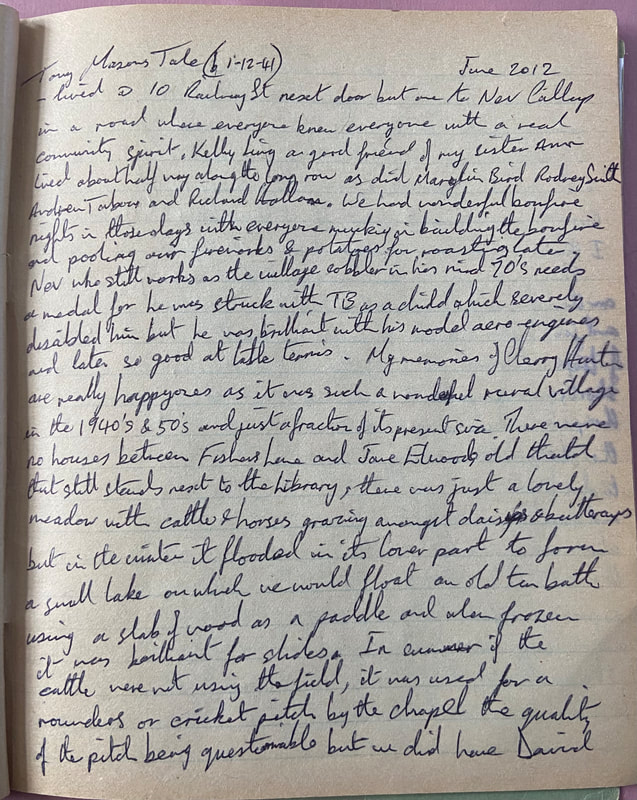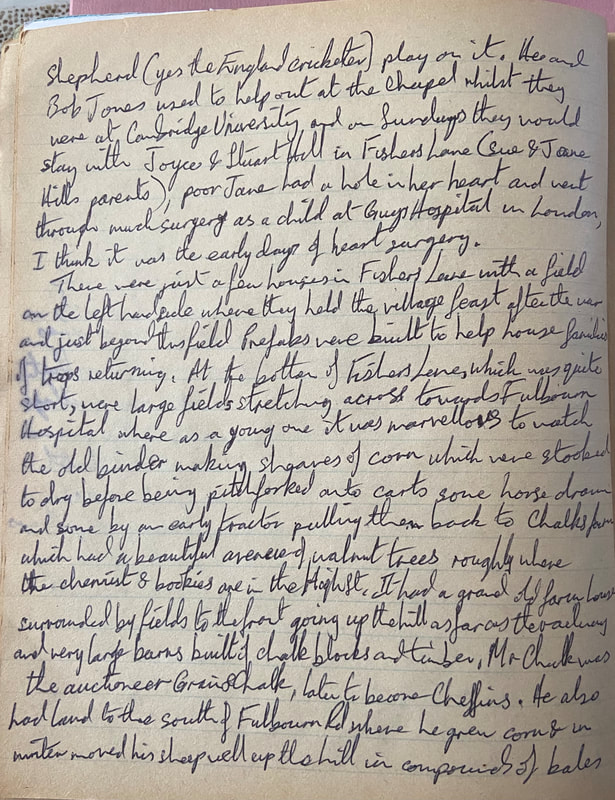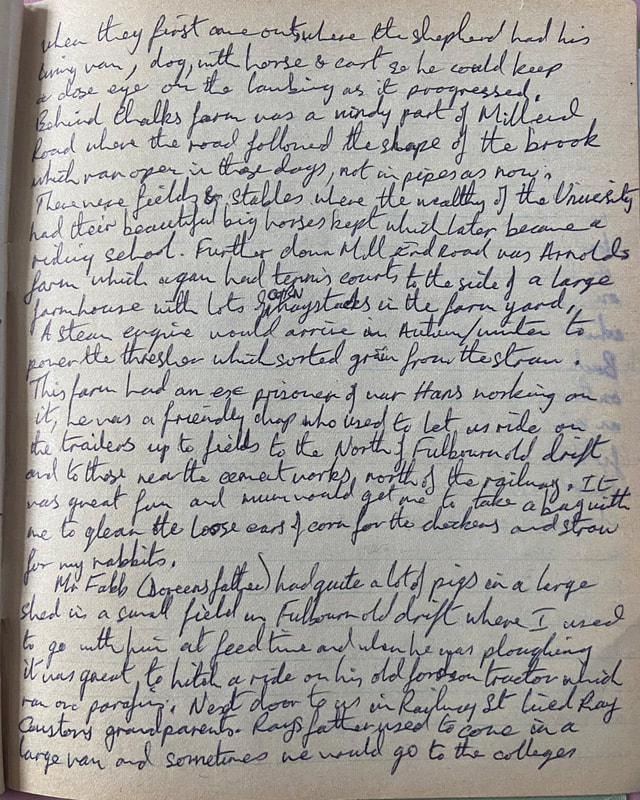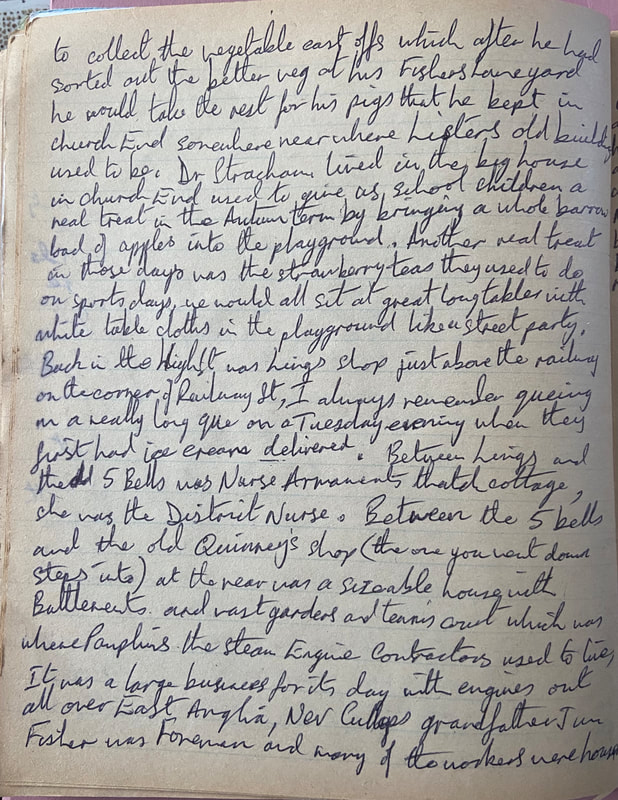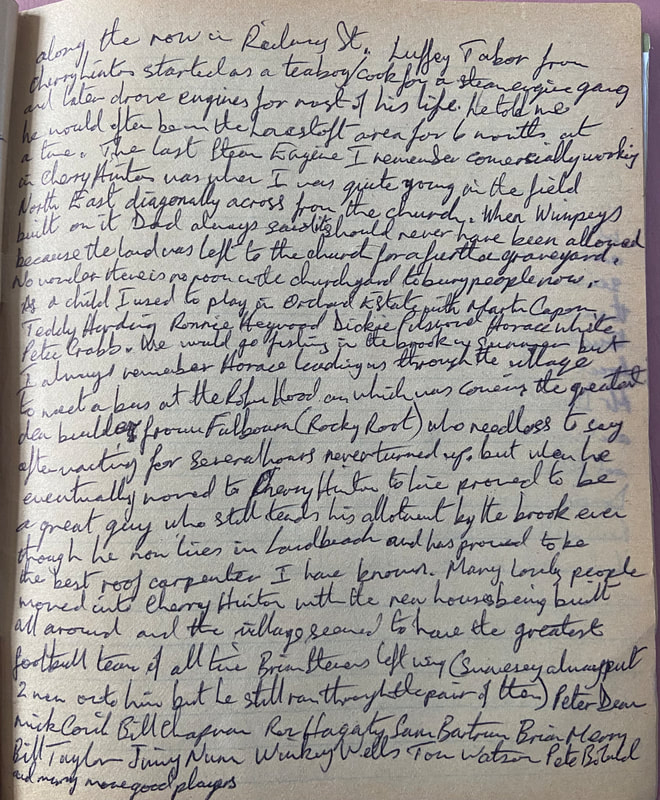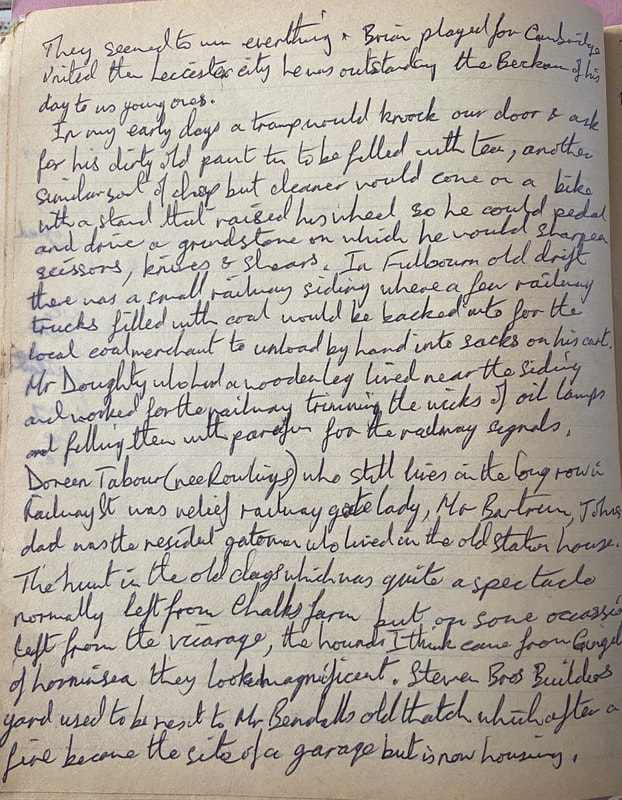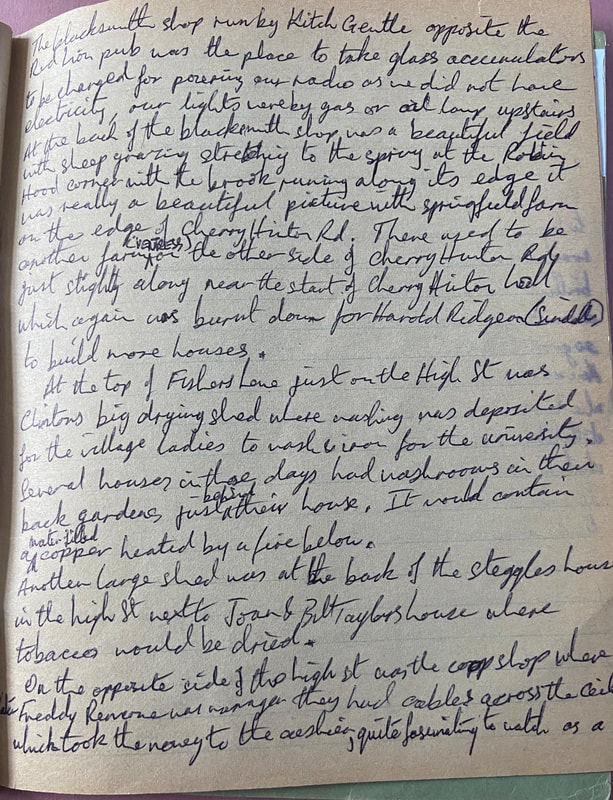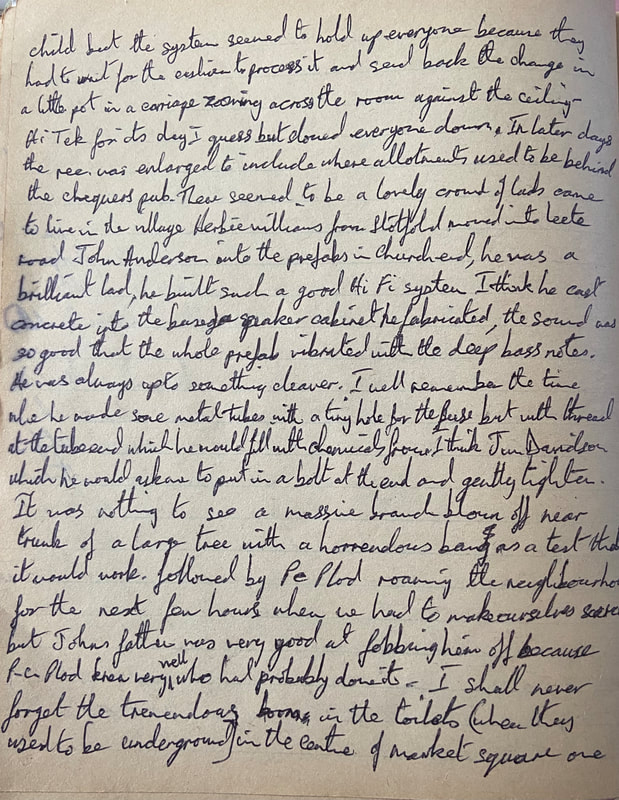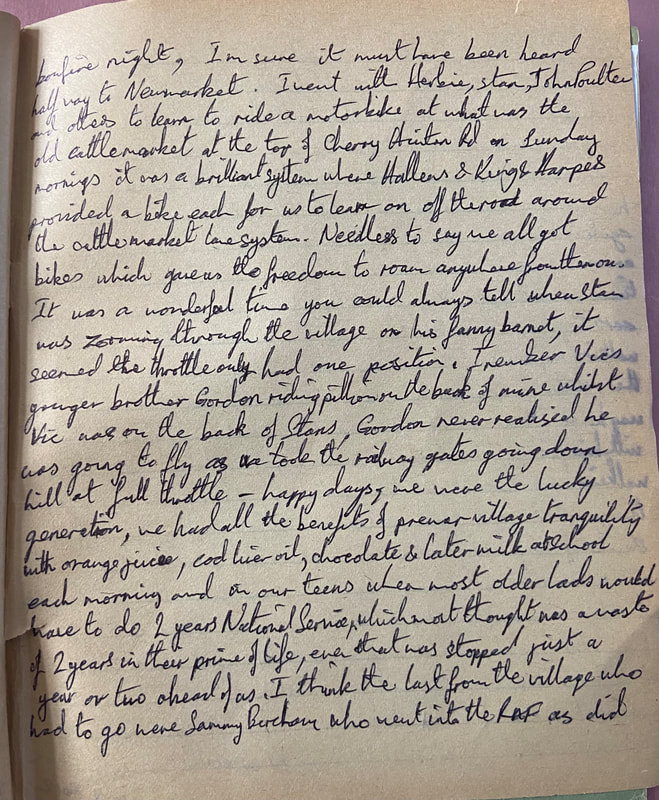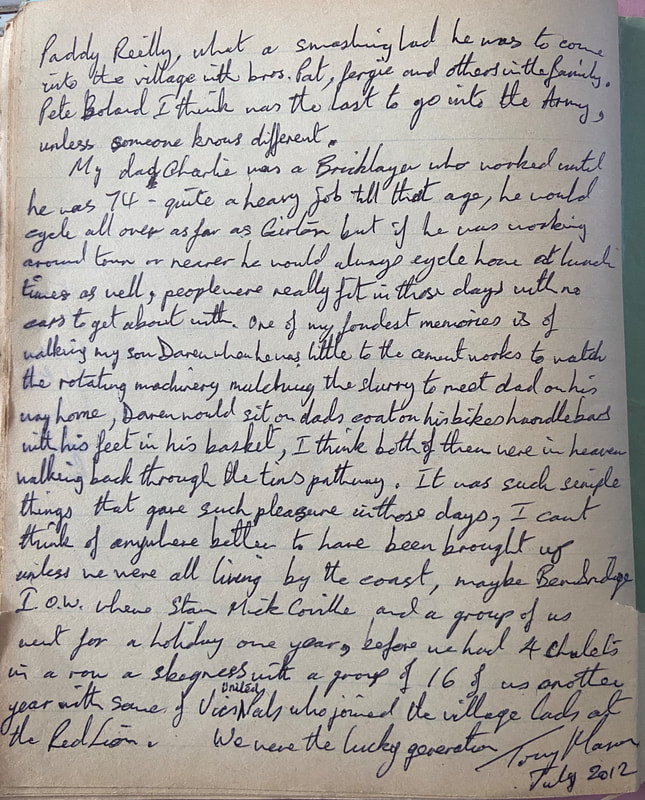|
Memories of Laundry Lane by Penelope (Penny) Jackson
My Early Life living in Cherry Hinton Road & Laundry Lane
Family
Ruby Gladys Jackson (Mum) William (Bill) Ernest Jackson (Dad) Sisters Ellen Margaret, and me Penelope
*All photographs included here are Penny's, unless otherwise stated.
I was born on 28.04.1948 at 141 Cherry Hinton Road where my family lived in a downstairs flat. I was the youngest of three girls, Ellen was the eldest, she was born in North London in 1940, Margaret followed in 1946 and I came along later in 1948. Margaret and I were both born at 141 Cherry Hinton Road. My parents decided after the 2nd World War to move away from London and make Cambridge their home.
I believe that my dad's first job in Cambridge was at the Swiss Laundry on Cherry Hinton Road, which was not far from our home. My dad was an engineer, and he eventually left his job at the Swiss Laundry and worked for the Cambridge Steam Laundry which was at the end of Laundry Lane off of Cherry Hinton Road in Cambridge.
The job came with a cottage which was located at Laundry Lane, our cottage was number 1 Laundry Lane which was the cottage nearest the Laundry, there were 5 other cottages and as far as I can recall, all were occupied by other laundry workers.
I recall that there was a family called Arnold who lived at number 3 Laundry Lane, Cecelia Arnold was the eldest and I think Len was her son, there was a young lady called Ella and I remember a young man called Ricki. At some point, there was a baby boy living in the Arnold household and I guessed he was Len's son, his name was Kevin.
There was a family whose surname was Cramer. I think the dad was Polish. I cannot remember his wife's name, but I remember he had 2 daughters. I think one of the daughters was named Barbara, the other I think was Marisha but I am not sure.
There was a family called Inskip but I cannot remember what number they lived at, but they had two children Michael and Christine. At the end of the row of cottages was a couple who did not have any children, they were Tom and Ivy Cordon, and I can remember when Queen Elizabeth was Crowned (1953) they let us children watch the ceremony on their TV because none of the other residents had one! They were also the only ones who had a car.
There was another little cottage in Laundry Lane, it was nearer to Cherry Hinton Road. There was a little girl called Freda Mauer who lived there with her parents, her dad's name was Steve.
Post-war, money was tight, but as a child, it seemed to be a happy community. At the back of the row of cottages, we all had back gardens and to the side of the houses was a plot of land which was turned into allotments for growing vegetables. There was also a well on this piece of land.
Beyond our back gardens was a big field, where in the summer the children used to play during the school holidays. In early summer the field was covered with cowslips, which today are still my favourite flower. The boundary of the field had a row of trees and beyond the trees was Coe’s Farm. Mrs Coe ran a shop, the front of which was on Cherry Hinton Road. The shop was opposite where the TA is now.
(* You can read more about the Coe's by clicking here: Lime Tree Farm and the Coe Family, Cherry Hinton)
Ellen went to Morley School and when she left there she went to Coleridge School. With all the building that was going on in this area two new schools were built, Queen Edith School and Netherhall Secondary School. Margaret went to Morley School but when Queen Edith was built, she moved there and then went on to Netherhall. I went to Queen Edith and then to Netherhall, but we both hated school.
In the Early 1960s, I am not sure of the date, but I know I was at Netherhall School at the time, we learned that the field that was playing field, at the back of the cottages had been sold and houses were to be built, and Derwent Close was born, building proceeded and we were surrounded by a building site. At the time it seemed like a huge number of houses were being built, but worse was to come, the houses that we lived in were to be demolished to be part of the new build, I think there are garages where our houses used to be. The workers from the Laundry were given new homes on Derwent Close, wonderful we thought, brand new houses with a bathroom! I can remember our old cottage being demolished, Margaret and I watched out of our new bedroom window, and we could see all the pictures of pop stars still clinging to the walls of our old bedroom as they demolished the cottages.
I was 14, Margaret had left school and had a job and Ellen had been married for a couple of years and they lived in a flat in Station Road. Dad came home from work one night and he had to tell us he had been made redundant from his job, so he had to find us somewhere else to live. Margaret and I were really upset, we did not want to move!
But Dad sorted it out, he got another job, at the Cambridge pumping station (now the Museum of Technology) , and the council rented us a house, but the house was on the other side of town, Arbury Estate, it seemed miles away from our friends, but there was no other option. It was winter 1962 when we moved, Dad and Margaret had to go to work, so Mum and I had to sort out the moving, we had a removal company move us, and when they had finished, I had to take the key to the house back to the manager of the Laundry, I think his name was Mr Dorsey. We then ordered a taxi and together with the cat and Tinker the dog we arrived at our new home. It was freezing cold, the house was brand new, and I think it was colder inside than out. Dad eventually ended up working for the University in the Engineering Department, being in charge of the boilers in the teaching lab.
So, our new life began. The next morning it was freezing cold, but my sister had to go to work and I had to go to school. But to go to Netherhall school involved 2 buses each way, nightmare!
Christmas came and went and School Easter Holidays in 1963 were on the horizon, I knew I did not want to stay at school any longer, so I went to talk to the Head Teacher of Netherhall at the time, Miss Wilkinson, I told her I wanted to leave school, but she said I was only 14 and could not leave. She looked at the calendar and said, you will be fifteen in the Easter holidays, if you find a job that you can start when you are fifteen you can leave. That is what I did! Murketts Motor Vehicle Company had a repair workshop in Histon Road and I became a receptionist, telephonist and general office worker. It was a bit of a shock as I was very shy, and most of the staff were men.
Looking back, I had a very happy childhood, we did not have much money, but we had a good time, and we made the most of what we had. Looking at the recent pictures that my husband Nick took the other day of Laundry Lane, it made me sad to see how neglected it is now. But that is progress for you! After my marriage to Nick in 1968, our first home was at Swann’s Terrace (off Mill Road) before moving to Shepherds Close Cherry Hinton where we resided for 45 years bringing up our two boys before moving to Church End in 2015.
Penny Nicholas (Jackson)
18.09.2023
The Laundry Lane / Arnold Layne Pink Floyd Connection.
Added by D J (Nick) Nicholas
The story of the Pink Floyd song Arnold Layne has never been fully explained, and probably never will, the Lane although called Laundry Lane had so many Arnolds living there in the very early days, it was called (unofficially) Arnold Lane. If you listen to the lyrics of Arnold Lane by the Floyd, you will gather that it is pertinent to an individual (known to the police) as an alcoholic, and a thief who stole items of clothing from the washing lines in the area, it is believed he was an Arnold (one of the many that lived in the Laundry Lane cottages) and as the nearby Homerton Colleges had lots of ladies lodging in the area, it was a like a child in a sweet factory, with an abundance of quality undergarments to pilfer. He also had an illegal still in a shed at the back of the cottages where he brewed illegal hooch and sold it on.
The connection here is that Kevin Arnold was a friend of Roger (Syd) Barret and it was one of Kevin's relatives that was the perpetrator of these acts. Obviously he not only stole ladies' clothes, but men's attire as well, as it is rumoured that Syd Barret was one of his customers, (Syd being totally unaware of where the booty came from) He was eventually caught and served time for his misdemeanours. Hence it can be assumed that Syd used this knowledge to pen the song, Arnold Layne. Below I have written down an abridged version of the lyrics. Arnold Layne had a strange hobby Collecting clothes Moonshine, washing line They suit him fine On the wall hung a tall mirror Distorted view See-through, baby blue He dug it Oh, Arnold Layne It's not the same Takes two to know Two to know Why can't you see? Now he's caught A nasty sort of person They gave him time Doors bang, chain gang He hates it Oh, Arnold Layne It's not the same Takes two to know Two to know Why can't you see? The song was Pink Floyd's 1st Single and was recorded on Feb 8th & was released on the 11th March 1967. DJN (Nick)
Michelle's Notes - A draft History of Cambridge Steam Laundry:
Laundry work was a traditional trade in Cherry Hinton, usually carried out by women of the village. The main clients were the colleges of Cambridge University, but the laundries also served local hotels, schools and families.
Before motorised vehicles, the washing would have been delivered and picked up by horse and cart or donkey and cart.
With the rise of the steam-powered industry in the later Victorian period, the traditional manual laundries were overtaken by mechanised steam laundries. With the establishment of the Cambridge Steam Laundry in 1881, in the fields west of Cherry Hinton village, much of the trade soon diverted there.
1881
The Steam Laundry was built in Cherry Hinton parish on the site of an old brewery and was opened by 18th October 1881 for business. It included a large area of drying ground. Further research is needed to learn more about the brewery that is said to have once stood on this site.
Cambridge Steam Laundry was established in 1881 by Ginn, a Cambridge solicitor, who made Josiah Chater the secretary of the newly formed company. Newspapers reported on the formation of the new public company by March of 1881.
You can read more about Samuel Ginn here:
https://en.wikipedia.org/wiki/Ginn_%26_Co_Solicitors
Capturing Cambridge are currently transcribing and publishing the diary of Josiah Chater - you can find out more about this on their website here:
https://www.museumofcambridge.org.uk/2022/07/josiah-chaters-diaries-a-glimpse-back-in-time/ They state that: "Josiah Chater records in his diary the establishment of the Steam Laundry Company. On 11 Feb 1881 he writes: "Had a pipe with Ginn the solicitor; he told me about a new project of a Laundry Company he had in view to which I am to be secretary if it comes off. He has the offer of an estate of 4 acres, with buildings on it, at Cherryhinton, opposite the waterworks, and he has a capital man in view as a manager." Josiah was appointed secretary and the first meeting of the directors was on 5th March. It was decided to demolish the brewery which had stood on the site; by 18th October the laundry opened for business. The first customers were Cavendish College and Mrs Todhunter, wife of Isaac Todhunter, honorary fellow of St John’s College. Josiah as secretary was paid £25 per year, the manager was paid £1 per week and the manageress £1 10s per week.
By February 1882 there were problems though. Josiah found the books in a bad state and did not think that the manager and his wife were competent. There had been many mistakes in sending linen back home. Eight cottages for workers had been built near the laundry and a Dr Cunningham, a graduate of Harvard then living in Cambridge, had been consulted on the problem of disposing of the soap suds without interfering with the sewage system." (Capturing Cambridge)
1882
In January 1882 we find evidence of the trouble referred to by Josiah above, in the form of an advert for a Forewoman for the Laundry who "must understand book-keeping":
By March 1882 we begin to see the first advertising for custom by the new Cambridge Steam Laundry Company. The advert below ran for several months in various publications.
The advert above states that full information may be obtained from No. 2 Alexandra Street, Cambridge. This was the office of the Cambridge Reform Building Company. This office was given up quickly because it was too small and moved to 5 Alexandra Street.
You can read more about Alexandra Street on Capturing Cambridge here: https://capturingcambridge.org/museum-of-cambridge/museum-exhibit-stories/7-alexandra-street/ 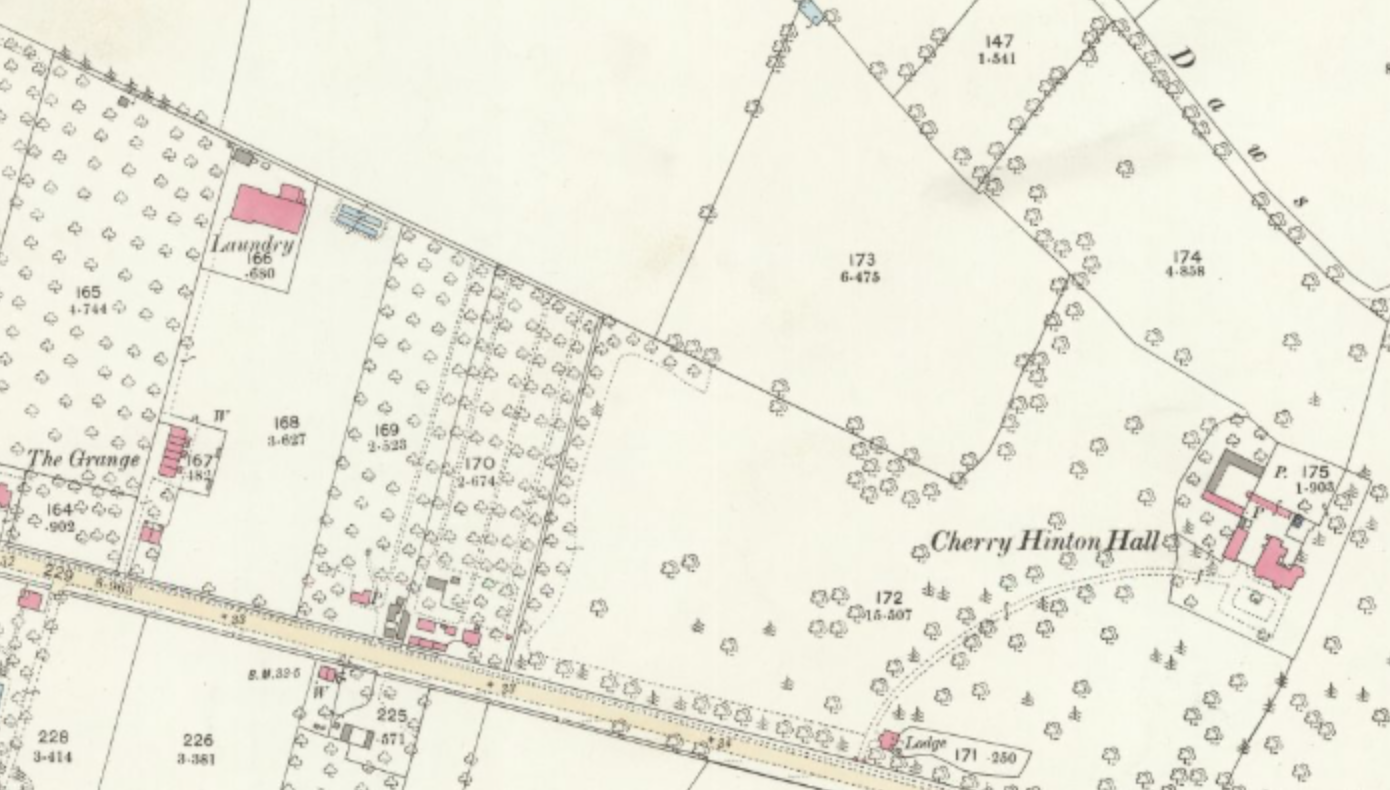
OS 25" 1888 (surveyed 1885) Showing the site of the newly established Cambridge Steam Laundry with its drying field and lane leading to the workers houses (left side of the picture above - Cherry Hinton Hall is shown to the right side of the picture above with Coe's Market Garden Farm (Lime Tree Farm) in the centre with its orchards.
In August 1882 a complaint was published in the Cambridge Newspaper (see below) about the contamination of water. This matter soon seems to be resolved and no further public reports are made. It does help us identify the water source being used for the works. The article refers to an open ditch which ran at the back of the Steam Laundry building and although not visible above ground there today. You will note on the map above that there are two long water-filled troughs which must have been made for use by the laundry.
1883
The laundry continued with consistent, regular advertising for business in the newspapers. You'll see from the advert below that the offices have now moved from No. 2 Alexandra Street to No. 5 and that the manageress of the laundry is Miss Daniel.
1885
By December 1885 the manageress is Mrs Pratt. The advert below also describes the laundry site a little more by mentioning the "Spacious well ventilated sorting, washing and ironing rooms and an extensive meadow for drying ground"
1887 By May 1887 we start to see the first of many sponsorship adverts between the Steam Laundry and Reckitts Blue. You can read more about Reckitts Blue at the 'Old and Interesting' website here: http://www.oldandinteresting.com/laundry-blue.aspx These sponsored adverts linked between the manageress of the Steam Laundry and Reckitts continue for many years and appear in adverts all over the country, providing a great deal of coverage and promotion for both parties. 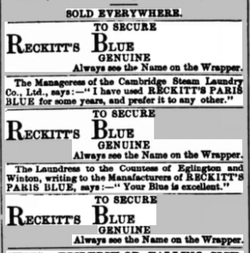 Richmond & Ripon Chronicle - Saturday 07 May 1887 - British Newspaper Archive. Richmond & Ripon Chronicle - Saturday 07 May 1887 - British Newspaper Archive.
1888 Kelly’s Directory:
Steam Laundry Co. Limited (Josiah Chater, sec.) 5 Alexandra Street; works, Cherry Hinton
1889
In 1889 we get the first look at the Cambridge Steam Laundry Company's logo in an advert placed in the Cambridge Independent Press. You'll also see that Mrs Pratt is still the manageress and Josiah Chater still the secretary.
1890
In the financial papers and financial sections of general newspapers continuing information about the share prices of the company are given regularly over the years.
In the 1890s there were newspaper adverts for more workers needed at the laundry, which provided employment for local people.
1891
The first full record of the people who worked and lived on-site at the new laundry is in 1891. The 1881 census was taken before the Steam Laundry was opened so there are no details for it for that year. The 1891 census shows 7 households living at the laundry site. James Pratt is listed as the manager along with his wife Annie Pratt who is the manageress. The remainder of the families appear to be housed due to the wives working at the company. On the OS Map (25" 1888-Surveyed 1886) you can see a terrace of 6 cottages down Laundry Lane and 2 separate semi-detached houses set back, facing Cambridge Road (Cherry Hinton Road) - it is not clear if these last 2 houses are part of the laundry houses. However, the 1901 Census lists two households (with the laundry manager & family living in one and the laundry Carman & family living in the other) as being on Cambridge Road and the rest are called Laundry Cottages Cambridge Road. It would make sense that the manager/s would have higher-grade houses, separate from the main workers.
1891 Census
Laundry – 1. James E Pratt Head M 35 Laundry Manager – Norfolk Old Catton Annie A Pratt wife M 31 Laundry Manageress – Loughton Essex Grace A Pratt daughter 6 Scholar – Cherry Hinton Daisy M Pratt daughter 4 – Cherry Hinton Fred Thomas Pratt son 10 months – Cherry Hinton Mary Ann Pratt mother widow 55 – Brook Norfolk Keziah Read servant single 14 Domestic Servant – Petersfield Hampshire Cambridge Road Laundry – (Cambridge Road is Cherry Hinton Road today) 2. John Osbourne Head M 67 Farm Labourer – Great Wilbraham Cambs Ann Osbourne wife M 64 Laundress – Little Wilbraham Cambs Annie McDonald Boarder 46 widow Laundress – Hanover Square St George London 3. Wilfred Freeman Head M 38 General Labourer – Royston Cambs Jane Freeman wife M 38 Laundress – Cherry Hinton John Henry Fuller step-son s 15 General Labourer – Cherry Hinton Sidney Fuller step-son 8 Scholar – Cherry Hinton 4. Isaac Read Head M 48 – Cherry Hinton - Buckworth Hants *Defective eyes* Elizabeth Read wife M 46 Laundress – Walworth Surrey Annie Read daughter s 18 Packer and Sorter in Laundry – Worcester Park Surrey Jessie Ann Read daughter s 16 Packer and Sorter in Laundry – Worcester Park Surrey Mary Elizabeth Read daughter 12 Scholar – Petersfield Hants May Read daughter 10 Scholar – Petersfield Hants 5. George Patten Head M 30 Carman – Cherry Hinton Jane Patten wife M 26 Laundress – Cherry Hinton Percy George Patten son 2 – Cherry Hinton 6. Arthur Nightingale Head M 34 General Labourer – St Andrew the Less Cambridge Sarah Anne Nightingale wife M 35 Laundress – Thriplow Cambs Julia L Nightingale daughter 6 Scholar – Cherry Hinton Arthur George Nightingale son 5 – Cherry Hinton Ernest H Nightingale son 2 – Cherry Hinton Emily Ann Benstead Servant s 12 Domestic Servant – Swaffham Prior Cambs 7. Margaret Daniels Head widow 53 Living on own means – Edinburgh Scotland *In 1891 the secretary of the Steam Laundry, Josiah Chater and his family - including Augustine Chater who would later take over the role from his father as secretary of the Steam Laundry - lived in Hartington Grove, off of Hills Road Cambridge*
1892 Kelly’s Directory
Steam Laundry Co. Lim. (Josiah Chater, sec.), 5 Alexandra st
In February 1892 the newspapers reported on the death of a well-known Cherry Hinton man, one of the Pamplin Brothers of the Steam Engine fame, who had a steam engine works in Cherry Hinton at the junction of Coldhams Lane and Cherry Hinton High Street.
Eliab Wright Pamplin died as a result of an accident, in which it was believed that he fell from the loft of his stable. The report notes that "Mr Pamplin was for some years Manager to the Cambridge Steam Laundry Company". We know that Mrs Pratt was still manageress in 1899, it is not clear when Mr Pamplin was manager but Mrs Pratt still continued to be manageress for some years.
1893
 Cambridge Independent Press - Friday 14 April 1893 - British Newspaper Archive. Cambridge Independent Press - Friday 14 April 1893 - British Newspaper Archive.
1894
There were many steam laundry businesses across the country by the 1890s and many books were written about the processes, equipment and running of these establishments. The newspaper article below discusses the wages of the Cambridge Steam Laundry Company as a comparison.
The continuing adverts both for the business and for employees gives us useful pieces of information that we can use to build a picture of the machinery used, the jobs available and the workings of the Steam Laundry. Click on each below to expand them.
1896 Kelly’s Directory
Cambridge Steam Laundry Co. Limited (J. Chater, sec.) Cherry Hinton, Camb Steam Laundry Co. Limited (Josiah Chater, sec.) 5 Alexandra St. Cambridge
The following newspaper article from December 1899, gives a report on proprietors and employees of Steam Laundries and is extremely useful as it includes the Cambridge Steam Laundry in the listings, giving a list of names of people working there. - you'll see the error in the print calling Cherry Hinton 'Cherry Linton'!
1901 Census
Cambridge Road – 1. James C Pratt Head M 45 Laundry Manager - worker – Norfolk Old Catton Annie A Pratt wife M 41 Laundry Manageress -worker – Loughton Essex Grace A Pratt daughter s 16 Pupil School – worker - Cherry Hinton Daisy M Pratt daughter 14 – Cherry Hinton – Typist Pupil – Own account at home Frederick T Pratt son– Cherry Hinton Annie A Pratt daughter 7 – Cherry Hinton Rose M Pratt daughter 7 – Cherry Hinton Mary A Pratt mother widow 68 – Brook Norfolk Margaret Daniel mother-in-law widow 63 – Scotland 2. Arthur H Wolfe Head M 32 – Laundry Carman – worker – Cambridge Alice Wolfe wife M 33 – Little Wilbraham Rose Wolfe daughter s 13 - Cambridge Harold Wolfe son 8 – Cambridge Laundry Cottages Cambridge Road Cherry Hinton – 3. Ann Osbourne Head Widow 73 – Little Wilbraham Cambs Agnes M W Maloney niece m 33 Laundress – worker – London 4. Henry J Frost Head M 37 – Steam Laundry – worker – Cambridge Jane Frost wife M 38 – Laundress – worker – Great Easton Essex Christopher W Frost son 12 – Cambridge Montague H Frost son 10 – Cherry Hinton William H Frost son 7 – Cherry Hinton Henry J Frost son 5 – Cherry Hinton Robert G Frost son 1 – Cherry Hinton 5. Arthur J Case Head M 28 – Asylum Attendent – worker - Cambridge Ann Case wife M 26 – Silverstone Northants 6. Frederick E Coe Head M 27 – Waterworks Stoker – worker – Cambridge Ellen Coe wife M 30 – Teversham Ellen E Coe daughter 6 months – Cherry Hinton 7. William Tingery Head 33 Foreman & Coal Porter – worker – Wheathampstead Herts Minnie Tingery wife M 32 – Cambridge Frances Tingery daughter 10 - Cambridge William E Tingery son 8 - Cambridge Dorothy Tingery daughter 1 – Cambridge 8. Arthur Nightingale Head M 44 – Brewers Labourer – worker - Cambridge Sarah A Nightingale wife M 45 – Laundry Worker – worker – Thriplow Cambs Julia L Nightingale daughter s 16 – Laundry Worker – worker – Cherry Hinton Arthur G Nightingale son 15 – Whitesmiths Assistant – worker – Cherry Hinton Ernest H Nightingale son 13 – Errand Boy – worker – Cherry Hinton William M Nightingale son 6 – Cherry Hinton 9. Frederick Bowles Head M 30 – Coal Carter – worker – Fulbourn Cambs Mary A Bowles wife M 28 – Whittlesford Cambs Frederick Bowles son 2 – Cherry Hinton Redvers Bowles son 6 months – Cherry Hinton Pretoria May Bowles daughter 6 months – Cherry Hinton *In 1901 the secretary of the Steam Laundry, Josiah Chater and his family - including Augustine Chater who would later take over the role from his father as secretary of the Steam Laundry - lived in Hartington Grove, off of Hills Road Cambridge*
Extensive regular advertising continues for the Steam Laundry in the local newspapers, again providing us with interesting clues and information about the business.
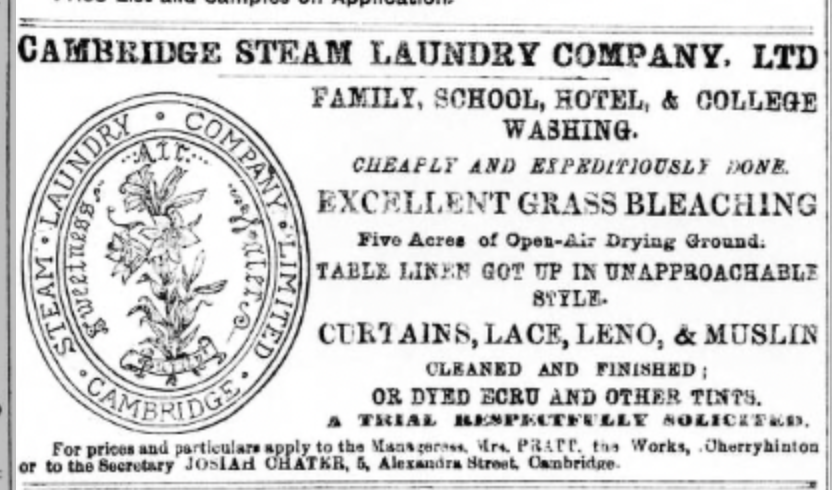 Cambridge Independent Press - Friday 08 November 1901 - British Newspaper Archives. Cambridge Independent Press - Friday 08 November 1901 - British Newspaper Archives.
1903
In 1903 the Cambridge Steam Laundry opened new Offices at 84 Regent Street Cambridge.
1904
With continued drainage of the land and management of the various streams crossing the fields to the west of the Steam Laundry, development continued across the western parish of Cherry Hinton, along Cherry Hinton Road towards Hills Road, which was known as 'New Cherry Hinton'. With the growing number of new houses, streets and shops, a new laundry called The Swiss Laundry, was built on the higher ground further to the west. The Swiss Laundry was founded in 1904 by Mr Chapman and Mr Goundry on the former site of a tannery. It offered a Swiss finish to table linen. This new laundry was to be in direct competition with the Cambridge Steam Laundry. It is worth further research to see what effect this event had on the Cambridge Steam Laundry share prices. As a result, the advertising campaign for the Cambridge Steam Laundry went into overdrive with many repeated and varied advertisements being placed in many local publications and newspapers. Some are shown below - click on each to open them fully.
1907
By 1907 Cambridge Steam Laundry had progressed from donkeys/horses and carts to including tricycles for their collections and deliveries.
In 1907 Cambridge Steam Laundry worker, 16-year-old Montague Frost, was involved in a serious cycling accident whilst riding a Steam Laundry carrier tricycle laden with linen.
1909
The advert below shows that things must have continued to go well for the Steam Laundry despite the competition further up the road, this was in part probably due to the sheer amount of new development leading to a decent number of customers going around. It's also worth noting that despite opening the new offices in Regent Street, the office at 5 Alexander Street was still in use.
In February 1909 drama unfolds with a robbery at the Steam Laundry premises. This is then reported in several newspapers across the country as well as locally.
Along with adverts seeking new staff the Steam Laundry continues with its regular advertising but is now able to include a phone number for the first time.
1911 Census - Cambridge Road now called Cherry Hinton Road
Mary Ann Oakman wife 23 – Laundry Hand Steam Laundry – worker - Cambridge Henry William Oakman son 6 – Scholar - Cambridge
Annie A Pratt wife 51 – “ “ “ “ – Laundry Manageress -worker – Loughton Essex Fredrick A Pratt son 20 s – Clerk Government Telegraph – worker – Cherry Hinton Annie A Pratt daughter 17 s – Cashier Café – Cherry Hinton Rose M Pratt daughter 17 s – Teacher (Pupil) School – Cherry Hinton Harrold G Daniel brother-in-law 45 s – Journalist – at home – Loughton Essex
Elizabeth Wolfe wife 38 M “ – Laundry Ironer Steam Laundry Company – Chesterton
Annie Coe wife 38 M – Dressmaking – own account, at home – Compton Devon Arthur Coe son 9 – School – Cherry Hinton Annie Coe daughter 6 – School – Cherry Hinton
Jane Frost wife 49 - “ “ “ - Essex Christopher Frost son 21 s – Labourer to Carter – Cherry Hinton Montague Frost son 20 s – Labourer to Carter – Cherry Hinton William Frost son 18 s – Farm Labourer on Land – Cherry Hinton Harry Frost son 16 s – Farm Labourere on Land – Cherry Hinton Robert Frost son 11 s – School – Cherry Hinton Sidney Frost son 8 s – School – Cherry Hinton
Emily Patten wife 28 M – Trumpington Rose Patten daughter 7 – School – Cherry Hinton Frederick Patten son 4 – Cherry Hinton Sidney Patten son 4 – Cherry Hinton Maude Patten daughter – 3 months – Cherry Hinton
Emily King 30 M – Laundry Maid Steam Laundry – worker – Arlesey Beds
Olive Harriet Miller wife 47 M “ “ “ “ – Forewoman Laundry – worker – St Pancras Islington William Frederick George Miller son 11 – School – Wood Green Middlesex Robert Rick Miller son 8 – School – Wood Green Middlesex
Sarah Ann Nightingale wife 55 M – “ “ “ “ – Laundry Ironer – worker – Thriplow Julia Louise Nightingale daughter 26 s – Laundry Ironer – worker – Cherry Hinton Arthur George Nightingale son 25 s – Whitesmith – worker – Cherry Hinton Ernest Henry Nightingale son 22 s – Wheelwright – worker – Cherry Hinton William Mark Nightingale son 16 s – Under Gardener – worker – Cherry Hinton
Mary Ann Bowles wife 38 M “ “ “ “ – Whittlesford Cambs Dorothy Bowles daughter 13 – School – Cherry Hinton Frederick George Bowles son 12 – Cherry Hinton Redvers Bowles son 10 – Cherry Hinton Pretoria May Bowles daughter 10 – Cherry Hinton *In 1908 Josiah Chater died, the role of secretary to the Steam Laundry Company most likely fell to his son Augustine Chater at this date. In 1911 Augustine was living in Hartington Grove, off of Hills Road Cambridge*
1912
In 1912 we find the first mention of the use of motorised vehicles for the Steam Laundry.
1916
By May 1916 the effects of the First World War on businesses were being felt and a claim was placed by the Steam Laundry to hold on to their key worker, William Henry Wenham, rather than him go off to war, stating that if he were to go, they would probably have to shut down. We can see from the newspaper report below that the Steam Laundry was engaged in army work by the washing of army blankets.
1918
Throughout 1917-1918 the Steam Laundry places less of its regular weekly newspaper adverts for business and instead, there is a constant stream of weekly adverts places requesting staff for various jobs. The advert below, for example, states that a war bonus is included.
In July 1918 we can see that William Henry Wenham was granted another 3 months' extension to continue working at the Steam Laundry rather than be sent of fighting. This must continually be requested.
1923
For a few years after the war there were quite a lot of newspaper adverts placed for job vacancies at the Steam Laundry but no real regular adverts for business like there had been before the war. In 1923 we find the following newspaper notice which discussed one of the Steam Laundry cottages. We can see that the office at 5 Alexandra Street was still in use and that the manageress was now Annie Wheeler.
1925
In January 1925 Mr Rutter dies and the newspaper obituary states that he was a director of the Cambridge Steam Company.
1933
In 1933 another break-in at the Steam Laundry occurred with an interesting tale of how the culprit was caught!
The full tale unfolds in March 1933 in the trial report given in the newspaper, which you can read below - click on each picture in turn to see the full details!
In the report we discover that Edna Fisher, who gives evidence in the trial, is Chief Clerk of the Steam Laundry. Saffron Walden Weekly News - Friday 10 March 1933 - British Newspaper Archive.
In the end, at sentencing, Thomas Spriggs was found not guilty.
1935-36 Cambridgeshire County Directory
Cambridge Steam Laundry Co. Ltd. Receiving office 4738 Works 87548 Chater, A. B. A.C.A., F.C.I.S., secretary Cambridge Steam Laundry, Cherry Hinton road and 54 Regent Street *Augustine Barrett Chater was Josiah Chater's son*
1937
The following newspaper notice shows that the laundries are working together - how this worked in practice and affected the public ownership of the Cambridge Steam Laundry is not clear and would merit further research.
In 1937 we find the first general business advert in many years for the Steam Laundry. It is much plainer than those that they used to publish before the war, and you'll note that there is now a new phone number for the Steam Laundry.
1938 The Blue Book Cambridge Directory
Cambridge Steam Laundry Co., Ltd. Cherry Hinton meadows. 87548 Cambridge Steam Laundry Co., Ltd. (Chater, A. B.), 54 Regent st. 4738
By 1938 Kelvin Close was laid out to the immediate west of the Steam Laundry and the houses were built just before the war.
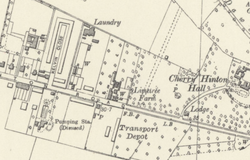 OS 6" surveyed 1935 published 1945. OS 6" surveyed 1935 published 1945.
1939
A very sad tale appeared in the newspaper in August 1939 which tells of the suicide of Francis Cort Carpenter, Manager of Cambridge Steam Laundry. You can click on each of the pictures below to read more.
With the outbreak of World War Two the Steam Laundry business was once again affected.
1946
I visited the Cambridgeshire Archives at Ely to look at the records that they hold for the Steam Laundry at Laundry Lane. They hold a set of building bylaw plans which I was able to photograph. Cambridgeshire Archives Reference: KCB/2/SE/3/9/14843 Building byelaw plan and approval for alterations and additions to laundry, Cherry Hinton Road (Cambridge Steam Laundry) 11th Feb 1946.
Cambridgeshire Archives: KCB/2/SE/3/9/14843 Building byelaw plan and approval for alterations and additions to laundry, Cherry Hinton Road (Cambridge Steam Laundry) 11th Feb 1946.
I sent Penny the plan which showed the houses on the Steam Laundry site, and she kindly highlighted in yellow, which house used to be theirs - see below:
"I was pleased to see that the well was marked on the plan, it was practically in our back garden! It's a shame that the Lane is in such a mess now.....On the attached plan that you kindly submitted I have highlighted our cottage and we resided there circa 1952-1962."
1948
1962
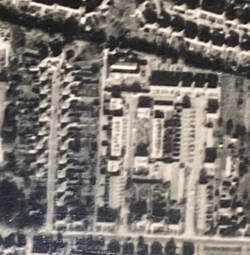 c.1962 Aerial view showing the newly built Derwent Close over the drying meadow with the Steam Laundry still reachable at the rear, via Laundry Lane - Fairley Surveys c.1962 Aerial view showing the newly built Derwent Close over the drying meadow with the Steam Laundry still reachable at the rear, via Laundry Lane - Fairley Surveys
1954
From around 1950 the Cambridge Steam Laundry had begun a new service of Dry Cleaning and had begun its advertising campaign by 1954 Perhaps this was in part because it had now lost its traditional drying ground to the new houses. For several months there were many newspaper adverts placed to call for new employees at the Steam Laundry, in the 'Dry Cleaning Department'. Mrs B Jackson & Co. 3 Regent Street, was one of the first businesses in Cambridge offering Dry Cleaning from 1900 onwards. The Swiss Laundry had also offered dry cleaning since its opening in the early 1900's.
1962 In 1962, during the last years of the laundry, Mr H Dorcey of Cambridge Steam Laundry represented on the East Anglian Council section of the Institute of British Launderers. 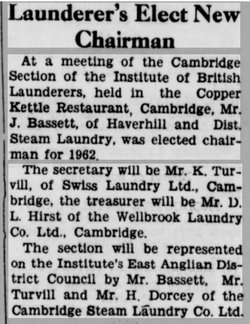 Haverhill Echo - Saturday 24 February 1962 - British Newspaper Archive. Haverhill Echo - Saturday 24 February 1962 - British Newspaper Archive.
In the same month of February 1962 Cambridge Steam Laundry changed its name and became the Cambridge Laundry and Cleaners Ltd with Mr Dorcey identified as the general manager. The company then takes over another laundry - The Coldham Model Laundry - bringing along a few of its staff.
1969
In August of 1969, the end of the 88-year history of Cambridge Steam Laundry was coming to an end. The name had been changed in recent years, but the business did not last much longer. The remaining premises and land were listed for sale by direction of Lyndale Laundries Ltd.
By October 1969 the public auction sale of the site had been withdrawn, citing the reason that the site had been sold by private treaty.
The mystery surrounding this sale was noted in a newspaper article the following year. It seems that after the private sale of the land in October 1969, the business had carried on for almost another year under its name of Cambridge Laundry and Cleaners Ltd, which had been owned by Mr W Shaw. It soon becomes apparent that the Swiss Laundry had taken over the Cambridge Laundry business. The Cambridge Steam Laundry, albeit with a new name change, finally closed for good on the site it had occupied for 89 years.
Today the Cambridge Steam Laundry Buildings are all gone and in their place is a new housing development called Brothers Place. Laundry Lane remains as a rough road now leading to a dead end.
You can download a PDF copy of Michelle's History of Cambridge Steam Laundry Company and Penny & Nicks article for free, by clicking on the buttons below.
Please do feel free to get in touch if you would like to add anything to this story or if you have any further information on the Cambridge Steam Laundry.
If you'd like to support the work that I do and the archive, why not buy me a virtual coffee or make a one-off donation at PayPal, I'd be really grateful and it will help keep me going! Just click on either of the buttons below :)
Suggested further reading and research:
Books that are worth reading on the subject: The Steam Laundry and its Methods - Charles A Royce How to Successfully Operate a Steam Laundry - Caleb David Patterson (Classic Reprint) The Steam Laundry. Its Construction, Equipment and Management - Taylor, John. (Consulting Laundry Engineer) LAUNDRY MANAGEMENT. A Handbook For Use In Private And Public Laundries - Editor of "The Laundry Journal" A Manual Of Modern Steam Laundry Work 1912 - Ellis Clayton Steam Laundries: Gender, Technology, and Work in the United States and Great Britain, 1880-1940 - By Arwen P.Mohun (Baltimore, Johns Hopkins University Press, 1999) Further Suggested Archives and Records to Consult: Cambridge University Library: Laundry books, 1956 - 1968 Reference Code: GBR/0265/UA/BG 18 Scope and Contents Record laundry taken in and money paid. Several of the books in this series were used concurrently. Dates: 1956 - 1968 Conditions Governing Access: From the Fonds: Among the archives of the Botanic Garden, personal records are closed to scholars for 80 years from the date of creation under data protection legislation. Restrictions are clearly indicated in catalogue entries. Found in: Cambridge University Library / GBR/0265/UA, Cambridge University Archives / Teaching, learning and research records / Archives of the Botanic Garden Personal diaries: Volume 39 (loose inserts), 1930 Reference Code: GBR/0271/GCPP Tillyard 1/1/39a Scope and Contents Photograph of AT with ? Agatha at St Anthony-in-Roseland in Cornwall; also press cutting re a carol concert given by the Perse School at the Cambridge Steam Laundry works. Dates: 1930 Found in: Girton College Archive / GBR/0271/GCPP, Personal Papers / Personal Papers of Aelfrida Tillyard / Personal and biographical records / Personal diaries, 1897-1959, together with documents formerly contained loose in the diaries, 1868-1959. Personal diaries: Volume 50, 1935-11-01 - 1936-06-08 Reference Code: GBR/0271/GCPP Tillyard 1/1/50 Scope and Contents Oxford. Still at St Benedict's. Alethea also living in Oxford - frequent visits. Brief visit to Cambridge - resigns directorship of the Cambridge Steam Laundry. Continued illness: goes to a nursing home in Torquay in Jan. 1936. March 1936 - has an operation then convalesces at the Convent of the Holy Trinity. Otherwise this volume contains largely description of the contemplative and religious life - occasional comment on the world, eg the situation in Germany. Discussions with Father Cary,... Dates: 1935-11-01 - 1936-06-08 Found in: Girton College Archive / GBR/0271/GCPP, Personal Papers / Personal Papers of Aelfrida Tillyard / Personal and biographical records / Personal diaries, 1897-1959, together with documents formerly contained loose in the diaries, 1868-1959. + taking on her father's role as a director of the Cambridge Steam Laundry Ltd. Writing: 'Concrete' and 'Can I be a Mystic?' both published by Tillyard, Aelfrida Cambridgeshire Collection: The laundry of perfection Author: Cambridge Steam Laundry Co. Ltd Imprint: n.d. Collation: 4 p. ; 19 cm. Dewey class: C.27.2 Local class: C.27.2 Language: English Subject: Cambridge Steam Laundry Co. Ltd BRN: 1144480 Cambridge steam laundry, 80 Regent St and adjoining shops Imprint: 1907-1911 (circa) Notes: Indexes: Yes Dewey class: P.Stea.K0 B.REG.K0 PC.Lan.K0 Local class: B.REG.K0 Language: English BRN: 1024081 The Cambridge Steam Laundry, Cherry Hinton Road, Cambridge Author: Sales Catalogue Imprint: Cambridge, 1969 Collation: p.7 ; 35 cm. Notes: With map enclosed Dewey class: C.06 CABINET Language: English Subject: Cherry Hinton Road
0 Comments
Here you will find the complete contents of Cherry Hinton Memories Book One - if you haven't done so already, I would encourage you to take a brief look at the introduction page about these books first - which you can do by clicking the link here: Cherry Hinton Memory Books - Introduction
There are three books altogether and one separately written story - you can find the links to the other books and story by visiting the Cherry Hinton Memory Books Introduction page, mentioned above, or by searching the index (Categories) on the righthand side of this page or by using the search box on the right.
BOOK ONE
Book One “The Cherry Hinton Gang” Those Golden Years
Contains memories from: Mick Covill Bill Chapman Kay Smith Diana Lilley Ann Gentle Chris Kirch Gill Rapley Sue Gentle Ronnie Clark Tony Mason
Below you will find the full transcription of book one, copied as it is, with pictures of the handwritten stories to compare (and send me any corrections!). You can choose to read through it here or, for more detail, you can click on one of the names above to see their story individually and any extra pictures that I have added to illustrate their story.
Book 1 “The Cherry Hinton Gangs” Those Golden Years.
Mick Covill 4th Jan 2011
‘Yess’ .. I do hold Cherry-Hinton with a great love & fondest memories. I myself was not born in Cherry Hinton but was born and lived in Broad Street of East Road Cambridge, born in 14-Aug-39. Can only just remember the last part of the war air raid shelters and the Anderson shelter we had in the living room which we got under when the air raid sirens went off. My mum & dad moved to Cambridge when he got a job with Ralph Thompson as a painter. We then were offered a council house in either Trumpington or Cherry-Hinton but as the house in Fernlea Close were built by R. Thompson and the yard and offices were in Fernlea Close my mum & dad chose Cherry Hinton. We moved to Cherry Hinton when I was about 9 years old into number 6, the beginning of my life in Cherry Hinton. I always remember Bert Quinney’s shop just in the High Street. You used to go in like a dark cellar where they sold most things. They then had a house & shop front built at the front of Fernlea Close, where we used to do most of our shopping. Bert Quinney used to be the local Bookies runner, and my dad used to give me some money wrapped up tightly in paper & say take this up to Bert’s. Bert who used to call me Billy - don’t know why – used to slip the money under the counter. If dad won any money he would send me up to Bert’s & I would say “have you anything for dad”. Bert would say “I will have a look” and then produce another bit of paper wrapped around money and say “here you are Billy” and slyly pass it to me to take back home. Bert Quinney’s shop was always open from early morn to late at night, he was a good man, friendly and kind. One of my early introductions to Cherry Hinton was when Kenny Sutcliffe, who I did not really know, wanted to have a fight with me and my brother John. If I remember we declined and ran home. My sister Marie and I went to the Catholic School in Cambridge, so we knew Ron Clarke and his family, also the noble family and the boys Peter George and Paul who lived on the High Street. Their father George was the bone collector from all the butchers. I suppose my introduction to the friendship that Cherry Hinton was to offer me was passing my 11 plus exam and going to the Central Grammar School. Here I met and was in classes with John Anderson, who lived in the prefabs in Church End, and Ray Williams or chick to most people who lived in Queens Meadows. Also, Tony Short who lived also in Fernlea Close. I used to do a paper round which was run by Jim Chapman, Bill Chapman’s uncle, I did Pen Close, Shepherds Close, Fishers Lane and worst of all, Fulbourn Old Drift. The drift was not very nice as it was very dark and everybody had guard dogs, which were not that friendly. Jim Chapman ran the paper business from the back room in the Chequers Pub run by Tony Tabor’s mum and Jesse his dad. The years slowly passed and there are memories of all the new families moving into Cherry Hinton i.e. the Medow’s family, the O’Reiley’s - Paddy, Patric, Phillip, Brendon, Fergie – very poor families. I used to go scrumping walnuts with Paddy in Chalk’s farm off the High Street and finished up with stained hands which lasted weeks. There was Jimmy Davidson, Mick Williams, who I think went to the County School also moved in. When recalling names there was a great friends Peter Boland & Mick Boland, who lived down Mill End Road with sisters Margaret & Liz, also Stan Paine who lived in Rosemary Lane. While I drift from name to name let’s not forget the Youth Club which was held in the old Cherry Hinton Infant School by the Labour Party members an old record player playing the latest hit songs and then the skifle groups who and about, and then the Youth Club held at the Lower Netherhall School and also the dances held in the British Legion Hall, Fishers Lane, where all the latest budding groups played. At these events all us Cherry Hinton boys and girls danced the night away and if I remember correctly no alcohol. Flashes come back to me now of the Queen Edith’s school dances where the lads would sit in one corner of the room reading in Cambridge Blue, a paper with all local football results and pictures. Must not forget my friend J Poulter who I met at Central School and I introduced him to the Cherry Hinton way of life and am sure he then made many, many friends. Down the Red Lion pub, run by Norman and Joan, we played darts and bar billiards and on a Sunday morning we all played football which could last up to 2-3 hours and then we would go to the Red Lion for a drink. Norman would have loads of orange drinks lined up for us all which quenched our thirst. Must not forget Cherry Hinton great such as Brian Stevens, Peter Dean, John Bertram, Danny Buttress, Mick Scoett?, Matt Lindsay. I think ... could go on and on and write page after page. The pages I wrote may not have been of historic or exciting events but a small glimpse of some of the people I met from school to growing up and can say Cherry Hinton is in my blood. I love it, maybe I love the past more than the present because it has changed so much. However, I thank all those people and friends who made my life in Cherry Hinton such a wonderful life. Yours Mick Covill
Bill Chapman’s Story Written 26/04/2011
I was born in Fisher’s Lane and then moved to Fulbourn Road when I was two months old. I went to school with my sister Shirley. We used to walk along a path which was called Long Walker (which started at Fulbourn Road and ran along the back of Cherry Hinton Rec where Colville Estate is now. How the High Street has changed! There used to be a cottage on the corner, opposite the Robin Hood (just outside the Spinney). An old man, Mr Clark lived there. In the Spinney, gypsies would often park and live there sometimes. At the junction of the Robin Hood there were no traffic lights as today, but a little slip road from Queen Edith’s Way to Cherry Hinton Road and then the other road went straight across to Cherry Hinton. There was a little triangle green in between where Mr Snowy Scott used to preach on a Sunday evening. Mr Scott used to grow his own tobacco. On the left hand side there was a big hole (where a bungalow is now), we used to sledge there (it was called Prior’s Field). Sheep were herded by the Creek Brothers from the Chalk Farm (off the High Street) to fields at the back of Fulbourn Road (near the water softener where the water company is now.) Next to the water softener there was a big barn where all of the wheat sheaves were gathered and stacked and threshed with a threshing machine. There used to be loads of rats and mice around there. There also used to be hare hunts that came through the village with all the hounds and then chase the hares at the back of Fulbourn Road. Taffy Lloyd (from Queens Meadows) was the local poacher. He would put snares out in Lime Kiln Quarry and you would see him coming home on his bike with rabbits across the cross bar. Percy Tabor was the nightwatchman at the chalk pits (where the caravan site is now). Luffy Tabor used to drive the steamroller through the village, and he was a great friend of my dad. Rarzo Tabor was the landlord of the Robin Hood. Dad, Luffy, Rocky Root and Tubby Anderson used to sing around the piano at Christmas at 56 Fulbourn Road (where we lived). There were two bakers: one in Fulbourn Road called Don Smith’s – the other one was in the High Street – Root’s Bakers. Then there was George Parish the butcher. Across the road there were two cottages next to the shop. There was another butchers opposite the rec (where the Building Society is now). Next to the Rec was Sid Hancock’s (the cobbler) shoe shop. Then the Chequer’s Pub run by the Tabors. Across the road from the Rec was Steven’s Building Yard where we used to keep the football marking machine. My dad (Olly) used to mark the football pitch. My dad was well known in Cherryhinton because he helped run the football club. My mum and dad were good parents. Next to Love Lane (where the bank is now) there used to be a smallholding with chickens and ducks in a field. Next to that was Chalks Farm (roughly where Desmond Avenue is now). There was a big drive where they took cows across the High Street to the field opposite. There was a big pond in the field opposite (roughly where Colville Road is now). Further on opposite Fisher’s Lane there used to stand a big tank filled with water. On the corner of Fisher’s Lane, I used to go to Chapel with my sister Shirley. We would be dressed in our Sunday best. Next to the Chapel (towards the railway line) were a row of 4 cottages (only 2 now) and then a police house. This was occupied by Mr Laddington who was the village copper at the time. Mr Bartram was the crossing man who was in charge of opening the railway gates (he was the father of my friend John). Just over the railway was the green hut where we went to youth club and played table tennis. Neville Cullup was a very good table tennis player. The school next door in an old building which has now been pulled down. Tommy Bray was the headmaster and he lived in a house next door (next to the Green Hut). Just across the road was the Five Bells pub and Quinney’s store where I used to buy my sweets. B.C.
Memories of Cherry Hinton from Kay Smith
I lived in Mill End Close until I was 17 years old. I think we were all very lucky to have lived in such a small safe community. In Mill End Close most of our parents were married just before the war and as was usual most of our mother’s either didn’t work or had part time jobs – unlike today. My parents bought the house when they married in 1939 and my mother’s 1st cousin bought the other half of the semi so I was fortunate as an only child to have 4 cousins next door, namely Cynthia, Charlie, Diana and David Lilley. Diana being 3 weeks younger than me, Chris and Lorna Ketch, Ann and Sue Gentle, John and Christine Cornell and John and Peter Hedge, all similar in age lived in this great little cul-de-sac. We all went to the village school together, walking safely through the village without parents coming with us. We had Miss Wilson in reception class – with orange juice, cod liver oil and malt. Plus, the small bottles of milk, which in winter we stood beside the large ‘turtle’ heaters to defrost the ice. We had Miss Rush in the second class and I remember her saying as we left the class that we had to leave the bead frames behind but take our fingers with us. I think it was on Friday mornings in assembly that we heard a record played but I only remember the Flight of the Bumble Bee and Finigal’s Cave. Perhaps they only had 2 records. I also remember Jeffrey Rheimen singing Greensleeves – he must have been good or brave! We had some sad momentous occasions when Mr Bray died and also when we were in Miss Dunnetts class someone came into class and whispered in her ear and she announced, “The King is Dead”. There was a great celebration on the Rec for the coronation and everyone dressed up in fancy dress. I was a black cat. I also remember watching the hunt leaving from Chalk’s Farm – an amazing sight. We used to go to Ling’s sweet shop opposite the school, and buy packets of crisps from Smith’s shop with the salt in the blue paper and hot bread from Root’s – all in the High Street. Our favourite play areas were the Spinney, catching sticklebacks in the brook – and falling in. I went to church on Sunday mornings and then to the Baptist Chapel for Sunday School afternoons. The vicar was Fatten Forrest who drove an amazing car and used to bring carrots to school for us to eat in a wheelbarrow. He always seemed very shy but was very kind to me. When I went to see him about getting married in the church but no longer lived in the parish he suggested I use a different address – so my marriage certificate gives Ann Gentle’s address and the Gentle’s very kindly let me get ready and leave the from their house.
Cherry Hinton Childhood – Diana Lilley
As Kay has said, I also lived in Mill End Close, my parents bought the house in 1938 and my mother lived there until she died in 1995. They were truly very happy days, the whole of the Close very good friends – always helping one another out – I remember in the summer all the mums and dads loading up old prams with games and equipment and food, and we would walk over Lime Kiln Hill to the Beach Woods – We would spend the whole day there playing rounders, cricket etc. using the trees as our posts. The parents would light fires and perhaps cook sausages etc. on to eat. We used to have a great time, and then again walk home. We were always very safe having games in a very wide area, and never any fears hanging over us. Kay also mentioned memories of Junior School, many of which I can remember. One thing Kay did not mention that I remember, was when we heard our 11 plus results, we individually went into see Mr Farmer, as it was then, and told our results. From school we were taken to Coldham’s Common swimming pool in our final year to learn to swim whatever the temperature in an unheated pool. Thereafter I would spend many days there at the cost of One Penny for the whole of the day. Playing in Cherry Hinton and spending a lot of time in the Spinney. I remember walking to the Robin Hood corner and seeing the patients from Fulbourn Hospital out for a walk. They were all tied together and were resting on the wall outside the Robin Hood Public House, before walking back. I found this very frightening. I could have been no more than 10 when Kay and I decided we would cycle to Balsham, which was a fair way. On arriving at my great aunts who had a farm, and I loved to visit – apart from the outside loo – (a shed with a wooden seat – with a hole in it). She said “Does your mother know where you are”, well as we said “No, why, should she, we are quite safe” – to which she fed and watered us and sent us home. I went to Cherry Hinton Church with my brothers and sister on a Sunday and continued on to confirmation classes in the vicarage with Mrs Forest. The vicarage was a very large rambling house – we used to sit in one of the rooms for our class – and the ceiling was peeling off on to us. It always caused quite a laugh. Needless to say I did get confirmed in 1956 at St Pauls Church on Hills Road, and I did get married in Cherry Hinton Church in 1964. When we were old enough, I delivered papers for Mr Seal – both morning and evenings, before and after school daily and on a Saturday I worked for Mr Bird the greengrocer in the new shops in the High Street when Colville Road was developed. As mentioned previously in this book, I also had to deliver to Fulbourn Old Drift – a very dark and not a very nice place to be in the dark mornings and evenings, likewise, the caravan site on Bennett’s Farm, Mill End Road. I often had to get my dad to come with me. Coronation year 1952, Kay’s family were the first in the Close to have a television and I remember each family having a time slot in which to go around and watch the occasion. They also had a motorbike and side-car which I remember being taken in when I was 11 to fetch my first pet dog Mick, and I also married a Mick! There are many things in this book already that I recall – the cycling through either the Tins or the Snakey Path to the secondary school and later on to work. Quinney’s shop open 7 days a week – when mums ran out of something on a Sunday – he would sell it to us – and then wrap it in newspaper to disguise what we had. It was illegal to sell certain items on a Sunday years ago. We were extremely lucky to have had our childhood in Cherry Hinton – we were well cared for and looked after. Very happy days. Several of us have flown the nest, but we still keep in touch regularly, for lunch and a chat – Kay Smith, Chris Ketch – Ann Gentle, Gill Fordham and myself. We are friends for life.
Cherry Hinton Memories Ann Gentle
I lived in Mill End Close with my parents and sister Sue – who is 3 years younger than me. We were a close-knit community only 22 houses in the Close, and all the children played together. I went to the village school and was in the same classes as Vic Phillips, they were happy days. I remember us giving Mr Reed? our class teacher the bumps on his birthday, he took it all in good sport, I remember going to Mr Ling’s shop and buying 1p OXO’s to eat as we could not buy sweets because of rationing. I still like them now. The summer holidays were great, we had the run of the village, going tiddler snatching in the brook, climbing trees on a ree?, many’s the time my dad would have to come and get me down as I got stuck up a tree. The Spinney was another favourite, my mum didn’t like me going up there but it did not stop me. My dad kept racing pigeons and Tony Tabour and many of the boys used to come and see them. Vic my dad went to Crystal Palace with your mum and doing the High Jump I think they went to the same school. 1927 was the years I think they would have been about 14 years old. The High Street was a lot different to what it is now, there were 2 farm cottages at the top of Mill End Close they belonged to Chalks Farm. The Jonson's lived in one of them. The farm was where the hunt used to go from, and we used to go and watch. In autumn we would scrump walnuts I have always liked them. opposite the farm there was a field with a pond. In the winter it would freeze over and we would skate on it. One day on the way to school I decided to have a go, the ice wasn't very thick and I fell in afraid to go home and tell my mum I sat in school all day in wet clothes. When I got home, someone had told mum she made me have a mustard bath to stop me catching cold. We used to go to parties in the Chequers pub they were great fun. I left Cherry Hinton in 1963 when I married J Holmes. We lived in Chesterton for many years and had two sons I now live in Landbeach. My son Kevin now lives in my home in Cherry Hinton having bought it when my mother died so the connexion still goes on as I come back home quite often. Ann Holmes
Some of my memories of Cherry Hinton – Chris Ketch
Our Cherry Hinton is unrecognisable from the one of today. There was only one pavement along part of the High Street, small gas street lamps and Chalk’s Farm on both sides. I remember a bull being in the field in summer and skating on the pond in winter. Twice a year the sheep were herded through the High Street, no traffic calming then, thank goodness. I too was a Mill End Close girl, living there for 20 years with my parents and younger sister Lorna. The Millers, Janet, Roger and Sally, lived 2 doors away, Jackie and Danny Buttreas? across the road and Les, Win and their son Richard “Bonzo” King next door. As the girls have said before, it was a safe, happy environment in which to grow up in. Everyone’s parents respected each other, the mothers calling each other Mrs, not using forenames and all extremely hard working. School was a good experience then. Mrs Runnett getting us to chant times tables in the tin hut, Mrs North playing her piano accordion and being flung around by the boys who hated dancing. We often played marbles after school, rolling them down the High Street on the way home. In the winter we made long slides on the ice and formed an orderly queue for a “go”. It was also where I met Gill Fordham, my very good friend who came to live on the “new estate”. She is an adopted Mill End Close girl now. The wonderful Bernard Reed was the best teacher ever. How he remembers us all I will never know. Sports days were a great occasion. The MC used to be Mr Thompson, Susan and Caroline’s father. Margaret Boland was a terrific runner, I did beat her once but only once. I remember Billy Taylor rolling one of the Richardson boys along in a huge tyre in one of the races. Gill and I came third in the three legged race on our last sports day. We won a comb each and we got a big cheer when we collected our prize and it felt like an Olympic medal. Summer holidays were long and the best ever. Groups of us would disappear all day in the Spinney, on the Rec or the Beech Woods. Sometimes we would club together to buy a hot loaf from Roots the bakers to eat on the Rec. If it was wet we would play Monopoly in Di Lilly’s dad’s shed, for hours on end. Church, Sunday School and Bible class was the plan for Sundays. We took a few pence for the collection but Lorna decided to pay a visit to Ling’s sweet shop sometimes and spent her collection money on sweets. Our mum found out when bubble gum stuck around her mouth. After Sunday morning service we would pick up an ice cream block from Quinney’s shop which he wrapped in newspaper. This was kept on the pantry floor as we had no fridges then. As teenagers we went to youth club in the school hall and the British Legion Hall in Fishers Lane where some good local bands played live. No alcohol or drugs then but we had a really great time without the need for either. Today, I live in Fulbourn where I see several old school friends. John Richardson works very hard in his woodyard at the bottom of my garden. Horace White is landlord of the Six Bells and lives near me. I also see Tony Mason around the village and Herbie and Marie Williams. All of them are still so friendly. Great memories of very happy days spent in Cherry Hinton. - Chris x
A New Life in Cherry Hinton – Gill Rapley nee’ Fordham
I came to Cherry Hinton with my parents Bill and Chris and my sister Margaret in 1952. We moved into one of the new council houses in Leete Road on the Colville Road estate. As newcomers we were not welcomed by all the villagers, some obviously thought this influx of strangers would change the life of this small community and not for the better! I well remember the terror of standing in the playground on my first day at the primary school next to the level crossing and knowing absolutely no-one. That school with its coal fires, outside toilets and overflow class in the Green Hut was, it turned out, a wonderful place of learning with headmaster Mr Farmer, teachers Bernard Read and Miss’s Rush and Dunnett who enabled many of us to pass the 11+ and move on confidently to High School and Grammar Schools. School holidays were spent in the Spinney, on the Rec, blackberrying on the Roman Road and exploring the Beechwoods. There were huge steam rollers in Pamplins Yard and Mr Fabbs equally huge pigs to feed in Fulbourn Old Drift. The Norman Cement Works along the Tins path was always fascinating with the huge cauldron of liquid cement constantly being fed by the chalk lorries from the pits in Lime Kiln Road. The Green Hut with Brownies, Guides, Cubs, Scout groups, youth club and table tennis club was our social centre. I learned to Jive there to Paul Anka, Everly Bros and Elvis and I also fell in love for the first time, all such bitter sweet memories. There were more pubs than shops when we first arrived but eventually Mr Seals newsagents, Mr Bowyers grocery shop and Mr Birds greengrocers augmented Bert Quinney’s and Lings sweet shop. The friends I made all those years ago thankfully remain my friends today – I see Chris, Kay, Di and Anne quite regularly and so many of “the boys” now spend their retirement on the allotments on the Black Land where Mary and I spend a great deal of our time. Cherry Hinton was a good place to move to in 1952 and it is still a good place to live in 2011 and I am thankful for it. – Gill
Sue Gentle March 2012 Mill End Close
My sister Ann (Gentle) brought this notebook of reminiscences to show me. Reading them made me want to contribute so here goes! I have lived in the Pennine Hills almost twice as long as I lived in Cherry Hinton but my memories of my happy childhood are vivid. As others have mentioned we were so lucky to have had the freedom to roam, climb trees, make dens, go on long cycle rides. We would run home at lunch time then rush out to play again. Or sometimes we would take picnics which meant we were away from home for hours. This did not cause any parental concern as it would have me with my children. As already mentioned by Kay, Mill End Close was a new build just before the war and most of the houses were bought by young newly married couples. Because of this a lot of children were born there, including us. As a consequence, we were never short of playmates. One of my first memories was of the close being flooded and having fun paddling in the road with our shoes on. The year before I started school Peter Hedge (who was one year older than me) broke his arm so was off school. He and I went up the Rec to play on the swings (yes, with a broken arm!) Whilst there a hunt passed by heading for what was then the fields beyond. We were so frightened by the noise the dogs made – we swang as high as we could to escape them. Now when I hear a lot of dogs barking I think of this. I remember walking to school with Christine Cornell and her pet chicken Billy. When we reached the level crossing we told Billy to go home, and it duly did. One day I took my little doll to school – she was my pride and joy. On leaving school some boys in my sisters year (was it you?!) took the doll off me and when it was returned it had one leg missing. I cried all the way home. The leg went missing by the level crossing. Because I was so upset my dad went to look for it in the dark with Mr Bartrum the crossing keeper. He had a paraffin lamp. The leg wasn’t found but the next morning my doll had a wooden leg carved by my dear dad. It was even more special to me after that. We loved to climb trees at the top of the Rec. How pleased I was with myself when I managed to get from tree one to tree seven without touching the ground. My sister got stuck up one of these trees and had to stay there until our dad came home to rescue her. I thought her a bit of a sissy! We learnt to do things on our own like riding a bike and swimming. The former by getting on by a bench seat on the Rec and by falling off when wanting to stop. The latter by spending much time at Coldhams Lane swimming baths which I remember as always being cold. It didn’t bother us though. I loved school especially Mr Read’s class. His classroom was of a wooden construction that was separate from the rest of the school, it was near the railway line. One day, when I should have been paying attention, I counted the number of freight coaches there were passing by. I hadn’t realised Mr Read had stopped talking and was looking at me. When he asked me how many coaches there were (I still remember there were 23) I had to write out 23 times “the goods train engine was pulling 23 coaches”! We had a great time in Mr Read’s class doing project work. One project I was involved in was a study of the flora and fauna in the Brook. This was an excuse to have fun! He would allow us to go to the Brook in project time and we would come back invariably late and wet having paddled too deep or fallen in. Imagine a teacher giving pupils that freedom now! How fortunate we were. Our parents had modest lifestyles but they gave us a very rich and secure upbringing in Cherry Hinton – Sue (Gentle) March 2012
Ronnie Clark 12-6-09
I remember in the 1950’s when Cherry Hinton had the best village football team in Cambridgeshire, and around the 1950’s when Cherry Hinton was a village, sadly no more. Farms up the High Street, Smiths bakers in Fulbourn Road. A piano playing all the old songs on a Saturday night in the Robin Hood. I remember the sheep being brought from Fulbourn Road down the High Street to Chalks Farm. Old Ken Baker riding side-saddle on the big Shire horse, chewing a bit of straw, delivering muck for the allotments behind Fulbourn Road. Those were the days. Walking to school from Fulbourn Road down what was classed as Long Walker (a path which ran from Fulbourn Road to Fishers Lane) before the council estate was built. And the other footpath which ran from between Fulbourn Road and the old Dutch barn over the hill to the Beech Woods. No longer there (but could be if the locals had it opened up). I remember Mr Ollie Chapman, 56 Fulbourn Road. He used to cut my hair for sixpence on a Sunday morning. If I did not keep still he would clip my ear. Oh those memeories. Catching rats and rabbits when they done the harvest, the foreman from Chalks Farm, Mr Dawson, could not catch us. I remember Bill Chapman, who I owe so much for what he did for me, and was one of those players along with Peter Dean, Brian Stevens who would be todays £50,000,000 football players who played with pride. I could go on and on. Always dreaming but the times have gone, two other men I must mention are Douglas Kitson, who was like a brother to me, sadly no longer with us, and Bill Taylor from the High Street who also I owe so much to. I was born in Fulbourn Road, no. 34. Nickname Nobby. Cherry Hinton, thanks for the memories.
Tony Mason's Tale (born.1-12-41) June 2012
Lived at 10 Railway Street next door but one to Nev Cullup in a road where everyone knew everyone with a real community spirit. Kelly Ling a good friend of my sister Ann lived about halfway along the long row as did Marglin? Bird, Rodney Smith, Andrew Tabour and Richard Hallam? We had wonderful bonfire nights in those days with everyone mucking in building the bonfire and pooling our fireworks and potatoes for roasting later. Nev who still works in the village as a cobbler in his mid 70’s needs a medal for he was struck with TB as a child which severely disabled him but he was brilliant with his model aero engines and later so good at table tennis. My memories of Cherry Hinton are really happy ones as it was such a wonderful rural village in the 1940’s and 1950’s and just a fraction of its present size. There were no houses between Fishers Lane and Jane Elwoods old thatched hut still stands next to the library, there was just a lovely meadow with cattle and horses grazing amongst daisies and buttercups but in the winter it flooded in its lower part to form a small lake on which we would float an old tin bath using a slab of wood as a paddle and when frozen it was brilliant for slides. In summer if the cattle were not using the field, it was used for a rounders or cricket pitch by the chapel the quality of the pitch being questionable, but we did have David Shepherd (yes the England cricketer) play on it. He and Bob Jones used to help out at the chapel whilst they were at Cambridge University and on Sundays they would stay with Joyce and Stuart Hill in Fishers Lane (Sue and Jane Hill’s parents), poor Jane had a hole in her heart and went through much surgery as a child at Guys Hospital in London, I think it was the early days of heart surgery. There were just a few houses in Fishers Lane with a field on the left hand side where they held the village feast after the war and just beyond this field Prefabs were built to help house families of troops returning. At the bottom of Fishers Lane, which was quite short, were large fields stretching across towards Fulbourn Hospital where as a young one it was marvellous to watch the old binder making sheaves of corn which were stacked to dry before being pitchforked onto carts some horse drawn and some by an early tractor pulling them back to Chalks Farm which had a beautiful avenue of walnut trees roughly where the chemist and bookies are in the high street. It had a grand old farm house, surrounded by fields to the front going up the hill as far as the railway and very large barns built of chalk blocks and timber. Mr Chalk was the auctioneer, Grain? and Chalk, later to become Cheffins. He also had land to the south of Fulbourn Road where he grew corn and in winter moved his sheep well up the hill in compounds of bales, when they first came out, where the shepherd had his living van, dog with horse and cart so he could keep a close eye on the lambing as it progressed. Behind Chalks Farm was a winding part of Mill End Road where the road followed the shape of the brook which ran open in those days, not in pipes as now. There were fields and stables where the wealthy of the University had their beautiful big horses kept which later became a riding school. Further down Mill End Road was Arnolds Farm which again had tennis courts to the side of a large farmhouse with lots of corn haystacks in the farmyard. A steam engine would arrive in autumn/winter to power the thresher which sorted grain from the straw. This farm had an ex-prisoner of war Hans working on it, he was a friendly chap who used to let us ride on the trailers up to fields to the north of Fulbourn Old Drift and to those near the cement works north of the railway. It was great fun and mum would get one to take a bag with me to glean the loose ears of corn for the chickens and straw for my rabbits. Mr Fabb (Doreen’s father) had quite a lot of pigs in a large shed in a small field on Fulbourn Old Drift where I used to go with him at feed time and when he was ploughing it was great to hitch a ride on his old Fordson tractor which ran on paraffin. Next door to us in Railway Street lived Ray Coustons grandparents. Rays father used to come in a large van and sometimes we would go to the colleges to collect the vegetable cast offs which after he had sorted out the better veg at his Fishers Lane yard he would take the rest for his pigs that he kept in Church End somewhere near where Listers old building used to be. Dr Stracham lived in the big house in Church End used to give us school children a real treat in the autumn term by bringing a whole barrow load of apples into the playground. Another real treat in those days was the strawberry teas they used to do on sports days. We would all sit at great long tables with white tablecloths in the playground like a street party. Back in the High Street was Lings shop just above the railway line on the corner of Railway Street. I always remember queuing in a really long queue on a Tuesday evening when they first had ice cream delivered. Between Lings and the old 5 Bells was nurse Armanents? thatched cottage, she was the District Nurse. Between the 5 bells and the old Quinney’s shop (the one you went down steps into) at the rear was a sizable house with Battlements and vast gardens and tennis court which was where Pamplins the steam engine contractors used to live. It was a large business for its day with engines out all over East Anglia. Nev Cullup’s grandfather Jim Fisher was Foreman and many of the workers were housed along the row in Railway Street. Luffey Tabour from Cherry Hinton started as a teaboy/cook for a steam engine gang and later drove engines for most of his life. He told me he would often be in the Lowestoft area for 6 moths at a time. The last steam engine I remember commercially working in Cherry Hinton was when I was quite young in the field north-east diagonally across from the church. When Wimpeys built on it dad always said it should never have been allowed because the land was left to the church for a further graveyard. No wonder there’s no room in the churchyard to bury people now. As a child I used to play in Orchard Estate with Martin Capon?, Teddy Harding, Ronnie Heywood, Dickie Pilsworth, Horace White, Peter Crabb. We used to go fishing in the brook in summer but I always remember Horace leading us through the village to meet a bus at the Robin Hood on which was coming the greatest den builder from Fulbourn (Rocky Root) who needless to say, after waiting for several hours, never turned up. But when he eventually moved to Cherry Hinton to live proved to be a great guy who still tends his allotment by the brook even though he now lives in Landbeach and has proved to be the best roof carpenter I have ever known. Many lovely people moved into Cherry Hinton with the new houses being built all around and the village seemed to have the greatest football team of all time, Brian Stevens left wing (Swavesey always put 2 men on him but he still ran through the pair of them), Peter Dean, Mick Cornish, Bill Chapman, Ron Hagaty, Sam Bartrum, Brian Merry, Bill Taylor, Jimmy Nunn, Winkey Wells, Tom Watson, Pete Bland and many more good players. They seemed to win everything. Brian played for Cambridge United then Leicester City he was outstanding the Beckham of his day to us young ones. In my early days a tramp would knock our door and ask for his dirty old paint tin to be filled with tea, another similar sort of chap but cleaner would come on a bike with a stand that raised his wheel so he could pedal and drive a grinstone on which he would sharpen scissors, knives and shears. In Fulbourn Old Drift there was a small railway siding where a few railway trucks filled with coal would be backed onto for the local coal merchant to unlock by hand into sacks on his cart. Mr Doughty, who had a wooden leg, lived near the siding and worked for the railway trimming the wicks of oil lamps and filling them with paraffin for the railway signals. Doreen Tabour (nee Rowlings) who still lives in the row in Railway Street was relief railway gate lady. Mr Bartrum, John’s dad, was the resident gateman who lived in the old station house. The hunt in the old days which was quite a spectacle, normally left from Chalks Farm but on some occasions left from the Vicarage, the hounds I think came from Gingell? of Horningsea, they looked magnificent. Steven Bros Builders yard used to be next to Mr Bendalls old thatch which after a fire became the site of a garage but is now housing. The blacksmith shop, run by Kitch Gentle, opposite the Red Lion pub was the place to take glass accumulators to be charged for powering our radio as we did not have electricity, our lights were by gas or oil lamp. Upstairs at the back of the blacksmith shop was a beautiful picture with Springfield Farm on the edge of Cherry Hinton Road. There used to be another farm “Ventress” on the other side of Cherry Hinton Road just slightly along near the start of Cherry Hinton Hall, which again was burnt down for Harold Ridgeon (Sindals) to build more houses. At the top of Fishers Lane just on the High Street was Clintons big drying shed where washing was deposited for the village ladies to wash and iron for the University. Several houses in those days had washrooms in their back gardens just behind their house. It would contain a water filled copper heated by a fire below. Another large shed was at the back of the Steggles house in the High Street next to Joan and Bill Taylors house where tobacco would be dried. On the opposite side of the High Street was the Co-op Shop where later Freddy Reaverone? Was manager they had cables across the ceiling which took the money to the cashier, quite fascinating to watch as a child but the system seemed to hold up everyone because they had to wait for the cashier to process it and send it back the change in a little pot in a carriage zooming across the room against the ceiling – Hi Tek for its day I guess but slowed everyone down. In later days the Rec was enlarged to include where allotments used to be behind the Chequers Pub. There seemed to be a lovely croud of lads came to live in the village, Herbie Williams from Stotfold moved into Leete Road, John Anderson into the prefabs in Church End, he was a brilliant lad, he built such a good hi-fi system, I think he cast concrete into the base of a speaker cabinet he fabricated, the sound was so good that the whole prefab vibrated with the deep base notes. He was always up to something clever. I well remember the time when he made some metal tubes with a tiny hole for the fuse but with thread at the tube end which he would fill with chemicals from I think Jim Davidson which he would ask one to put a bolt at the end and gently tighten. It was nothing to see a massive branch blown off near trunk of a large tree with a horrendous bang as a test that it would work. Followed by PC Plod roaming the neighbourhood for the next few hours when we had to make ourselves scarce. But John’s father was very good at fobbing him off because PC Plod knew very well who had probably done it. I shall never forget the tremendous boom in the toilets (when they used to be underground) in the centre of Market Square) one Bonfire night, I’m sure it must have been heard halfway to Newmarket. I went with Herbie, Stan, John Poulter and others to learn to ride a motorbike at what was the old cattle market at the top of Cherry Hinton Road on Sunday mornings, it was a brilliant system where Hallens and Kings Harpes provided a bike for each of us to learn on off the road around the cattle market lane system. Needless to say we all got bikes which gave us the freedom to roam anywhere from there on. It was a wonderful time you could always tell when Stan was zooming through the village on his fanny barnet, it seemed the throttle only had one position. I remember Vics younger brother Gordon riding pillion on the back of mine whilst Vic was on the back of Stans, Gordon never realised he was going to fly as we took the railway gates going downhill at full throttle – happy days, we were the lucky generation, we had all the benefits of prewar tranquillity with orange juice, cod liver oil, chocolate and later milk at school each morning and in our teens, when most older lads would have to do 2 years in their National Service, which most thought was a waste of 2 years in their prime of life, even that was stopped just a year or two ahead of us. I think the last from the village who had to go were Sammy Bercham, who went into the RAF as did Paddy Reilly, what a smashing lad he was to come into the village with bros. Pat, Fergie and others in the family. Pete Noland I think was the last to go into the army, unless someone knows different. My dad Charlie was a bricklayer who worked until he was 74, quite a heavy job till that age, he would cycle all over as far as Girton but if he was working around town or nearer he would always cycle home at lunch times as well, people were really fit in those days with no cars to get about with. One of my fondest memories is of walking my son David, when he was little, to the cement works to watch the rotating machinery mulching the slurry to meet dad on his way home, David would sit on dads coat on his bikes handlebars with his feet in his basket, I think both of them were in heaven walking back through the Tins pathway. It was such simple things that gave such pleasure in those days, I can’t think of anywhere beter to have been brought up unless we were all living by the coast, maybe Bembridge I.O.W. (Isle of Wight) where Stan, Mick Colville and a group of us went for a holiday one year, before we had 4 chalets in a row at Skegness with a group of 16 of us another year with some of Vics United pals who joined the village lads at the Red Lion. We were a lucky generation. Tony Mason July 2012.
If you'd like to support the work that I do and the archive, why not buy me a virtual coffee, I'd be really grateful and it will help keep me going!
Just click on the green button below :) |
Cherry Hinton History Pages:
Contents If you'd like to go straight to a specific article or blog post within the Cherry Hinton History Page you can click on any of the post titles in the list below and it will take you directly there. Alternatively, you can use the search box above to search by keyword or you can use the index further below. About & how to use:This is the blog page for my articles, memories and archives relating to the archaeology and local history of Cherry Hinton, a village to the southeast of Cambridge UK. The area covered is the old Parish of Cherry Hinton which today includes the Ward of Queen Edith's. The Categories below are really the keyword index of what is on the Cherry Hinton History Pages. Each is a clickable link which will take you to an article or blog which contains that word or subject.
Categories
All
Archives
May 2024
|
||||||||||||
